How to have an epic North American trip without a car

Apr 14, 2021 • 9 min read

The Pacific Surfliner travels along the coastline in Del Mar, California. The Pacific Surfliner offers a unique vantage on the Southern California seascape connecting San Luis Obispo and San Diego through Los Angeles and Santa Barbara. © courtesy of Amtrak
With officially-designated scenic highways, big skies and wide open spaces, the USA practically begs to be explored by car. But despite America’s automobile obsession, a visit here doesn’t have to be dictated by one.
Sustainable travel is becoming a necessity instead of a nice-to-have, and whether you’d rather not drive for environmental reasons, personal preference or just don’t want to spend your vacation looking for somewhere to park, you might not realize that a wanderlust-worthy trip along the US west coast can still hit up many epic destinations car-free.
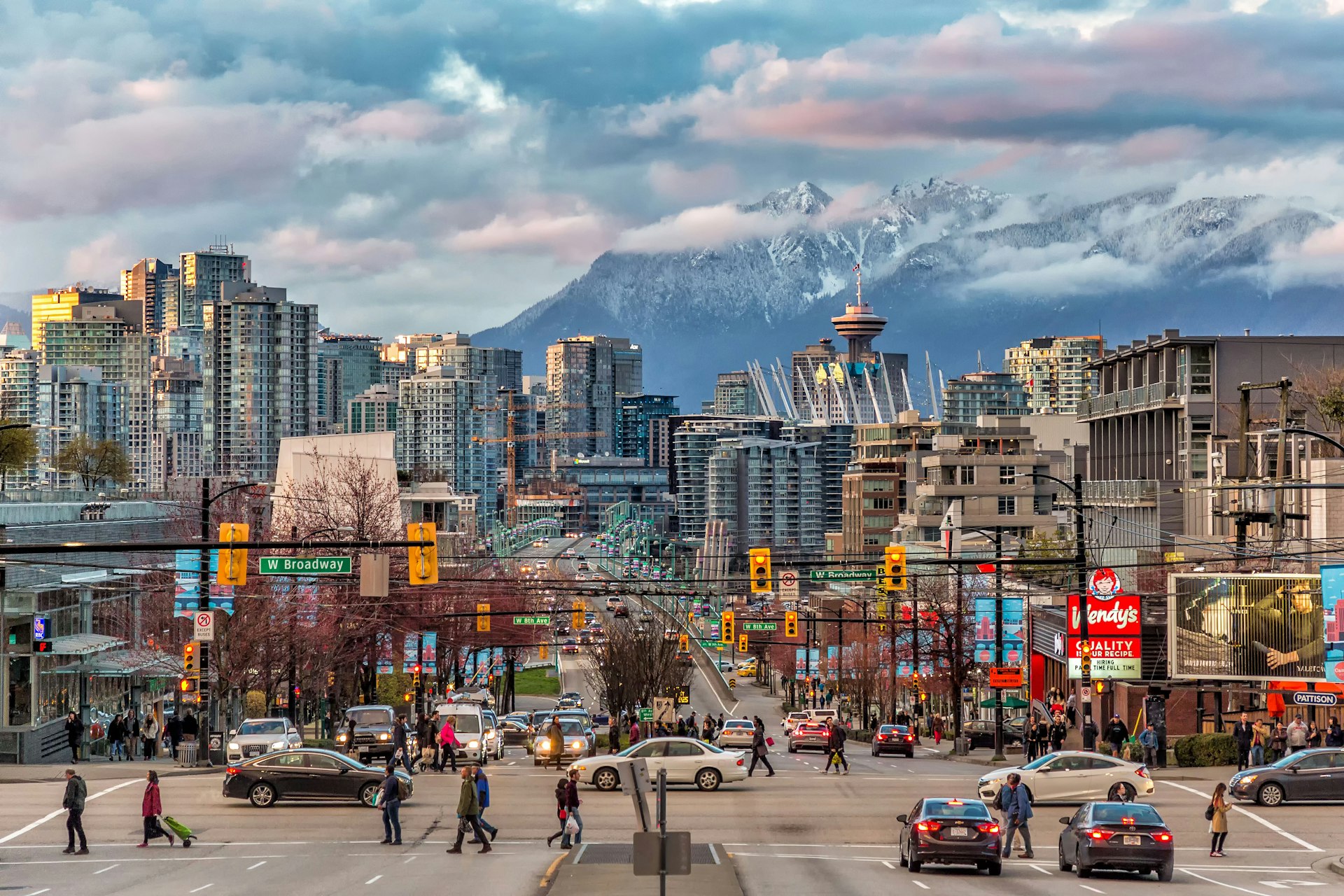

Vancouver, Canada
Long hailed as one of the most sustainable cities in North America , Vancouver is a delight to explore on foot, even when cloaked in mist. The seaside city’s West End is topped by the huge Stanley Park , a 150,000-tree urban rainforest that’s hemmed in by a 8.8km-long seawall . It’s an easy cycle with a rented Mobi , Vancouver’s public bike share scheme, past the First Nations totem poles and under the Brockton Point lighthouse. When it’s time to refuel, dig into the city’s amazing foodie scene with a stop at the stalls at Granville Island Public Market before moving onto Vancouver's fantastic breweries . The selection around Main St is particularly crawl-able: don't miss Electric Bicycle Brewing , Brassneck Brewery and 33 Brewing Experiment .
Where to stay in Vancouver
Canada’s first Indigenous arts hotel, Skwachàys Lodge , is a short walk or bus ride from Pacific Central train station. Rooms are stocked with eco-friendly toiletries, a ground-floor gallery displays beautiful Indigenous crafts, and stays support the Vancouver Native Housing Society social enterprise.
How to get between Vancouver and Seattle by train: Hugging Puget Sound for most of the journey, the Amtrak Cascades train runs twice a day between Vancouver and Seattle. It's one of the most scenic stretches on the west coast. The trip takes about 4.5 hours, and there’s Wi-Fi, at seat plugs and a bistro car.
Ask LP: How can I explore the US by Amtrak?

Seattle, Washington
As entrepreneurial as it is eccentric, Seattle is thoroughly more hip than its roll call of big-name corporate HQs might suggest. To get a taste of the city in all its glory, make Pike Place Market your first stop. Quirky traditions reign supreme, from fish flying overhead to the 3000 pounds of colorful goo that are scraped off the Gum Wall every year . Eat Seattle runs fantastic chef-led tours that dive right into the heart – and stomach – of the market. The iconic Space Needle is worth a visit, even if you’ve been before or are considering writing it off as too touristy: in 2018, it unveiled the world’s first and only revolving glass floor , 500 feet up in the air. Back downstairs is the Chihuly Garden & Glass museum , home to the artist’s most spectacular works of blown glass.
Where to stay in Seattle
On the doorstep of Pike Place Market, The State Hotel has a primo location and makes much of Seattle easily walkable, including the ferry dock and King Street Station where Amtrak trains arrive. The 1904 building has been retrofitted with a rooftop bar with unbeatable market views.
How to get between Seattle and Portland by train: Four Amtrak Cascades services operate between Seattle and Portland, taking 3.5 hours. Amtrak’s daily Coast Starlight train begins its journey in Seattle and stops in Portland after about four hours.
25 free things to do in Seattle

Portland, Oregon
Portland has long been the PNW’s hipster hub, with endless spots for top-notch coffee, craft beer and food truck grub, but what seems to get less press is just how wonderfully-wild huge swathes of the city remain and how easy it is to explore without a car. A walk through the undergrowth in the aptly named Forest Park feels more remote than you’d expect on the edge of a city of nearly 650,000, and a day trip to drool over the waterfalls in the Columbia River Gorge is an absolute must. Leave the logistics to Around Portland Tours , which runs a hike and bike experience that’s the best way to see this natural treasure up close.
Where to stay in Portland
Across Burnside Bridge from Portland’s Union Station is the first US outpost of Iceland’s KEX , opened in 2019. There are private and shared “poshtel” rooms , a rooftop space and of course a Scandi-style sauna in the basement.
How to get between Portland and San Francisco by train: Hop on Amtrak’s Coast Starlight for an overnight journey to California. Consider booking a sleeper car so you arrive rested, and as a bonus, meals in the dining car are included . Connecting buses to get into San Francisco proper run from Emeryville and Oakland, or you can take the BART, the Bay Area's subway system.
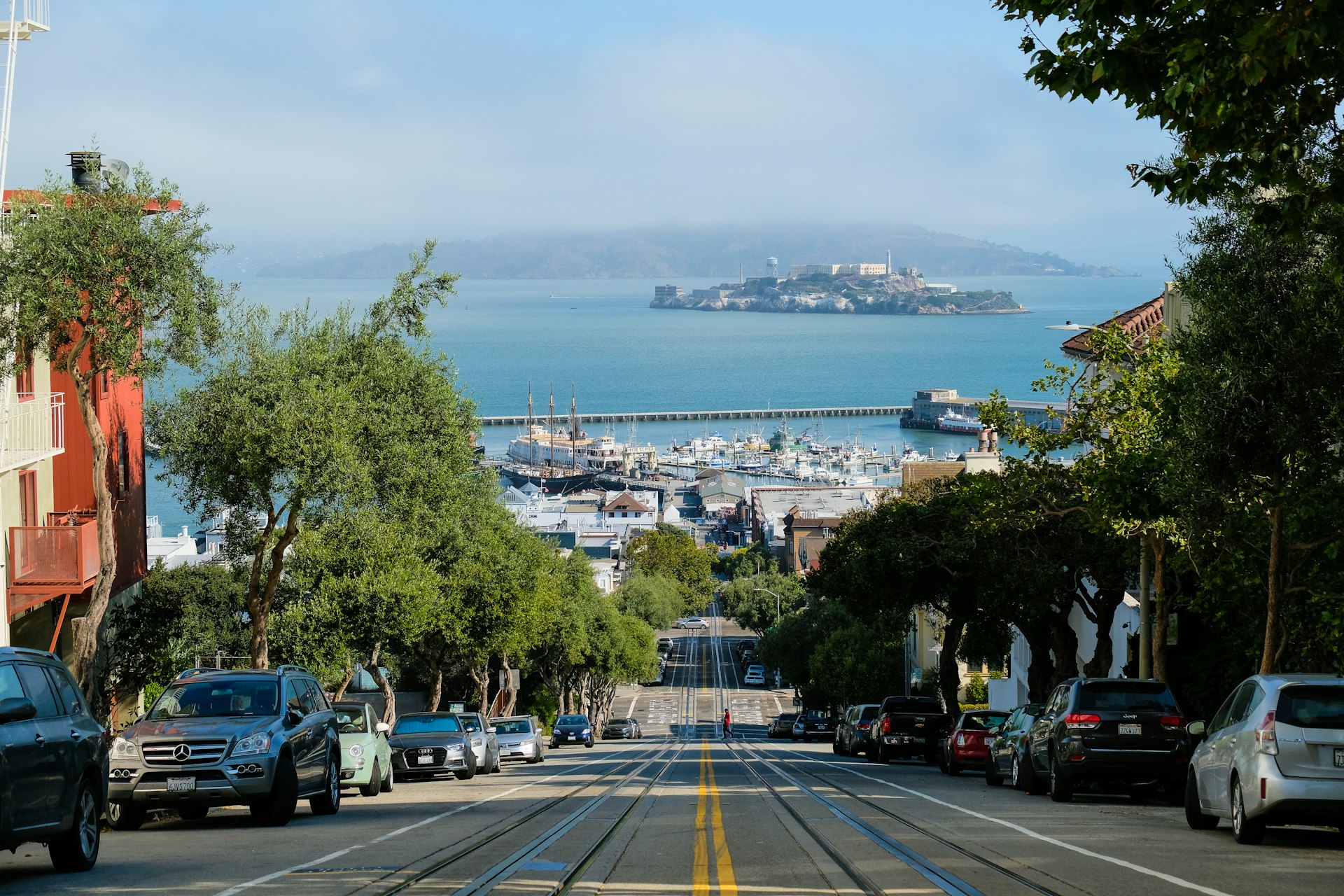
San Francisco, California
San Francisco has so much crammed into its 47 sq-miles and plenty of innovative ways to get around without a car. Ride the historic wood-lined cable cars , take the ferry out to Alcatraz or stretch your legs on a hike around Lands End, where a path follows a long-abandoned train line used to take early 1900s pleasure seekers out to the Sutro Baths . Even eight-switchbacked Lombard St , incorrectly called “the world’s crookedest street,” has considered implementing a $10 entry fee and reservation system , but foot traffic will stay free.
Where to stay in San Francisco
Hotel Emblem is in the heart of it all, and it’s a short – and not too uphill – walk from Powell St BART station. It’s also accessible from the cable car. San Francisco’s quirkiness is infused into the hotel’s core, with a Beat Generation-inspired bar, in-room typewriters and walls painted with Jack Kerouac quotes.
How to get between San Francisco and Santa Barbara by train: From Emeryville or Oakland, Amtrak's Coast Starlight continues south, pulling into Santa Barbara after about nine hours. The section between San Luis Obispo and Santa Barbara is arguably the most scenic of the entire west coast journey, perfectly-timed for golden hour and a sunset arrival. Heading south, nab a seat on the right side of the observation car, and you’ll be glued to the window for hours.
The best time to visit San Francisco

Santa Barbara, California
Picturesque Santa Barbara , filled with immaculately kept Spanish-colonial-style buildings, has a compact, pedestrian-friendly downtown, and you can survey the scene from the top of the mural-filled 1929 Moorish Revival Santa Barbara County Courthouse . You don’t need wheels to get a taste of wine country; sample the best vino on Santa Barbara’s Urban Wine Trail of 30-plus wineries that have set up shop in the city. The biggest cluster is in the Funk Zone, a central neighborhood of converted warehouses decked out in street art that show off Santa Barbara’s hippest side.
Where to stay in Santa Barbara
The Waterman , a small Moxy-brand hotel a short walk from Santa Barbara’s train station, couldn’t be better located. It has a happily social feel, with a communal kitchen, library and games.
How to get between Santa Barbara and Oxnard by train: Both Amtrak's Coast Starlight and Pacific Surfliner cover the stretch of track between Santa Barbara and Oxnard, with a handful of departure times throughout the day. Journey time is just shy of an hour.
The best things you can do for free in Santa Barbara

Oxnard, California
Thought you’d have to skip California’s national parks because you’re on the train? Not so. Oxnard is the nearest launch point to Channel Islands National Park, nicknamed “California’s Galapagos” because of the 145 species of plants and animals found here and nowhere else in the world. Even the ride to the national park turns into a wildlife-spotting adventure, as common dolphins leap through the boat’s wake, and orcas and gray and humpback whales are often sighted. The impossibly-cute island fox prances across the islands’ hiking trails. Kayaking into the enormous Painted Cave – the largest sea cave in North America – will get you closer to barking sea lions and the layers of brightly-colored lichens and algae that give the cavern its name.
Where to stay in Oxnard
Embassy Suites Mandalay Beach has sublime sunset views, and though it’s easiest to get a 10-minute taxi or Uber there from the train station, you’ll then be within walking distance of Island Packers’ boats to Channel Islands National Park .
How to get between Oxnard and Los Angeles by train: On Amtrak’s Coast Starlight or Pacific Surfliner services, it’s two hours south to downtown LA.
10 national parks in the US you can reach by train

Los Angeles, California
Los Angeles drivers spend about 128 hours (almost five-and-a-half days!) a year stuck in traffic, but you don’t have to join them. Instead, disembark at LA’s gorgeous Union Station , which has become a destination in itself, with Imperial Western Beer Co, a craft beer brewery, jazzing up some of the stunning Art Deco space . The Metro can get you many places on your LA to-do list, and you can zip around on electric scooters from Bird, Lime or any of the others you spot on the sidewalk. Get your step count up on a hike around Griffith Park and behind the Hollywood sign before watching the sunset from Griffith Observatory .
Where to stay in LA
Intercontinental Los Angeles Downtown is only a few Metro stops from Union Station, and you’ll feel like you’re staying amongst the stars as you’re shot up to the 70th-floor lobby with ceiling-height windows and fine views of the Hollywood sign.
How to get between Los Angeles and San Diego by train: All aboard for Amtrak’s southernmost stop on the west coast. The Pacific Surfliner trundles along the coast several times a day to make the three-hour trip.

San Diego, California
Sun-tanned and laid-back San Diego is the perfect place to unwind at the journey’s end. Watch surfers take on waves at one of the city’s 60 beaches or relax in Balboa Park after stuffing your brain full at its many museums. Revel in your completed cross-country adventure with a night out in the rowdy Gaslamp Quarter or with a pint at one of the many breweries in the self-proclaimed craft beer capital of America.
Where to stay in San Diego
Andaz San Diego is an easy walk from San Diego's Santa Fe Depot, where Amtrak’s Pacific Surfliner train ends. The hotel is in the middle of the Gaslamp Quarter action, and its rooftop bar will help get your evening started.
You might also like: How to save money when you're traveling So, you’re thinking of living the RV life. Here’s what you need to know Can you do the all-American road trip in an electric car?
Explore related stories
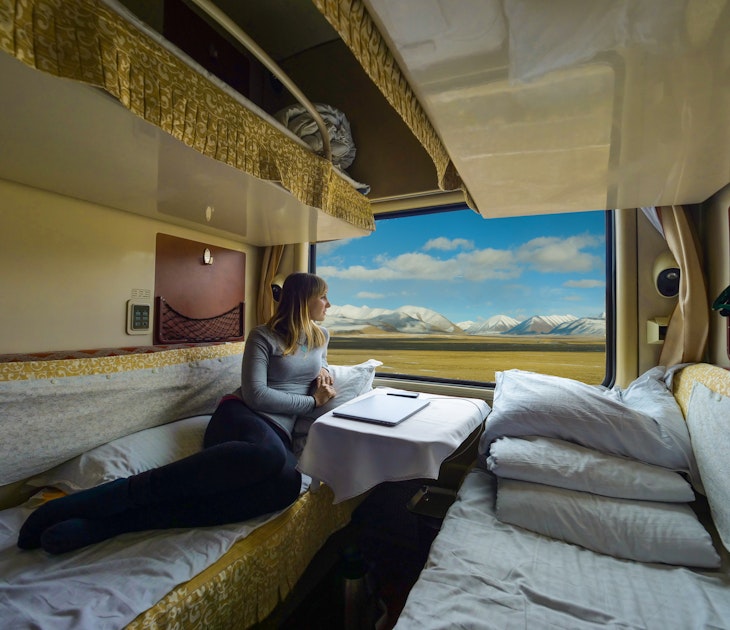
Sustainable Travel
Sep 20, 2021 • 5 min read
If you have a long way to go, don’t just jump on a plane. Night trains are a more fun, eco-friendly way to travel.

Nov 29, 2019 • 1 min read

Apr 26, 2024 • 7 min read

Apr 26, 2024 • 6 min read

Apr 23, 2024 • 5 min read

Apr 20, 2024 • 4 min read
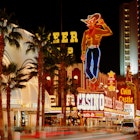
Apr 19, 2024 • 6 min read
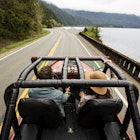
Apr 17, 2024 • 5 min read

Apr 17, 2024 • 6 min read
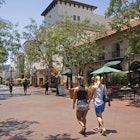
Apr 17, 2024 • 8 min read
- Skip to primary navigation
- Skip to main content
- Skip to primary sidebar

Everything you need to know about traveling without a car in the United States
August 3, 2018 by Karen Turner 6 Comments
As someone who is American and has never had a driver’s license, I am uniquely qualified to write about traveling in the United States without a car. A lot of people say it can’t be done–and it will be miserable, however I’ve found that it has minimally impacted my experience traveling in the United States.
This post will be about my experience living and traveling in the United States without a car and I hope that inspires you to travel in America in a more sustainable way!

Let’s just leave it at the fact that I’m maybe not the best driver, so I’ve managed. Although I was fairly broke as a student, I managed to see a fair amount of the East Coast without ever driving. This post is mostly based on those experiences, however quite a few of you reached out me after my experience traveling in Texas without a car.
Recently, I headed to a wedding to Houston, Texas. One of my good friends told me that it couldn’t be done: Houston without a car. I admit that I’m a bit of a contrarian and I love to prove people wrong. I traveled with my husband who agreed that it would be much better–and cheaper if we avoided renting a car. In the end, we ended up spending a fraction of what the car rental would have cost and man , we had an adventure.
- 1.0.1 It doesn’t make sense to have a car for certain American itineraries
- 1.0.2 Ensure that your hotel is located near public transport
- 1.0.3 Check your hotel’s neighborhood for food and safety
- 1.0.4 Airport shuttles are super helpful and cheap
- 1.0.5 Avoid early/late flights
- 1.0.6 Figure out your trip in an excel. Make sure you think about it.
- 1.0.7 Some cities, not all cities, are easy to navigate with public transit
- 1.0.8 You need a working phone
- 1.0.9 Your transit options for taxis (and other ride services)
- 1.0.10 Greyhounds, Megabuses, and Amtrak are your friends
- 1.0.11 Things are looking up…
- 1.0.12 There’s no shame in taking a tour for the day
- 1.0.13 Consider using a tour provider if you’re not a planner
- 1.0.14 Rideshares do exist although they’re less common
- 1.0.15 Hitchhiking is weird in the US, but possible
- 2.0.1 Don’t be afraid to take a taxi to the bus or train station
- 2.0.2 Walk, even if there’s not a sidewalk
- 2.0.3 Be aware of the dangers of crime
- 2.0.4 When you have the chance to visit a supermarket, Walmart, or Target, use it wisely.
- 2.0.5 Don’t be surprised if many of the recommended restaurants are too far to reach without a car. Don’t be afraid to ask for recommendations closer.
- 2.0.6 Always have a little cash (in coins) on you for the bus/train/tram
- 3 Have you traveled in the United States without a car?
Things to remember about planning a trip in the US without a car
It doesn’t make sense to have a car for certain american itineraries.
I write this as many of my European friends are planning trips to the US. Although the idea of a road trip is great, it’s often expensive renting a car in one location and returning it in another. It’s generally cheaper to return your rental to the same location.
I calculated the cost for a friend planning an East Coast trip and it was cheaper to just take buses one-way between cities without backtracking (as they would with a car). For their itinerary, it made more sense and it was cheaper to rent a car for short durations (1-5 days) for mini road trips using one city as a base. (They wanted to do the Key West road trip from Miami.) In the end, it was cheaper to do their East Coast trip mostly by bus ending in Miami after a brief break in the Keys prior to hopping on a plane in Miami to the West Coast.
Similarly, for major US cities like D.C., New York City, Boston and San Francisco, parking is really expensive. If you’ll be taking good public transportation around, you’re likely to save a lot of money compared to the daily cost of your rental, gas, and parking.
Similarly, for going up and down the East Coast (DC -> New York -> Boston), there’s great bus and train connections that make it so easy that you can just leave the train/bus station without needing to worry about your rental.
It might end up being cheaper to go one-way through US cities as mentioned above (DC -> New York -> Boston) prior to utilizing affordable airways, like Jetblue, to hop around your dream destinations. It’s not to say that you shouldn’t rent a car at any point, but I’d recommend limiting it to locations where you’ll be using it daily.
Ensure that your hotel is located near public transport

This is the biggest point to remember! America is car centric, so you need to be very careful in choosing where you stay to ensure that you have a link to public transport. I generally try to pick locations that are along several bus/train lines to give me good options in terms of getting around, even if I’m twenty minutes outside of my “destination” by foot or bus.
Even if public transportation isn’t great, you want to be close to what you’re visiting the city for. The reason is that some public transportation lines shut down by a certain time, so you can get stranded if you’re out too late. My maximum radius from a city center on foot is generally about forty minutes as sometimes, you’ll need to resort to walking as you stayed too late at the bar. 😉
Check your hotel’s neighborhood for food and safety
This is the big one. If you’re traveling in the US, not everywhere in safe. The United States has some of the highest rates of gun violence in the world. I don’t write that to scare you, but to remind you that crime is an issue in many American cities. If you’re a minority, you may also be more likely to be targeted by the police, so I encourage you to exercise caution.
This is why it’s so important to look up the neighborhood that you intend to stay in carefully as well was which neighborhoods that you might walk through. Someone I know booked an incredibly cheap Airbnb in New York City, however when she told me the neighborhood, I was a bit shocked that she’d stay there as even I consider it a dangerous area. She ended up being fine, but never felt safe walking there.
On a related note, I encourage you to look up your food options in the neighborhood you’re staying in. Check to see if there are any supermarkets, bodegas (little corner markets with snacks), or good restaurants (check Yelp!) near where you’re staying. For many Americans, 2-3 miles is barely distance to drive to pick up food, however if you don’t have a car, you need to have good stuff within walking distance in case you come back late.
Airport shuttles are super helpful and cheap

When heading to your hotel, I recommend trying to book a hotel that comes with an airport shuttle as it will save you some frustration. Even if it doesn’t, you can always book a private/shared airport shuttle for a fraction of the cost of a car if public transportation doesn’t go to your destination. This is especially helpful if your plane comes in late.
When I traveled to the Sarasota area for a conference, I had planned to take the bus out to our scenic hotel resort by the beach. However, my plane was delayed significantly and I arrived around 11pm. Public transit was done by this time.
Luckily, I was able to book an airport shuttle and for only $40, my friend and I got to our hotel. The taxi for both of us was estimated at over $100, so we saved a lot with an almost direct ride to our hotel with just one stop off for another passenger.
Avoid early/late flights
When I found a cheap flight from Pittsburgh to California, I thought that I was saving a lot of money. However, Pittsburgh doesn’t have the greatest public transportation. As I was coming into Pittsburgh from elsewhere, I had to decide whether I’d book a hotel and then leave for the airport at 5am (to make my flight for 8am) or wing it to save money.
…I ended up winging it and hanging out with new friends from Couchsurfing all night until I caught my taxi to the airport at 5am as there wasn’t a bus that early. However, that taxi cost me the difference between that flight and the one later in the day.
Simply, if you think that you’re saving money by coming into a destination very late or arriving at the airport very early, it might be very difficult to get public transportation working during the times that you need. It’s likely that you’ll need to take a taxi, which is fine, but an added expense.
Figure out your trip in an excel. Make sure you think about it.
I love having a trip planning excel to figure out transportation between cities as well as transportation within each city. I like to figure out the links between cities first as well as look up just how good public transit is within the city I’m visiting.
I often save which bus to look for, the direction, the cost of the fare, and how long the total journey takes.You need to be realistic about your timings as things take longer without a car. Give yourself wiggle room and know the buses/fare amounts ahead!
Some cities, not all cities, are easy to navigate with public transit

I’m from New York City , which has fantastic public transportation . However, this is not the case for many cities and many cities have such severe urban sprawl that it’s hard to get around.
As mentioned previously, I was in Houston. Houston is one of the largest cities in the United States. On a recent trip, we had to go across Houston. That was over 50 miles. To be fair, there are buses, but none that cut across Houston in the manner that we needed.
My friend told me that it would be not possible. I had to spend a while doing research for this trip as even Google couldn’t figure out the route telling me that it was impossible . I find that Rome2Rio is far better than Google for these creative routes in cities with unfriendly public transit. Luckily, we hacked it.
We ended up taking a cab from my friend’s house on the outskirts to the third nearest bus station, which had a direct bus to downtown Houston. From downtown Houston, we had two hour layover where we had delicious Texas BBQ. From here, we caught a 1+ hour bus towards the Houston Space Center. From the Houston Space Center, we had to call a taxi to bring us the last eight miles to our shared vacation house with friends. It took about four hours total and we went over sixty miles without a car. Trust me, where there’s a will, there’s a way.
You need a working phone
If you plan to utilize any of the transit apps or taxis, you’ll want a working phone. Especially for services like Lyft in more remote areas, you’ll need data. I used Google Hangouts to make phone calls as I was using my Dutch phone number while in the United States.
However, I didn’t need to turn on my international roaming more than once . Each time, I was able to use the wifi and/or ask for the wifi code everywhere that we stopped off and that we had to get a ride from.
Your transit options for taxis (and other ride services)

I’ll be the first one to state that I don’t love using Uber, but in many parts of the US, Uber is ubiquitous. The reality is that when you don’t have a car, you can’t take as firm of a stance against Uber as they’re practically everywhere while Lyft is still not as common.
Lyft is their friendlier rival that treats their contractors better. As mentioned previously, you’ll want to commandeer the wifi at your accommodations to use these apps for free without roaming charges.
I must say that our experiences taking Lyfts around Houston was wild . We met some amazing hardworking Texans . Our most crazy experience: our driver’s husband got arrested while we were in the car. Luckily, she managed to find someone to make bail for him and drop us off in good time.
If you’re reading this thinking that you prefer a traditional taxi, write down the local taxi phone number beforehand and/or ask someone local for their preferred taxi. I found this to be just as effective as I didn’t have data and most Americans have unlimited data.
Greyhounds, Megabuses, and Amtrak are your friends
The best way to get around the United States between cities is by Greyhound, Megabus, and other bus companies. If you’re doing a big US trip or you’re simply traveling between two cities, you’re likely to find a bus headed your direction. That said, bus travel in the United States is far from glamorous, but it will get you from A to B. Amtrak is a good option on the East Coast.
Things are looking up…
I recently discovered that Flixbus, the European bus company has started buses around Southern California with rates as low as $3 for travel between LA and Las Vegas. It’s clear: more Americans are rejecting cars and we’re starting to see some leeway in terms of better options for traveling without a car. We still have a ways to go as rural America still remains difficult.
There’s no shame in taking a tour for the day

One of my favorite “hacks” for avoiding renting a car and doing day trips around a city is using day tour companies to book tours. Most of these day trips from cities include transportation. For instance, if you’re visiting Las Vegas, you can take an easy day trip to the Grand Canyon for a reasonable amount. (Getting to the Grand Canyon without a car is not a trivial task.)
In general, it’s good to remember that you have non-driving options when it comes to visiting famous American sights that typically require a car like Yosemite from San Francisco , the Grand Canyon from Las Vegas , and Key West from Miami .
Consider using a tour provider if you’re not a planner
Two of my friends ended up doing Contiki across the United States after just feeling overwhelmed with planning a multi-week trip trying to cover most of the United States. I’m not a big group traveler, but G Adventures, Contiki, and other tour providers have already optimized the itinerary for you. It’s cheaper to do it without a tour, but both of them still rave about the lifelong friends that they made during their Contiki trip.
Rideshares do exist although they’re less common
I’ve used a number of ride share services, generally found off boards at local universities as well as off craigslist (our classified websites). The only thing about rideshares is that I find that they’re not so reliable in advance, so if you’re more of a last-minute traveler and/or you’re traveling close to the holiday season near a major American university, you’ll have more success as it’s often college students who are more likely do rideshares. It’s still fairly uncommon in the US.
Hitchhiking is weird in the US, but possible
I have one friend who hitchiked with her husband in the United States through California. She said that it was easy and everyone who gave her a ride was very friendly.
Many people don’t realize that it used to be very common, however at some point, the perception changed from “the friendly hitchhiker” to the “hitchhiker that will murder you.” It’s less common, however definitely possible. I’ve heard that HHing is far more common in Alaska and Hawaii.
Things to remember once you’re in America
Don’t be afraid to take a taxi to the bus or train station.

Sometimes, it’s really not worth walking miles with all your baggage. I’ve thought about this many times, however sometimes it’s really worth the extra $20 for the relaxed experience of just hopping into a taxi. This is especially true if the weather isn’t great and/or it’s late at night.
Walk, even if there’s not a sidewalk
When we were in Texas, we experienced something that I don’t miss about living in the United States: streets without sidewalks. We were in a residential neighborhood that was virtually built for cars, not people. Instead of taking it personally, I happily walked along the edge of the road carrying my backpack . People gawked, but it was fine.
Be aware of the dangers of crime
As a tourist, you’re likely to have lots of nice electronics with you. In general, it’s best to minimize what you carry on you, avoid wearing headphones when walking at night, and use common sense. You’re going to stand out if you’re walking around a not-so-great neighborhood with a fancy DSLR camera, so just be aware of your surroundings.
When you have the chance to visit a supermarket, Walmart, or Target, use it wisely.
If you’re traveling in the United States without a car, you’re going to struggle with finding supermarkets close to you. Especially if you have a longer trip, I strongly recommend stocking up when you get the chance.
I recommend avoiding perishables, but our trips to the supermarket really helped us cut down the cost of our travels in the US as we had enough food to make lunch at our rental. I usually stock up on granola bars when I can!
Don’t be surprised if many of the recommended restaurants are too far to reach without a car. Don’t be afraid to ask for recommendations closer.

When we were in Texas, there were so many great restaurants recommended to us . I spent a while looking up these recommendations only to realize that many of them were at least five miles by car.
Luckily, I spent a while sitting down with my friend Kristy showing her the map of where we’d be. I zeroed in on a smaller radius near the bus stop (.5 mile) and she was able to give us lots of great recommendations that didn’t require much walking.
Most people that we talked to assumed that we had a car… After explaining that we were looking for places less than one mile from one location, most people were able to give us some solid recommendations! I love using Yelp to find close picks although don’t be afraid to show people your map. Some people won’t know anything close to your specific base, however you should be able to find something near you if you’ve planned carefully.
Always have a little cash (in coins) on you for the bus/train/tram
Many buses in the US require coins, rather than bills or credit cards. I recommend having a hidden stash of quarters as well as looking up how much the public transportation costs to ensure that you have enough. A lot of bus drivers can’t break bills as they carry very little cash. I encountered this when I was in Houston and luckily, they let us on the bus for free.
In all, I really hoped that I helped you at least think creatively about your travels in the United States without driving. There’s so much to see in the US and don’t feel that you must have a car, especially if you’re strictly sticking to the major cities.
[learn_more caption=”More practical advice about traveling in the US” state=”open”]
- Budget Travel in the United States
- Five days in New York by a New Yorker
Have you traveled in the United States without a car?

About Karen Turner
New Yorker–born and raised. Currently living in the Hague, the Netherlands after stints in Paris and Amsterdam. Lover of travel, adventure, nature, city, dresses, and cats.
Reader Interactions
August 3, 2018 at 4:42 pm
Karen this is amazing you are a US citizen and never had your license. Fascinating. I grew up in New Jersey so it’d have been almost impossible to get to work and school without a car. I do find not having a car for the past 10 years to be liberating though; I have my license and drive a little bit but Uber, buses, and my 2 feet handle transport 😉 Rocking post!
August 4, 2018 at 10:17 pm
Can’t believe you don’t have a driver’s license but I understand if you lived in NYC. I can’t wait for the day the US joins the 21st century and gets a high-speed train.
August 5, 2018 at 12:53 am
I agree with you 100%. Ther are many cities in the US where mass transit is the way to go. And, many people in NYC don’t have a drivers license. I lived there for decades without a car, though I did have a license.
August 5, 2018 at 6:07 am
I remember after moving back to the States after living in Germany. I refused to buy a car, simply because I wanted to see if I could get around without one, like I did in Germany. Man, it was a struggle because I didn’t know about Uber and Lyft yet (back in 2014), and Salt Lake City’s public transportation wasn’t always reliable. Thankfully that’s all changed now and I would highly recommend giving it a try!
August 5, 2018 at 7:29 am
We have lived in southern Ontario, northern Ontario, Calgary and Vancouver and the only place we needed the car was northern Ontario. We have been without a vehicle now for almost five years, We are a family of four and public transit and cabs when needed has helped us to save money to travel and live from one city to the next. Great article!
January 12, 2020 at 9:12 pm
Thanks for sharing this post! Like you when someone says I can’t go somewhere with public transportation I want to prove them wrong….and I have many times! I’m working on my SE USA road-trip without a car now, despite many naysayers! I agree with your tips about choosing accommodation around transit, food and activities. I’m trying to be downtown in every city I visit, but it’s so much more expensive. And for the first time in years I am working on getting a working phone so I have access to taxis when I don’t have wifi.
I love this post and you reassured me that I am thinking about all the right things. Traveling without a car does take more planning and I think a lot of people don’t want to do that…..but it can totally be done!
Leave a Reply Cancel reply
Your email address will not be published. Required fields are marked *
- The Netherlands
- New York State
- Other European destinations
- Work With Me
- Disclosure and Privacy Policy
- Jeju SEO Tool: Free SEO Writing Tool
You can unsubscribe anytime. For more details, review our Privacy Policy.
You have successfully joined our subscriber list.
TreasureHunter USA Inc. 251 Little Falls Drive Wilmington, Delaware 19808 +1 (915) 4632387 EIN 88-2174128
www.wanderlustingk.com is a participant in the Amazon Services LLC Associates Program, an affiliate advertising program designed to provide a means for sites to earn advertising fees by advertising and linking to amazon.com. As an Amazon Associate, we earn from qualifying purchases. We also participate in other affiliate programs
www.wanderlustingk.com all rights reserved © 2023 | Privacy Policy | Cookie Policy |
Nomadic Matt's Travel Site
Travel Better, Cheaper, Longer
How to Road Trip Across the United States on a Budget
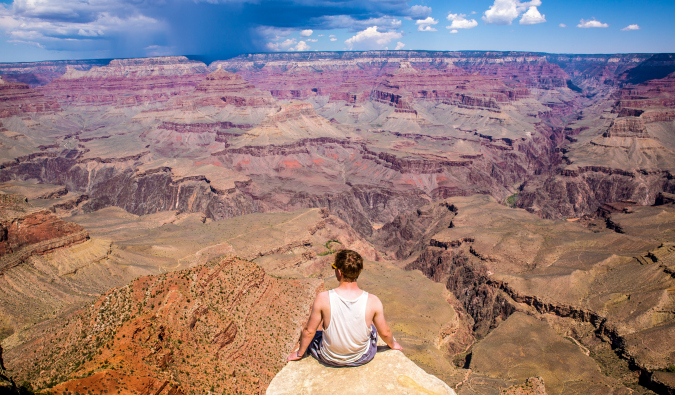
The Great American Road Trip is a rite of passage in the United States . We Americans have a unique fascination with the open road. It’s built into our cultural DNA. In Jazz Age America, the car was a symbol of freedom — a chance to escape your small town and the watchful eyes of parents.
As the highway system was developed in the 1950s, a wave of kids set out on the road to explore the country, giving new life to America’s car and road trip culture. Today, many still dream of getting in a car and driving into wide open spaces for months on end.
I’ve had the privilege of taking several multi-week and multi-month road trips around the country over the years. From traveling the Deep South to criss-crossing the country coast to coast , I’ve visited almost every state, exploring the myriad nooks and crannies of Uncle Sam’s backyard.
One thing is for certain, in diversity and scale, the United States is virtually unrivaled.
But this isn’t a post about fawning over America and its landscapes ( this post is ). This article is about how you can travel around the US on a budget.
Because, as it turns out, this country is surprisingly easy to travel on the cheap.
While rising gas prices and rental car price gouging post-COVID put a damper on things, it’s still easier than you think to have a budget-friendly road trip adventure around the USA.
In this post, I’ll explain how much I spent on one of my trips, how much you should expect to spend, and how you can save money on your next road trip.
Table of Contents
How Much Did My Cross-Country Road Trip Cost?
How to save money on your road trip, how to save on accommodation, how to save on food, how to save on sightseeing, how to save on transportation.
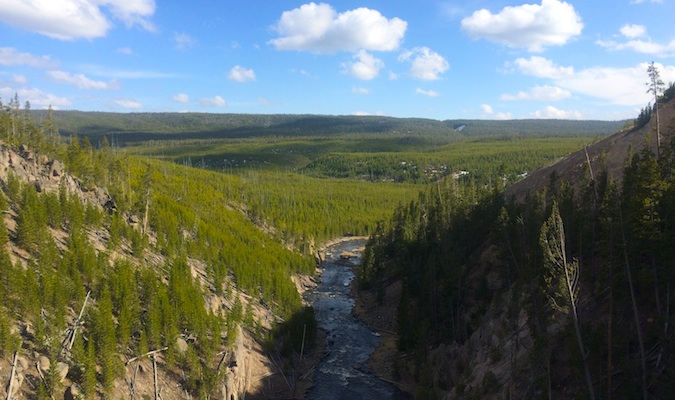
After 116 days traveling around the United States on this trip, I spent $6,262.67 USD, or $53.98 USD per day. While that is slightly higher than $50 USD a day, there were many parts of my budget I splurged on (see breakdown below) which skewed the number up. I definitely could have visited the country even cheaper if I didn’t have an addiction to Starbucks and sushi.
Here is how the numbers from my road trip break down:
- Accommodations: $1,036.36
- Food: $3,258.23
- Drinks: $438.94
- Gas: $696.98
- Parking: $253.00
- Starbucks: $75.26
- Miscellaneous (movies, toiletries, etc.): $170.00
- Attractions: $269.40
- Taxis: $41.00
- Bus: $17.50
- Subway: $6.00
- TOTAL : $6,262.67
Let’s break this down. First, my Starbucks addiction was unnecessary and added to my costs. Second, as a lover of sushi, trying various restaurants throughout my road trip drastically raised my food costs. Sushi, after all, is not cheap.
Moreover, I ate as if I wasn’t on a budget and rarely cooked, which is why my food expenses were so high relative to everything else. I would have definitely gone below $50 USD per day if I followed my own advice and cooked more often.
But, while I splurged in some places, three other things really helped me to keep expenses down: First, gas prices were low, averaging around $2.35 USD a gallon over the duration of my trip. (We’re going to discuss how to still do a road trip on a budget with high gas prices in the next section.)
Second, once you leave the big cities, prices for everything drop by nearly half so I spent a lot of time out of cities.
Third, I used Couchsurfing and cashed in hotel points to keep accommodation costs down. That helped a lot.
Overall, I didn’t do too bad and am happy with how much I spent. But is this how much you’ll spend, especially in the face of inflation and high gas prices? Let’s discuss that below.

It’s no secret travel costs a lot lately and inflation and high gas prices have really made super cheap road trips hard if you’re not staying places for free but that doesn’t mean the road trip has to be super expensive.
With that in mind, here’s how to cut your accommodation, sightseeing, food, and transportation costs — all without cutting into your experience!
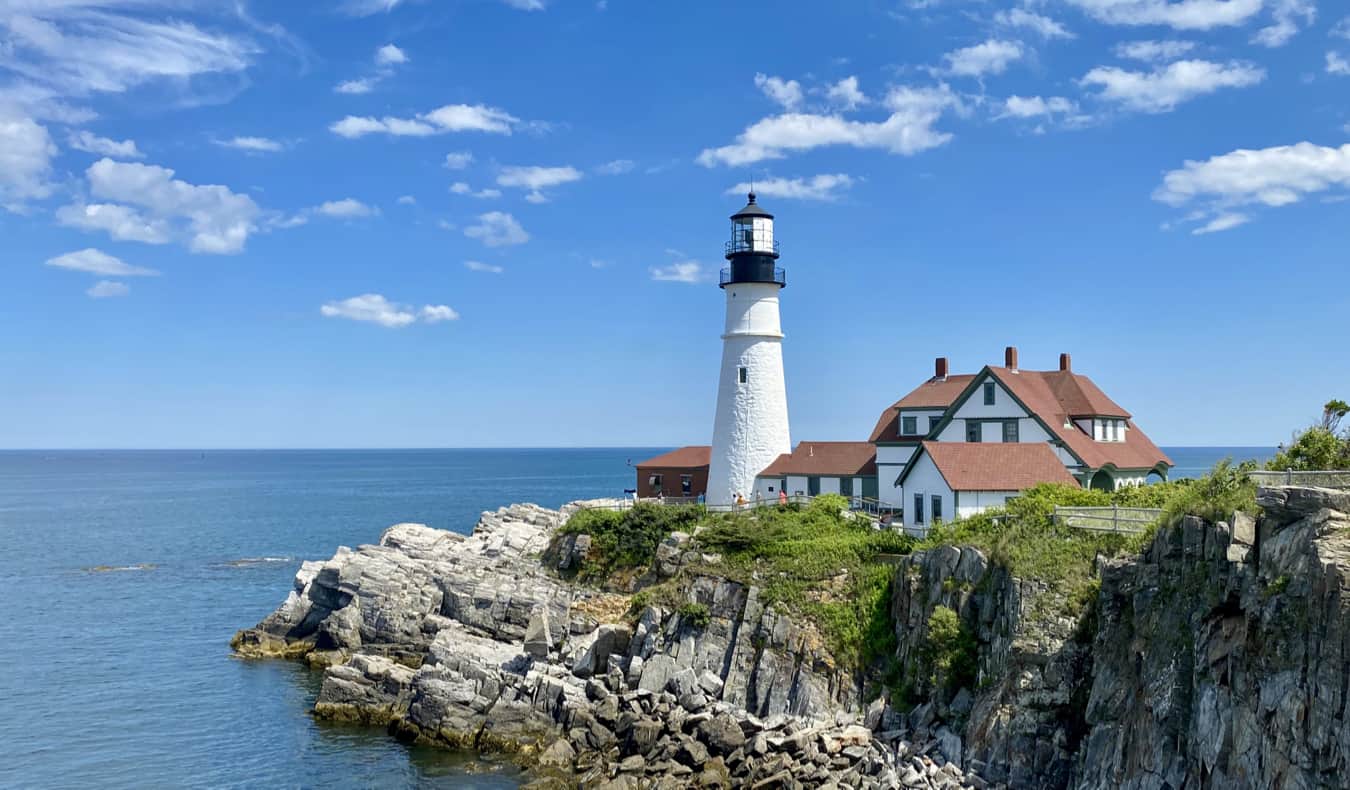
1. Couchsurf — Couchsurfing is a service that allows you to stay with locals for free. Using this website (or similar ones) is the best way to lower accommodation costs, as you can’t get cheaper than free!
More than that, it’s a wonderful way to meet locals, get insider tips, and find off-the-beaten-track stuff to do in the area you’re visiting. While you’re generally expected to reciprocate your host’s kindness (cooking them a meal, taking them out for drinks or coffee, etc.), it’s still far cheaper than paying for a hotel or motel.
While the app has seen its community shrink in recent years, there are still plenty of hosts across the United States so you’ll rarely find problems finding someone to put you up.
Additionally, if you don’t feel comfortable staying with a stranger, you can use the app to meet people for drinks, coffee, activities, or anything else you want to do. That way, you can still meet a local and get their insider tips without having to stay with them. The app has all kinds of meet-ups and events too so be sure to check it out.
2. Airbnb — I only recommend using Airbnb in rural, out of the way places where hotels are limited. Avoid them as much as possible in other circumstances. Here is why we don’t really recommend them.
3. Budget hotels — There are a plethora of cheap roadside hotels such as Motel 6 and Super 8 that will help you stay cheap. Rooms start around $50 USD per night and are super basic and always look well worn. You’ll get a bed, bathroom, TV, tiny closet, and maybe a desk. They are nothing to write home about, but for a quiet place to sleep for a night, they do the trick.
And if you’re traveling with someone you should always say the room is for one person as these hotels charge you more for two people.
Also, make sure you sign up for Booking.com and Hotels.com loyalty programs. Hotels.com gives you a free room after 10 bookings, and Booking.com offers members 10% off bookings, as well as free upgrades and perks if you book multiple times after signing up. They definitely helped a lot.
Pro tip : Book through websites like Mr.Rebates or Rakuten . By using their links before going to Hotels.com or Booking, you’ll get 2-4% cash back in addition to the loyalty program deals.
4. Hotel points — Be sure to sign up for hotel credit cards before you go and use those points when you travel. You can get upwards of 70,000 points as a sign-up bonus, which can translate into a week’s worth of accommodations.
The points came in handy in places where I couldn’t find an Airbnb, hostel, or Couchsurfing host. This saved my butt in big cities around the country. I was glad I had accrued so many hotel points before my trip.
To learn more about, check out these posts:
- The Best Hotel Credit Cards
- The Ultimate Guide to Picking the Best Travel Credit Card
- Points and Miles 101: A Beginner’s Guide
- The Best Travel Credit Cards
5. Hostels — There aren’t many hostels in the United States, and most of them are overpriced. A dorm room typically costs around $30 a night, which means you can obtain a similar private room on Airbnb at the same price. If you are traveling with others, it’s often more economical to get a budget hotel than a bunch of dorm beds.
However, if you are traveling solo and want to meet others, the social benefits may outweigh the lack of value. There were just some times I didn’t want to be alone – I wanted to be around other travelers.
Some of the hostels I loved are:
- Samesun Venice Beach (LA)
- South Beach Hostel (Miami)
- India House (New Orleans)
- Jazz Hostels (NYC)
- ITH Adventure Hostel (San Diego)
- The Green Tortoise (San Francisco and Seattle).
For more hostel suggestions, here’s a list of my favorite hostels in the USA.
6. Camping — Dotted around the country — including around all the national parks — are inexpensive campsites. If you have a tent and camping gear, this is by far the cheapest way to travel. Campsites cost between $10-30 USD per night, which makes seeing the country incredibly affordable. Most campsites have basic amenities like running water, bathrooms, and the ability to upgrade to get electricity.
In addition to your standard campgrounds, check out the sharing economy website Campspace . It lets you pitch a tent on private properties all around the country for a small fee. Much like Airbnb, some plots are super basic and barebones while others are more luxurious, so be sure to poke around for a cheap place to stay as there are plots available all around the country.
It’s also legal to wild camp in national forests and on BLM land unless otherwise marked.
7. Sleep in your car — I know this isn’t glamorous but sleeping in your vehicle brings your accommodation costs down to zero. I know lots of travelers who did this to make their trip more affordable, some sleeping in their car just occasionally and others doing it every night. Chances are you won’t sleep well but you will save money, and that’s a fair trade to some people!
For those traveling in an RV, there are tons of free places to park and camp all around the country. Use iOverlander to find the best spots.
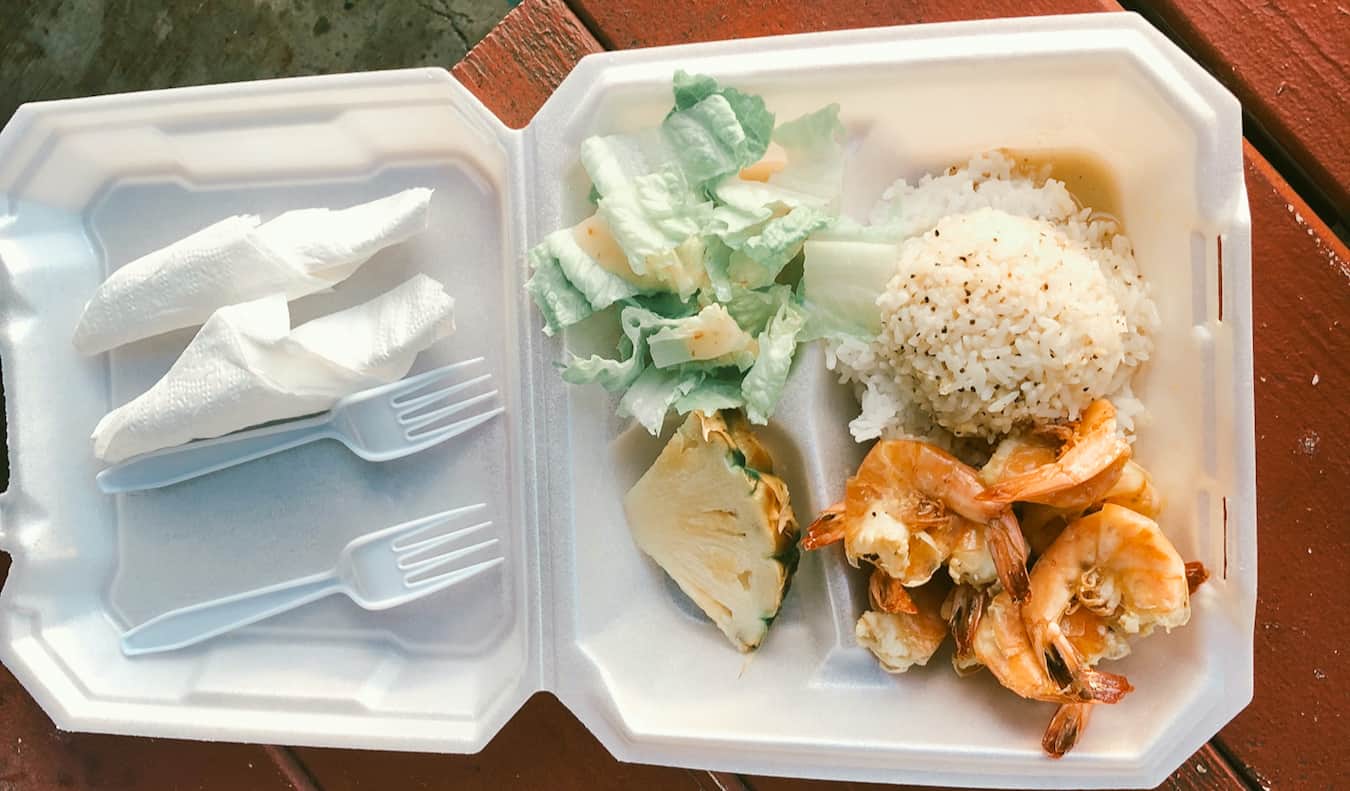
To help you keep your food costs in check, here are a few quick tips:
1. Cook your own meals as often as possible – If you can bring a cooler in your vehicle, you can pack groceries instead of eating out all the time. And if you bring some containers, you can store leftovers in the car too, allowing you to cook larger meals at dinner that you can eat the next day for lunch.
2. Stay in accommodation with a kitchen – If you want to cook, you’ll need a kitchen. Prioritize accommodation like Couchsurfing, Airbnb, and hostels as those will typically provide kitchen access so you can cook your meals.
3. Shop cheap – Avoid the pricier grocery stores like Whole Foods when it comes to getting groceries and stick to budget places like Walmart. It’s not glamorous, but it will be cheap!
4. Find cheap restaurants – When you want to eat out but don’t want to break the bank, use Yelp, ask people on websites like Couchsurfing, or inquire at the desks at hostels for suggestions. Locals have the best tips and insights when it comes to where to eat so they can point you in the right direction. Simply cook, limit your eating out, and be happy!
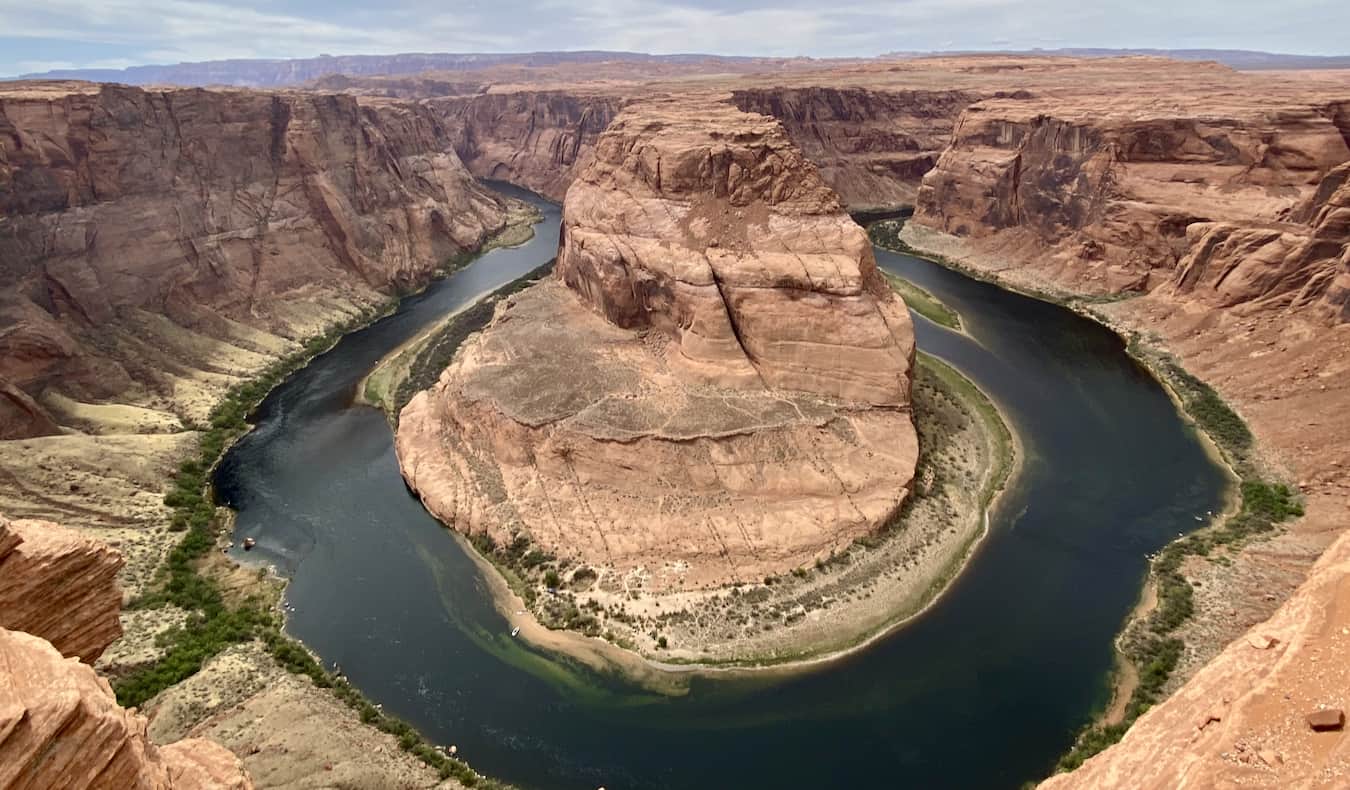
1. Get a National Parks pass — For $80, you can purchase an annual National Parks and Federal Lands ‘America the Beautiful’ pass that provides access to all 63 national parks (as well as any other recreation areas administered by the National Park Service). In total, you can visit more than 2,000 federal recreation sites with the same pass. At $20-35 USD per visit, seeing five during your trip makes the pass a money saver. When you visit your first park, simply buy the pass and you’re good to go. There’s no need to order it in advance.
The U.S. national park system is amazing and really highlights the diversity of landscapes in the country. You can’t travel across the country without stopping at many of the national parks, especially as you get out west.
2. City tourism cards — City tourism cards allow you to see a large number of attractions (and often include free public transportation) for one price, usually $75-100 USD. They provide free access to museums, reduced access to attractions, and restaurant discounts. Be sure to look into them if you plan on doing a lot of sightseeing, as they generally will save you money. They can be purchased at tourism information centers or online before you go.
3. Free museums and events — Inquire at tourism centers, use Google, or ask hotel or hostel staff for information about free events and museums. Many museums offer occasional free or discounted admission throughout the week. There are always tons of free activities in any city in the United States.
4. Free walking tours and city greeter programs — Many cities in the US have free walking tours or city greeter programs that pair you with a local guide who can give you a brief tour. Whenever I visit a new city, I start my trip off with one of these tours. They show you the lay of the land, introduce you to the main sights, and give you access to an expert local guide that can answer all your questions.
Check in with the local tourism office when you arrive to see what programs and tours are available.
For greeter programs, you’ll need to sign-up in advance before your visit. It’s good to give about 2 weeks’ notice as they have to find someone to take you around. Google “(city name) greeter program” to find them as some are run independently of the city tourism board so might not be listed on their website.
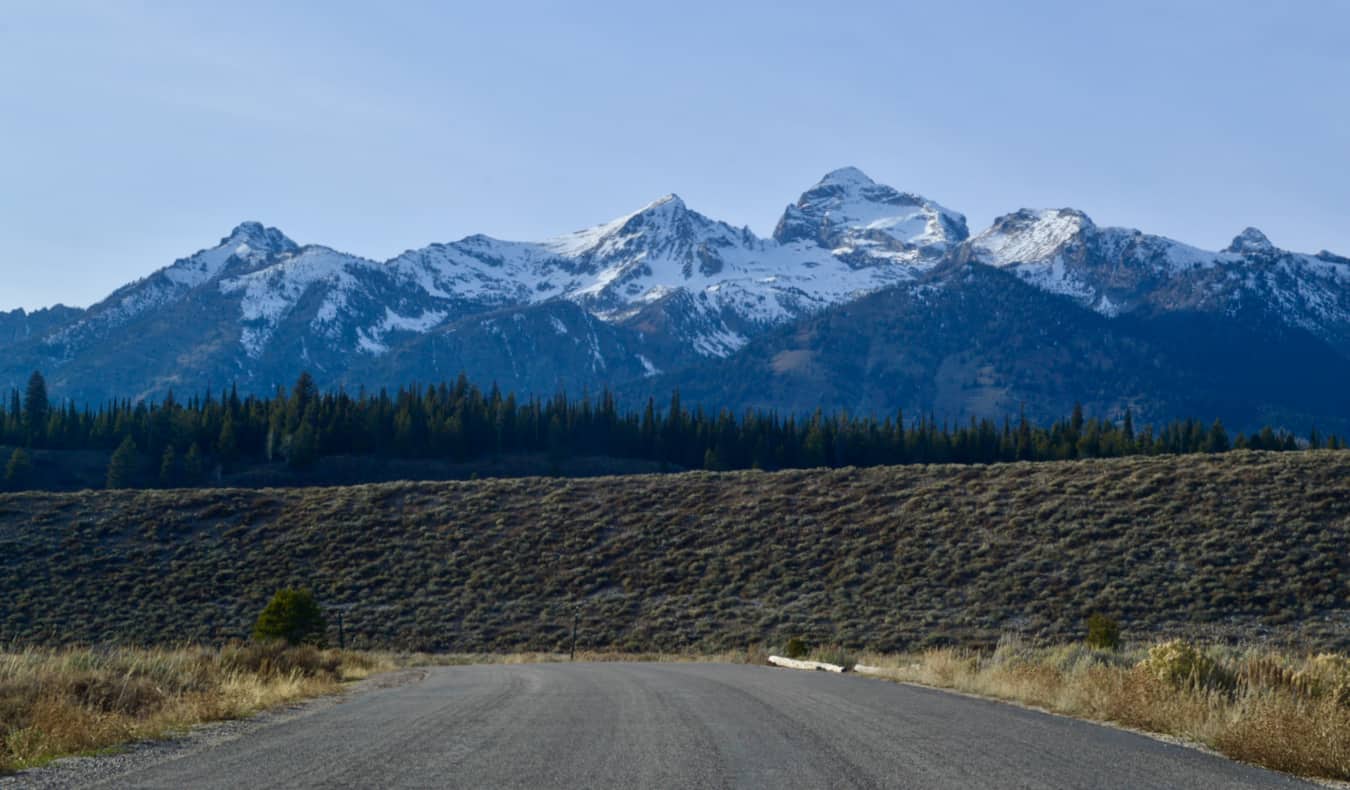
Here are your options when it comes to traveling across the country:
1. Hitchhike — This isn’t something I did on my trip, as I had a car, but it’s very doable (and relatively safe). Here’s a post by my friend Matt who hitchhiked across the United States explaining how to do so and come out alive (don’t worry, it’s safer than you think)..
For more hitchhiking tips, use Hitchwiki .
2. Rideshare — Taking on riders can be a way to lower your costs. On my first trip across the U.S., I offered rides to people I met in hostels. On this trip, I had friends and readers join me along the way. You can post ads on Craigslist and Gumtree and at hostels to find riders. This not only makes the trip more enjoyable but lowers your gas costs. Or if you are a rider, you can use the same services to find rides to get you places.
3. Buy a car — If you don’t have a car or don’t want to rent one, you can buy cheap used cars from car dealers or owners on Craigslist. There are lots of listings, and you can resell the car at the end of your trip to recoup some of your initial purchase cost. While this is easy in other countries, it’s hard to do in the United States, so remember a couple of key points:
- You’ll need a US address for registration documents to get sent to. I would use a hostel or hotel address and then set up a forwarding address with the Post Office.
- You’ll have to buy car insurance, which can greatly add to the costs of your trip.
Another option is to use a car relocation service. This is when you take someone’s car and drive it across the country. You are usually paid, and gas is covered. The downside is you don’t often have a lot of leeway on timing, so you might not have much time to stop and sightsee along the way. Car relocation options are also usually limited. Two companies worth checking out are Transfercar and Hit the Road .
If you just want to rent a car, use Discover Cars .
4. Use gas apps & membership programs – Install GasBuddy , an app that finds the cheapest gas prices near you. It is a must. If you’re going on a longer road trip, sign up for the monthly program; it costs $9.99 but will save you up to 40 cents a gallon.
Also, sign up for every gas loyalty program you can, so as to maximize points and discounts. Moreover, if you get a brand’s credit card, your first 50 gallons usually come with 30 cents off per gallon.
You should also consider getting a Costco membership for cheap gas. They have around 574 stores around the US so you’ll be able to earn the cost of a membership back by saving money on both gas and food.
5. Download parking apps – Parking costs add up — especially in cities. Use apps like BestParking and Parker to find spots and compare prices.
6. Take the bus – If driving is entirely out of the question, you can find bus tickets for as little as $1 USD from Megabus. Greyhound and Flixbus also have cheap rides all around the US. Rides under five hours are usually around $20 USD if you book early, and overnight rides usually cost $50-100. You can save big if you book in advance (often upwards of 75%!).
Don’t let the United States fool you! A road trip across the United States is a fun way to see a lot of diverse landscapes, experience different cultures, and meet interesting people. Traveling America isn’t very expensive once you are outside the big cities and you can easily travel the country on a budget by using the advice in this article.
Book Your Trip to the USA: Logistical Tips and Tricks
Book Your Flight Use Skyscanner to find a cheap flight. They are my favorite search engine because they search websites and airlines around the globe so you always know no stone is left unturned!
Book Your Accommodation You can book your hostel with Hostelworld as they have the biggest inventory and best deals. If you want to stay somewhere other than a hostel, use Booking.com as they consistently return the cheapest rates for guesthouses and cheap hotels.
Don’t Forget Travel Insurance Travel insurance will protect you against illness, injury, theft, and cancellations. It’s comprehensive protection in case anything goes wrong. I never go on a trip without it as I’ve had to use it many times in the past. My favorite companies that offer the best service and value are:
- Safety Wing (for everyone below 70)
- Insure My Trip (for those over 70)
- Medjet (for additional evacuation coverage)
Looking for the Best Companies to Save Money With? Check out my resource page for the best companies to use when you travel. I list all the ones I use to save money when I’m on the road. They will save you money when you travel too.
Want More Information on the United States? Be sure to visit our robust destination guide on the US for even more planning tips!
Got a comment on this article? Join the conversation on Facebook , Instagram , or Twitter and share your thoughts!
Disclosure: Please note that some of the links above may be affiliate links, and at no additional cost to you, I earn a commission if you make a purchase. I recommend only products and companies I use and the income goes to keeping the site community supported and ad free.
Related Posts
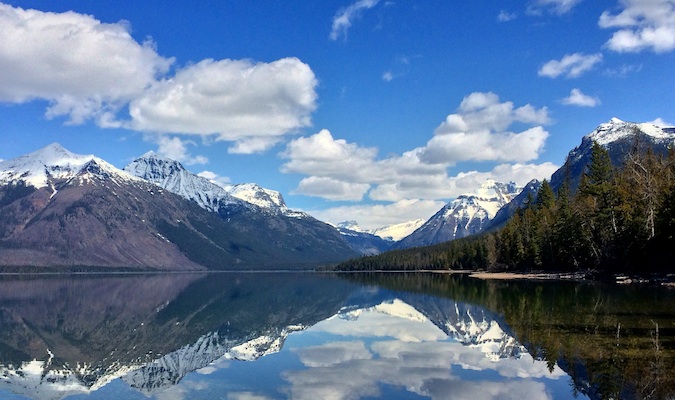
Get my best stuff sent straight to you!
Pin it on pinterest.
- TODAY Plaza
- Share this —

- Watch Full Episodes
- Read With Jenna
- Inspirational
- Relationships
- TODAY Table
- Newsletters
- Start TODAY
- Shop TODAY Awards
- Citi Concert Series
- Listen All Day
Follow today
More Brands
- On The Show
10 pedestrian-friendly U.S. destinations worth exploring

Now, more than ever, vehicle-free family vacations are in vogue. Seeing a new place sans car not only makes financial sense, it's also better for the environment. The tricky part, however, is knowing where to go. Some cities have better public transportation networks — including free shuttles — and others are more pedestrian-friendly .
Whether you're looking for a budget-friendly beach vacation or places to take the kids before they're grown , here is a short list of destinations where you not only don't need a car, but you won't want one either.
Best U.S. destinations to visit that don't require a car
San diego, california.
Why you should go: Since San Diego's airport is located just three miles from downtown, it's an easy 10-minute Uber or "Airport Flyer" ride to most hotels and restaurants. Once in the heart of downtown, the city's neighborhoods are laid out in an easy-to-navigate grid of numbered and lettered streets. They're very walkable, but you can also take the FRED (aka Free Ride Everywhere Downtown) shuttle. If you're venturing beyond downtown, hop on one the city buses or trolleys servicing attractions like the award-winning San Diego Zoo and San Diego Air & Space Museum . Care to visit Coronado and Ocean Avenue? Take one of the many ferries that cross San Diego Bay.
Where to stay: It's hard to beat the location of the Hilton San Diego Bayfront (rates from $415), which has water views and is within walking distance of The Rady Shell at Jacobs Park . If you're on a tighter budget and want to be treated to " the world's nicest pillow ," book a room at Days Inn by Wyndham San Diego Circle .
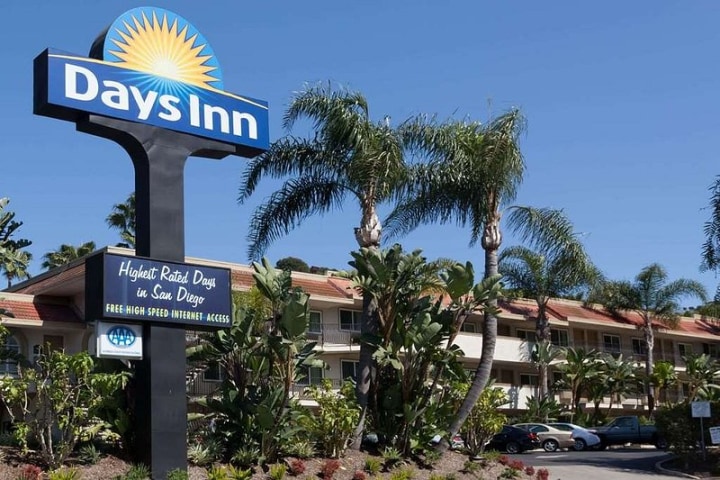
Days Inn by Wyndham San Diego Hotel Circle (Per Night)

Shop From Cancun to Costa Rica, the resort is the destination at these new all-inclusive spots for families
Denver, colorado.
Why you should go: Thanks to Denver's A Line , downtown is just a 30-minute train ride from Denver International Airport. Getting around downtown Denver is even easier. Simply hop on the free 16th Street Mall Ride or grab a Lime scooter. (In the next four years, as many as 675 parking stations will be installed in the city .) You can also rent bikes of every kind from Christy Sports and explore via metro Denver's 850 miles of paved urban bike trails. Feel like staying on foot? Book a Denver Food Tour or a Twilight Ghost Tour of Capitol Hill .
Where to stay: Kimpton Hotel Born (rates from $300) offers complimentary use of its fleet of bikes. If you want to be closer to the colorful RiNo District (pro tip: take the Denver Graffiti Tour ), crash at the new and uber hip Catbird Hotel .

Catbird Hotel (Per Night)
Big sky, montana.
Why you should go: After flying into Bozeman , book a scenic bus ride on Karst Stage to Montana's premier ski resort town. That said, the aptly-named Big Sky is beautiful year-round. If you're staying at Big Sky Resort , one of the largest ski resorts in the world, take advantage of the free shuttle that goes into the town center. In addition to skiing and snowboarding, try a ziplining tour over the Gallatin River or a guided backcountry safari of nearby Yellowstone National Park . There are also miles of hiking and mountain biking trails running through the surrounding Spanish Peaks.
Where to stay: The Wilson Hotel (rates from $400) is conveniently located in the heart of downtown Big Sky, plus it allows pets. If you want to stay slope-side, get a room at The Lodge at Big Sky .

The Lodge at Big Sky (Per Night)
Lexington, kentucky.
Why you should go: Home to 400+ horse farms and 14 of the state's largest bourbon distilleries, there's plenty to see and do in this oft-overlooked Southern city. Take an Uber or Lyft from Bluegrass Airport, and once you're downtown, plan on walking everywhere or renting an e-bike . This fall, the city will debut a $35.5 million walking trail connecting downtown Lexington with the Distillery District. To visit one of the region's horse farms, book a half-day bus tour .
Where to stay: The eclectic 21c Museum Hotel is half boutique hotel, half contemporary art museum. It's also just steps away from the city's best restaurants. If a high-rise is more your style, the Hilton Lexington Downtown (rates from $150) is a great option and just steps away from the Mary Todd Lincoln House .

21c Museum Hotel Lexington (Per Night)
Pigeon forge, tennessee.
Why you should go: Pigeon Forge is home to the country's third-largest rural transit system , and the trolleys run 362 days per year with day passes costing just $3. Although Pigeon Forge is a small town (pop. 6,100), every year it welcomes 10 million visitors who come for attractions like the Titanic Museum , Pigeon Forge Snow (an amusement park with snow year-round) and the Rocky Top Mountain Coaster . One of the reasons Pigeon Forge is so popular? It's less than a day's drive for two-thirds of the country's population living east of the Mississippi.
Where to stay: The highly-rated Arbors At Island Landing Hotel & Suites (rates from $145) has the most to offer families in terms of activities (think bonfires, fishing, horseshoes, etc.). Meanwhile, the Music Road Resort Hotel boasts two on-site waterparks.

Music Road Resort Hotel (Per Night)
Fort lauderdale, florida.
Why you should go: Sunny Fort Lauderdale has more than 150 miles of navigable waterways, so it often makes the most sense to get around by boat. The city's Water Trolley , which services the New River, is free and operates daily. Visitors can also buy a day or evening pass for the Water Taxi, which has 11 stops and allows you to hop on and hop off at your convenience. If you want a boat ride with narration (so you know whose yachts and mansions you're sailing by), ride the Jungle Queen Riverboat . Another great way to get to know the city is by Segway tour .
Where to stay: Located on Las Olas Blvd, Hyatt Centric Las Olas is within walking distance of restaurants, nightlife and museums including the Museum of Discovery and Science . The hotel also has a Tesla house car that will take you anywhere within two miles of the hotel.
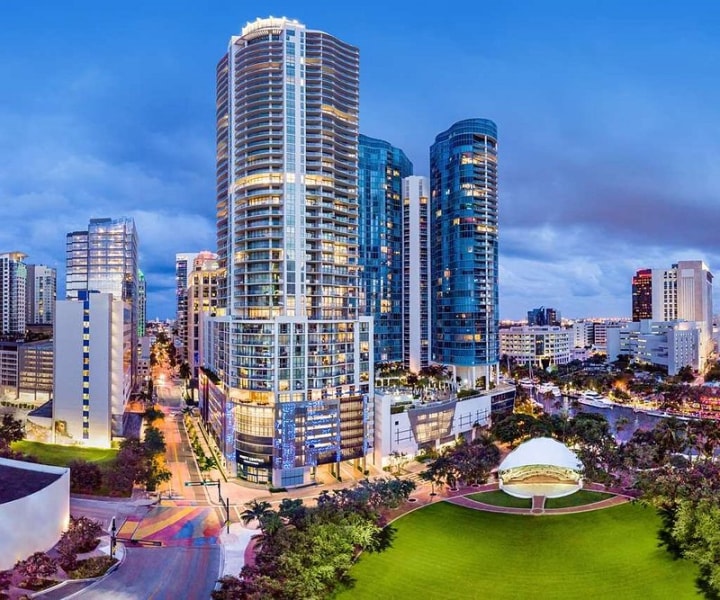
Hyatt Centric Las Olas Fort Lauderdale (Per Night)

Shop 19 family vacation ideas your teenager will actually be excited about
Williamsburg, virginia.
Why you should go: Thanks to Amtrak, it's easy to reach downtown Williamsburg if you live anywhere along the Northeast Corridor. Colonial Williamsburg , the area's number one attraction, is located just a mile from the train station. If you have any interest in paranormal activity or local history, book a bestselling ghost tour where your guide walks you by some of Williamsburg's most haunted sites. Another must for history buffs is Jamestown Settlement , just a 15-minute ride via Uber from downtown. More of an adrenaline junkie? Busch Gardens is also just a 15-minute Uber ride away.
Where to stay: Woodlands Hotel & Suites is just steps away from Colonial Williamsburg's Visitor Center. If you want resort amenities, including access to a championship golf course and bike rentals, stay at Kingsmill Resort (rates from $279).
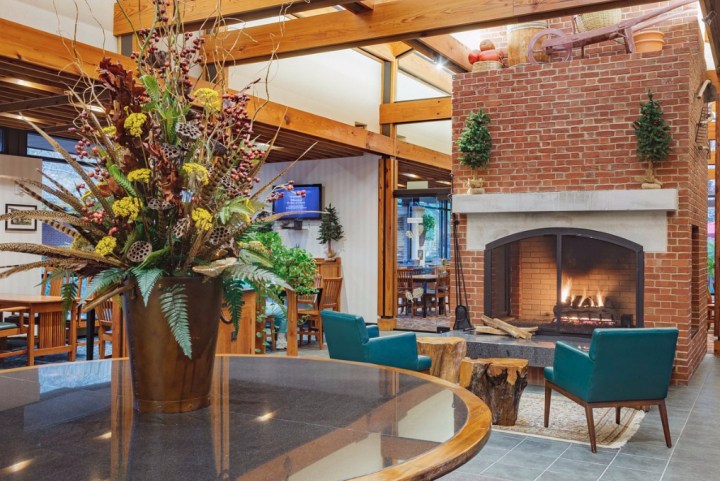
Woodlands Hotel & Suites (Per Night)
Grand rapids, michigan.
Why you should go: According to WalkScore.com, Grand Rapids is an impressive 92 out of 100. Downtown, visitors can choose from a dozen hotels, all within walking distance of six museums, 35 live music venues and more than 130 restaurants. (There's even a climate-controlled indoor skywalk system, making it manageable in the winter.) Must-see sites for families include the Frederik Meijer Gardens & Sculpture Park , John Ball Zoo and the Grand Rapid's Children's Museum . Download the GR Walks app for free-self-guided walking tours, and when you're tired of walking, don't worry. The Downtown Area Shuttle and the driverless May Mobility Shuttle are both free.
Where to stay: The pet-friendly Morton Hotel is right downtown and just steps away from the Grand Rapids Art Museum . Across the river, the Holiday Inn (rates from $180) is a more affordable option and is close to the Gerald R. Ford Presidential Museum and the Grand Rapids Public Museum .

Morton Hotel (Per Night)
Greenville, south carolina.
Why you should go: Downtown Greenville , home to one of the country's most idyllic and pedestrian-friendly main streets, is just a 15-minute Uber ride or private transfer from Greenville-Spartanburg International Airport. The majority of hotels, museums, galleries, restaurants and shops are all concentrated within a few city blocks of downtown. Don't feel like walking? Hop on the free trollies servicing downtown, rent a bike (the Swamp Rabbit Trail is 13.5 miles long) or sign up for a Segway tour . Whatever you do, don't miss the waterfalls at Falls Park on the Reedy .
Where to stay: The charming Swamp Rabbit Inn has bike rentals on-site. If you want amenities like a bar, free breakfast and a fitness center, stay in the heart of downtown at the Hampton Suites (rates from $135).
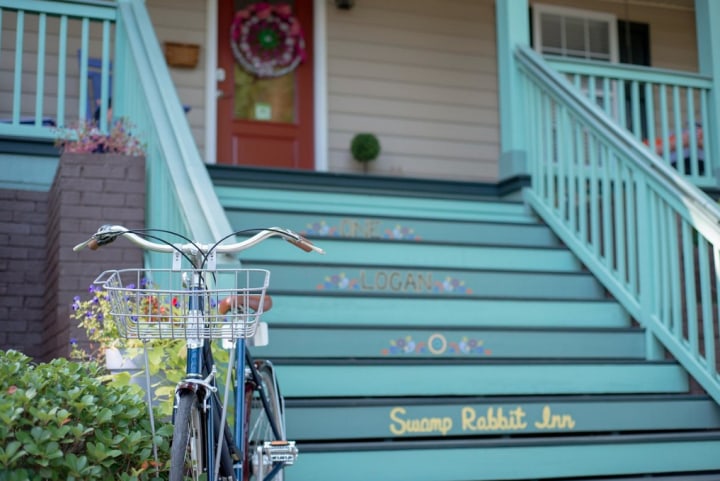
Swamp Rabbit Inn (Per Night)
New york, new york.
Why you should go: The Big Apple boasts the largest public transportation system in the country. Not a fan of the subway? Taxis and pedicabs are everywhere, especially around Central Park and Times Square. There are also plenty of hop-on, hop-off bus tours , and stations where you can rent bikes and scooters. If you want to check out New York's largest Chinatown in Queens or observe the playful otters at the New York Aquarium in Brooklyn, simply take the scenic East River Ferry. Some of the best views of Manhattan's iconic skyline are from the river.
Where to stay: The new Motto by Hilton is conveniently located in Chelsea's Arts District (home to 300 art galleries) and within walking distance of The High Line, Chelsea Market and Chelsea Piers Sports and Entertainment Complex. Hyatt Union Square (rates from $202) meanwhile, has complimentary bikes and is close to miles of bike paths.

Motto by Hilton (Per Night)
The perfect itinerary for an epic USA roadtrip (48 states at once)
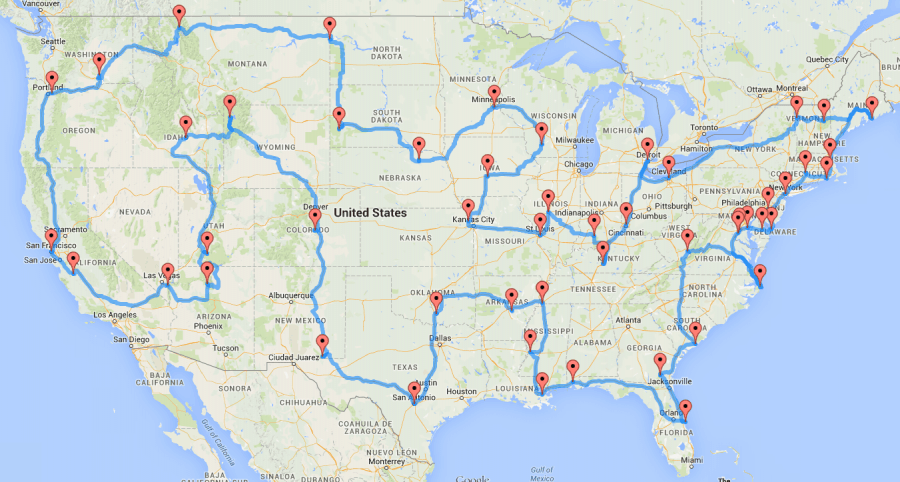
- Post author: Andrew D'Amours
- Post published: December 28, 2022
- Post category: Travel inspiration / Trip itineraries & destination discoveries
- Post comments: 23 Comments
Do you like roadtrips? They happen to be a very American tradition and we found the perfect itinerary to visit every state in the continental USA during 1 epic roadtrip. A great trip idea for those who have a lot of time but want to stay closer to home .
Personally, I love roadtrips and I hit the road as much as I can, despite also being an aviation geek: you can like both, right? What matters is traveling and seeing new places , no matter how.
So here are the maps and details of the 2 itineraries that allow you to see all the lower 48 states at once, depending on your travel preference.
Basics of the 2 epic USA roadtrip itineraries
The USA is a huge country, almost as big as Europe (it’s even larger than Canada when considering land area alone).
So the USA has a lot of variety in terms of landscapes, but even in terms of culture too (even if many who aren’t from the country don’t realize that).
If you aim to eventually visit every state, any 1 of these 2 itineraries is a great way to almost all of them at once. The only 2 states you’ll have left to visit after this roadtrip will be Hawaii and Alaska.
There’s a version for national parks and points of interest and a version for cities.

I’m on the quest to visit all 50 states myself (in addition to also visiting every country obviously), and I’m not doing too bad with 47 already.
But let’s just say it would’ve been much quicker to get to 48 at once with this roadtrip instead of having to do it over dozens of trips.
Here are the details.
48-state roadtrip – national parks/points of interest version
Here’s a map of the 1st itinerary.
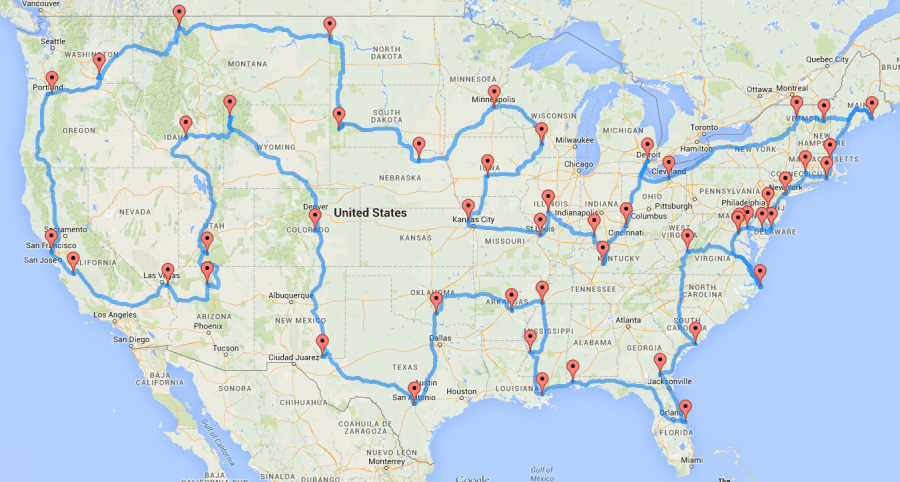
It was conceived by American Ph.D. student Randy Olson, on his blog , and it was done scientifically to optimize the routing: each stop represents a national park or a point of interest.
So you’re not just seeing every state, you’re seeing cool parts of every state (which sadly wasn’t our case in North Dakota during our very random 1200-miles-nonstop-in-2-days Flytrippers roadtrip across the Midwest just for fun).
Good times. Roadtrips always make for great stories.
Anyway, the itinerary has also been optimized to be as efficient a route as possible to see all 48 states, so you can rest assured you won’t be wasting any time.
If you only stop to sleep, you can complete this roadtrip in only 9 days, but we recommend taking at least a couple of weeks to explore all these places obviously.
And gas is significantly cheaper in the US in case you were wondering. You can start anywhere, it’s a continuous loop, and it passes through many spots near the Canadian border.
You can even take a shortcut from Michigan to Vermont through Canada, as the stop in Cleveland is only to keep Americans without a passport from crossing into the Great White North.
Here is the complete list of all 50 landmarks (48 states + Washington, DC + a bonus stop in California):
1. Grand Canyon, AZ 2. Bryce Canyon National Park, UT 3. Craters of the Moon, ID 4. Yellowstone National Park, WY 5. Pikes Peak, CO 6. Carlsbad Caverns National Park, NM 7. The Alamo, TX 8. The Platt Historic District, OK 9. Toltec Mounds, AR 10. Elvis Presley’s Graceland, TN 11. Vicksburg National Military Park, MS 12. French Quarter, LA 13. USS Alabama, AL 14. Cape Canaveral Air Force Station, FL 15. Okefenokee Swamp Park, GA 16. Fort Sumter National Monument, SC 17. Lost World Caverns, WV 18. Wright Brothers National Memorial Visitor Center, NC 19. Mount Vernon, VA 20. White House, Washington, D.C. 21. Colonial Annapolis Historic District, MD 22. New Castle Historic District, DE 23. Cape May Historic District, NJ 24. Liberty Bell, PA 25. Statue of Liberty, NY 26. The Mark Twain House & Museum, CT 27. The Breakers, RI 28. USS Constitution, MA 29. Acadia National Park, ME 30. Mount Washington Hotel, NH 31. Shelburne Farms, VT 32. Fox Theater, MI 33. Spring Grove Cemetery, OH 34. Mammoth Cave National Park, KY 35. West Baden Springs Hotel, IN 36. Abraham Lincoln’s Home, IL 37. Gateway Arch, MO 38. C. W. Parker Carousel Museum, KS 39. Terrace Hill Governor’s Mansion, IA 40. Taliesin, WI 41. Fort Snelling, MN 42. Ashfall Fossil Bed, NE 43. Mount Rushmore, SD 44. Fort Union Trading Post, ND 45. Glacier National Park, MT 46. Hanford Site, WA 47. Columbia River Highway, OR 48. San Francisco Cable Cars, CA 49. San Andreas Fault, CA 50. Hoover Dam, NV
These are all very enticing attractions, for the most part. It seems I’ve only seen 14 of those, so maybe I should hit the road again after all.
How about you? Tempted?
48-state roadtrip – city version
Here’s a map of the 2nd itinerary.
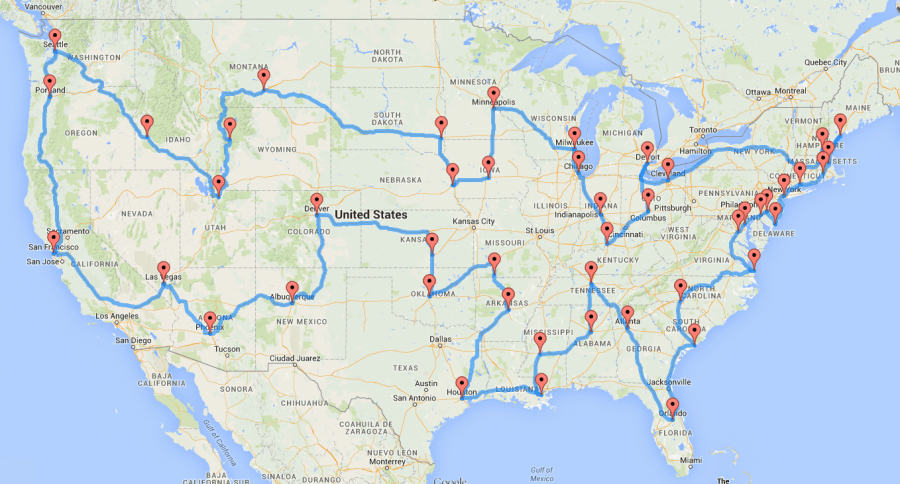
If you’re more of a city slicker, the map’s author has created a 2nd version that routes you through amazing cities instead.
It is slightly shorter but quite as impressive: it makes you go through the “Best City to Visit” in each state, according to TripAdvisor .
But you won’t have all the lower 48 states, unlike the other itinerary. That’s because no city in Vermont, West Virginia, or North Dakota made the top 400 cities to visit ranking, unfortunately. So plan on making a few extra detours if you want to hit all states at once with this version of the itinerary.
Here is the complete list of all cities:
- Oklahoma City, Oklahoma
- Wichita, Kansas
- Denver, Colorado
- Albuquerque, New Mexico
- Phoenix, Arizona
- Las Vegas, Nevada
- San Francisco, California
- Portland, Oregon
- Seattle, Washington
- Boise, Idaho
- Park City, Utah
- Jackson, Wyoming
- Billings, Montana
- Sioux Falls, South Dakota
- Omaha, Nebraska
- Des Moines, Iowa
- Minneapolis, Minnesota
- Milwaukee, Wisconsin
- Chicago, Illinois
- Indianapolis, Indiana
- Louisville, Kentucky
- Columbus, Ohio
- Detroit, Michigan
- Cleveland, Ohio
- Manchester, New Hampshire
- Portland, Maine
- Boston, Massachusetts
- Providence, Rhode Island
- New Haven, Connecticut
- New York City, New York
- Ocean City, New Jersey
- Philadelphia, Pennsylvania
- Wilmington, Delaware
- Baltimore, Maryland
- Washington, D.C.
- Virginia Beach, Virginia
- Charlotte, North Carolina
- Charleston, South Carolina
- Orlando, Florida
- Atlanta, Georgia
- Nashville, Tennessee
- Birmingham, Alabama
- Jackson, Mississippi
- New Orleans, Louisiana
- Houston, Texas
- Little Rock, Arkansas
- Branson, Missouri
I do a little better on this list, with 31 already visited. You can see I love cities. How about you?
Want to get more content to discover awesome destinations?
Sign up for our free newsletter.
If you were looking for an excuse to go on a roadtrip, this is it. And since we always enjoy giving you more for your money, we think 48 states instead of only 1 or 2 is something you’ll enjoy!
What’s the coolest roadtrip you’ve ever been on? Tell us in the comments below.
See the deals we spot: Cheap flights
Explore awesome destinations : Travel inspiration
Learn pro tricks : Travel tips
Discover free travel: Travel rewards
Featured image: The itinerary (image credit: Randy Olson)
Original publication date: May 29, 2018
Share this post to help us help more people travel more for less:
Andrew D'Amours
You might also like.
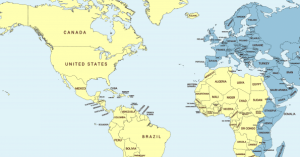
World Map Divided Into 4 Sections Of Equal Population
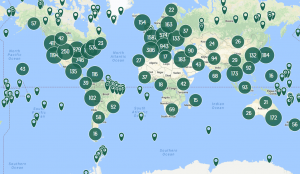
An Interactive Map of 11,000 Unique Sights All over the World

10 tips for a trip to the National Parks in the Southwestern USA
This post has 23 comments.
Hello Andrew, the PHD student suggests in the 1st Itinnerary that the one stop to make in Washington State is the Hanford Nuclear Reservation?! Flat out, that is a terrible idea. It is in the middle of nowhere, I am just shocked it’s mentioned. Out of all the beautiful and amazing places to see in such a diverse state as Washington, a Nuclear Site was chosen? Surely this student could have done so much better. Thank you for allowing comments.
Having been all around the Olympic Peninsula, I agree that’s there are better stops. But my understanding is that he really optimized for the quickest way to do all 48 and had to choose a point of interest that wasn’t too far off that optimal path, hence that choice (I think).
thanks for sharing this information with us.
I have taken a road trip from California to the the most northeastern part of theUS. west Quaby light house. it was my 1st trip across the us. .I seen so many amazing places.
Quite the drive for sure! Must have been epic.
Why do Americans always think the Statue of Liberty is in NY? it is in NJ. I’ve done road trips now that have taken in 39 states. Here’s a quiz to see how well you know the USA: Which state has only one syllable? Only one city has been name-checked on the moon. In which state is it? Which is the most Northerly of the contiguous states? In which state were Tennessee Williams and Elvis Presley born? Which was the last of the contiguous states to be admitted into the USA? Which four states all share a border with each other? Which state has the lowest population? Twelve cities are name-checked in “Get Your Kicks on Route 66” but only three states. Which? Which state has the longest name? Which two states have the most borders with other states? In which state is the geographical centre of the USA – and which one if you exclude Hawaii and Alaska? Which of the states of the USA has respectively the most Northerly, Southerly, Easterly and Westerly points?
The official Statue of Liberty address is Liberty Island, New York, NY, 10004.
Wow, these comments are very rude for no reason. Thanks for the article, maybe when I graduate from college I’ll consider hitting part of one of these itineraries.
“it’s a huge country (even larger than Canada when considering land area alone).”
Canada – 3.855 million mi² USA – 3.532 million mi² Where does this math fail you?
Where did reading fail you :P? It explicitly says “ when considering LAND area alone ” The quote you copied literally has a link provided under “even larger than Canada” and if you read that, it explains how Canada is only larger than the US due to water area being counted 🙂
There is no stop in North Dakota on the city version. You should stop in Fargo after Billings and before Sioux Falls
I’m 46 years old .. I have been to all 50 states and I’m 17 away from all 50 twice .. I have driven to 47 .. flown to Alaska, Hawaii and Washington..
Wow! That’s impressive :O
This is awesome
This is inspiring! Thank you for sharing!
“this roadtrip in only 9 days“ is extremely false statement. It is only 9 days if you are driving non stop, no breaks to even get out of your car, get gas, or actually see these places. From start to finish drive time it is 225 hours, 16 minutes = 9 days. Wow. Take some time to enjoy the view.
Yes, that’s what we said too 😛
Thanks for the tip 😊
Do you know the total distance of this itinerary? At what moment of the year doing this trip would be the best? Thanks!
Hi! It is 13,699 miles (22,046 km) for the landmarks itinerary and 12,290 miles (19,780 km) for the city version. You can even have the Google Maps links on the creator’s original post (I’ve reposted the link below). As for the timing, I guess it depends on your preferences, but I’d want to avoid that top half of the country (so half the itinerary) in the winter for sure! http://www.randalolson.com/2015/03/08/computing-the-optimal-road-trip-across-the-u-s/
Crappy itinerary! Does not even include Zion National Park… and so many stops in the North Eastern states?? Nobody cares about those places except maybe a couple of places.
As explained, the PhD student who built the itinerary wanted to have one stop per state, and there are many states in the North-East so that’s why there are many stops there. I agree that Zion is an iconic spot, but his goal was also to optimize a routing that was as short as possible so that’s why it’s billed as an itinerary to see all lower 48 states at once and not an itinerary to see *the best spots*. But those interested in doing this can definitely adapt it and add many interesting stops for sure 🙂
Curtis, you are crappy. Obviously this is meant as a guide that can be adapted to add spots. I think it’s awesome.
Leave a Reply Cancel reply
How to Travel Without a Car in North America
Is it possible to get around without your own wheels.

North America is vast. This makes Canada and the USA much harder to travel without a car than other countries.
We recently backpacked across Canada and down into the USA without having our own vehicle. When we announced we were going to do this, many people were skeptical. Would we really be able to make it around without having our own car?
These are some of the methods of transport we relied on to travel without a car, in descending order from most expensive and most comfortable down to the cheapest and most unpredictable.

Flying is obviously the easiest way to get from city to city in North America, but unfortunately its not usually the cheapest. If you really need to get somewhere fast and don’t mind paying a bit extra then it might be worth booking a flight. We only used air travel once during our trip. A plane between Halifax and Newfoundland turned out to be our best option when we needed to be in St John’s on short notice.
Skyscanner is great for comparing flight prices, you can even be do a broader search if you are flexible with the dates you will be travelling or destination.

The train is a really great way to travel without a car. It is often more expensive than the bus but you will be much more comfortable and usually get a much better view. Our 35 hour train journey between Winnipeg and Toronto gave us some amazing views and we comfortably slept through the night. Most major cities in North America are linked up to the train network. Trains can often take a lot more time because passenger trains sometimes have to give way to freight trains using the same tracks.
VIA Rail is Canada’s passenger train service, make sure you look at their deals page , you can often save hundreds of dollars if you are flexible with your travel dates.
Amtrak is the passenger train service for the USA, the USA network is a lot more extensive than Canada’s and you can often save money by booking early.
You can also buy monthly passes for each if you plan on travelling entirely by train.

This is another option for budget travel without a car. Long distance bus travel in North America can be tiring, but it is often the cheapest guaranteed service you can use and is usually reliable. The buses can sometimes stop in every possible location along the way making the journey seem to last forever.
The buses sometimes have power outlets and even WIFI if you are lucky, although you are never guaranteed any of this and might end up on a bus that has seen better days. We rode the bus on a 24 hour journey from Virginia to New Orleans. most of the journey was great but it was split into 4 transfers and sleeping was not too easy when the bus was full on the return journey. (Although it saved us around $700 so was definitively worth it)
Greyhound US and Greyhound Canada are the biggest country wide bus service, you can get monthly passes that you can use in both countries. Most Greyhound stations have places to eat and sometimes showers
Megabus is usually a good budget option but there routes are limited to certain areas. (We once took a trip to Knoxville, Tennessee on the Megabus and it only cost $1.)

4. Rideshare
Ridesharing is a win-win situation. Somebody making a journey has seats and will drive you to where they are going for an agreed price. The drivers are usually just trying to subsidise their gas costs so you can usually get quite far for your money. The downside is reliability as drivers can let you down and sometimes you may never find someone heading to the place you need to go.
We shared rides many times while we were in Canada as it was always the cheapest option between cities when we could find someone heading in the same direction. We only had one bad experience and that was due to mechanical failure, we found ourselves stranded in a small town in British Columbia with our unfortunate driver whose engine had blew up!
Kijiji.ca is by far the best place to find rideshares in Canada, you can even post an ad requesting a ride and drivers can get in touch with you. craiglist.com is usually the a good place in the US although different states might have better local sites for you to use.

5. Hitchhike
Hitchhiking is nothing new. It’s not the most reliable way to travel, of course. You never know how long you’ll be standing at the side of the road. However, if luck is on your side you can travel without a car and not spend a cent. Safety is always something to consider. But, if you use your instincts and refuse rides when you don’t feel comfortable, you’re likely to be okay.
We found older people were more likely to pick us up. They used to hitchhike and nostalgically wanted to pay it forward. Sometimes it was the younger types who were quite laid back and enjoyed the company on their journey. Always check local law to find out if you are allowed to hitch hike. If done right hitchhiking can be the best way to travel without a car in many countries throughout the world.
Hitchwiki is a great resource for anybody wanting to Hitchhike, it has tips for different places and information on getting picked up and overall safety.
Do you prefer to travel without a car?
Whilst travel without a car in North America isn’t ideal, it is not as hard as you may think. If you have any questions, tips or experiences you would like to share, please leave a comment below.
Related Articles

What You Should Know When Visiting Krakow, Poland in the Winter

Fall in Ljove with Ljubljana: A Guide to the Slovenian Capital

What to Expect in Thessaloniki: Greece’s Second City

14 Things I Love About Bangkok
23 comments.
Nice post here. Sounds as if there are some good alternate travel options for North America. As someone who has started writing a bit about travel and snapping mostly local photos, but sparking an interest in traveling longer distances, I am most curious about Canada and the options of camping there. Do you have any favorite camping spots you would recommend? Would you know if there are those who do not require a vehicle to camp. Can one enter by foot, such as a hiker’s camp?
Great tips! I would also like to add Southwest.com for cheaper flights around the US. Their flights don’t appear in flight search engines to the best of my ability. I think using public transportation is easier in cities, the challenge is when you want to reach nature, like national parks. Some parks have shuttles from nearby towns/cities and inside the park, and I would love to see more parks adopting that possibility – not only will it help additional people get to the parks, but it’s much more environmentally friendly.
Ayelet Hametayelet
This article was very useful to me because I don’t own a car at this time and just love to travel. I especially appreciated the links leading to rideshare and hitchhiking since these are methods I haven’t tried before and that sound really useful. As for flying, kayak.com can also be really useful, as can student universe for people who are still students. Thank you for these tips!
Ciao anch’io vorrei tanto andarci…
- Pingback: Digital Nomad Lifestyle: A Year of Our Life Working and Travelling | Travel Resource
This article was very useful – I’m planning a cross country trip from New York to Vancouver, so hopefully we’ll be able to utilize some of this information. One thing we probably won’t be trying is hitchhiking though – it’s just too dangerous, and I’ve seen too many movies where things go wrong.
Hitchhiking has risks of course but it is not as dangerous as the movies would lead you to believe. We actually recently wrote a post about horror movies and travel: http://global-goose.com/wingtips/movies-people-afraid-to-travel/
I have lived most of my life traveling without a car. I really love this article, because it just reminds me of the passion people have to go by any means necessary to travel. This is great. I think my best form of transportation is flying and commuter train. When you are actually in the city of your choice, of course things like the bus, help you to see the sights and meet the people faster. It’s almost imperative to make most of your vacation happen outside of the car, so you can engage with the culture.
- Pingback: How We Save Money While Traveling - Our Digital Nomad Lifestyle | Global Goose - Digital Nomad Travel Resource
- Pingback: Public Transportation: Fantastic Adventures, Misadventures and Tips - All Colores | All Colores
I recently punished myself with a 54 hour bus ride from Calgary to Toronto
Cheap ($175, or about $0.04 a kilometre) Got to see the country from the roadside Made friends along the way
bad food Sleep … what’s that? Some people can be negative or sketchy
- Pingback: Western Canada Travel: From Mountain Wilderness to Big City Sights
Hi, I am Shafiq and I work for an online agency referred to as “Futuristic Artists”.
I was intrigued in your site because of the exquisite travel related oriented info and sensations it displayed.
I was wondering if you allow sponsored post on your site? If yes, kindly reply me with the best price per post.
Regards, Shafiq
Great! Thank you for your post!. We also love to travel a lot and recently traveled by the car along US Pacific Coast. Here is our first day of the 10-day travel trip https://alfilatov.com/posts/road-trip-northwest-coast-day-1-10-long-beach-cannon-beach-yaquina-lighthouse/ . Check it out!
Very useful post, i think the most important things is the title an make it the easier to read. IQOS Heets UAEiqosheetsuaevape-uae
Hi. Great article. Now thinking about traveling to that area. Been to Dubai and smoked a great bong from Fuma there. Now I want to find the same good bong
Hi. Great article. Now thinking about a trip to this region. But first I want to order the original shisha from Dubai to try shisha from the country where it originated
Late to the game.
I don’t have a driver license. I live in a big prison, Los Angeles, for the past 4 decades. Yes, in 95% of USA major cities, without cars is like living in prison.
I wish LA and other major cities are like New York and Vancouver. Not within next 200 years.
Anyway, when I traveled to DC, SF, Baltimore and Vancouver, I really loved the place because I did not need the cars.
My friends take me to travel National Parks once a while.
Besides that, I join the tours ago. 10 years ago, I usually joined Asian (Taiwanese/Hong Kong/Chinese) tour groups. They were so affordable that you wander did anyone make money. My dad dropped me off at tour bus pick area. On the way back, the travel agent pick me up. It was $5. The travel agent is 5 miles from my home. My home is 2 mile from tour bus area. No, he did not make money, but he entice the people to sign up the tour for this service. Did he make money that I sign up for the tour. The qualities were so bad, but what can I complain for that prices. Recently, I checked the tours from those websites. The prices had gone up twice. The qualities had come down from bad to 200% worst. I started searching for the quality tours. They are not cheap. That is the problem. It is cheaper to drive and stay in 7 star hotels than sharing rides with others.
I went to New York when I was little. It has not been on my radar since I want to travel other place. However, I am thinking going to New York, Niagara Falls, Thousand Lake, and beyond. Ok I am too greedy. Besides New York and Niagara Falls, this requires cars or tour groups.
Couple challenge projects on my list 1) Chicago: You don’t need cars. Try the ambition on Great lakes: Not doable even on tour groups. Ok, there are cruises. I know non car drivers have to pay a lot more for not having car on traveling, but Great Lake Cruise is so high ended. I will stick with Chicago only 2) Portland: How many places I can go without join tour groups 3) Seattle: Outside downtown downtown downtown areas, how many places I can go without join tour groups 4) Williamsburg and Richmond: I am poor in bike, but I know there is bike for dummy path. I want to try. Some places, I need uber. I want to challenge myself on how far I can go on 2 legs and F grade skill biking 5) Acadia National Park: One of few santcuary places outside of New York that I don’t need cars 6) Train rides in Colorado are interesting. However, either you have to walk 100+ miles or drive to reach each station. That is another problem. Train stations are for fun not for transportation. Anyway, I found some tour groups
Of course, if my friends decide to go to those places, I will join them. I have enough struggles living in LA. Do I want to stress myself more on my vacation.
In USA, except New York, Chicago, DC, and SF, you need cars. For me hitch hike is still driving (by someone). Just like my friends take me to many places. No, LA is still hell for non car drivers despite what many people said. I want to try Japan, Korea, and many European countries. That should be fun. I remember on way back from Europe to LA, a German gal seating next to my friend, she never drove in German, and she was ready to pick her rental car at LAX
Greyhound, Megabus, and other bus companies are the finest ways to travel between cities in the United States. We have commercial and private planes, railroads that are fewer but still exist with Amtrak, buses, and so on.
A very excellent blog post.Thank you so much for such a well-written article.
Traveling without a car has become increasingly popular in recent years and for good reason. Embracing alternative modes of transportation not only reduces carbon emissions but also allows travelers to experience destinations in unique and immersive ways. From exploring bustling cities with efficient public transit systems to venturing through the picturesque countryside aboard scenic trains, the options are diverse and exciting. Moreover, hiring a private driver in uk has become a convenient option for travelers seeking personalized and luxurious experiences, enabling them to navigate the country’s charming landscapes and historic landmarks effortlessly. Embracing car-free travel not only benefits the environment but also opens doors to enriching and memorable adventures that may have been otherwise overlooked.
Great! Thank you for your post!.
Leave a Reply Cancel reply
Your email address will not be published. Required fields are marked *
Notify me of follow-up comments by email.
Notify me of new posts by email.
I moved all of my belongings across the US 5 times in a year without a car. Here are 6 things that I wish I'd known sooner.
- I relocated five times in one year, and I did it without a car thanks to these tips.
- Getting familiar with airlines' luggage policies and pairing down your belongings are essential.
- Keep an eye on rideshare apps throughout the day to gauge how much a trip will cost ahead of time.

I moved on my own for the first time in 2020 after deciding to leave my marriage.
Little did I know, I was going to move a total of five times across four different states that year, and I was going to do it all without access to a car.
Here are the tips I wish I knew before my first move.
The moving process can be stressful, so don't be afraid to ask for help
Moving without a car requires you to be resourceful, and that includes tapping on all expertise possible. After all, moving can be a lot for one person to handle on their own.
The first time I packed up my belongings, I was so focused on the logistics that I didn't ask my friends or family for help or advice. In hindsight, that was a mistake.
Organization isn't my strong suit, so my packing strategy was flawed , to put it kindly. My best friend is an expert at putting together suitcases and cleaning up messes, so I should've asked her for assistance earlier.
If I had, I could've saved time, space, and money.
If you're flying to your new home, factor the airline's luggage policy into your packing strategy
Each airline has its own policy when it comes to luggage. Do your homework ahead of time to form a packing strategy that allows you to bring the items you need and avoid unexpected bag fees.
I prefer to fly Southwest Airlines when I move since passengers can check two bags free of charge. I used to try to stuff all of my belonging into the two suitcases, which would often result in an overweight baggage fee of $75.
Related stories
Now, I have a different game plan. Each additional checked bag costs $75, and I pay for two. It's the same price I used to pay for my two oversized check bags. Using this method, I can pack everything I need.
Pair down your belongings as early as possible — you'll thank yourself later
I overpacked the first time I moved , which made relocating much more challenging. Without a car, I didn't have the luxury of stuffing things in backseat crevices or trunk corners. I knew that every inch of my suitcase was precious, but there were still some items I couldn't part with.
I paired down my belongings with each move. It became clear which items were essential to my survival and my happiness. I held onto my favorite books, workout equipment, and childhood mementos.
Getting rid of things took me time, but I recommend doing so earlier in the moving process. You'll thank yourself down the line.
Before you throw away items that you don't need or use, consider selling or donating them instead
I have a habit of holding onto things that I should've tossed years prior. Some of these items — like a decade-old laptop charger — probably aren't useful to anyone, but others are worth selling or donating.
Space is precious during a move, so make sure everything you carry serves a purpose. If it doesn't come in handy for you, it might for someone else. So think twice before tossing it in the garbage.
For example, I'd amassed a sizable makeup collection that I brought with me on my journey. I wasn't using most of the products, many of which were brand new, so I ended up selling over 100 eyeshadow palettes .
Know the location of the nearest medical care
If you don't have a car, living too far away from emergency medical care can be risky.
Before committing to move to a location, I always try to make sure that there's a doctor or hospital within walking distance or an affordable rideshare drive away.
Test out rideshare apps to gauge prices and wait times
When I can't use public transportation or walk, I rely on rideshare apps. I've found that the cost of these trips vary depending on location.
Once, I arrived in a new city and was shocked that the rideshare from the airport to my new home was more than $100, a huge jump from what a similar route cost in my previous destination .
Rideshare rates also fluctuate throughout the day, so a 2 p.m. trip is likely priced differently than a 2 a.m. trip.
I've found it helpful to check the apps, even when I don't need a ride, to get an idea of how much a trip would cost at a variety of times. From there, I make sure to budget double the amount of money in case of any price surges or other unexpected hiccups.
When you buy through our links, Insider may earn an affiliate commission. Learn more .
- Main content
United States without a car

- 1 Understand
- 2.1 Better served areas
- 2.2 Particularly poorly served areas
- 3.1 Intercity
- 6 By bicycle
- 8 Good cities
- 9 Difficult cities
- 10 Other popular destinations

The United States of America is often called the land of the automobile. It has more than a quarter billion cars on the road (roughly 25% of all cars in the world ), more than any other nation, as well as the highest number of cars per capita of any non-city-state country. Most Americans' primary form of identification is a driver's license. Consequently, car-dependent settlement patterns are more extreme and more the norm in the U.S. than anywhere else. Outside of certain cities, car ownership is widely assumed to be the default.
Still, many travelers want to get around without a car , whether for lack of a driver's license, to save money , or to minimize environmental footprint . Another reason is that city driving can be quite stressful and many people want to enjoy a relaxing holiday free from even the thought of their annoying daily commute.
Understand [ edit ]
American public transit authorities struggle to obtain enough funding for even the most basic maintenance. Heavy political lobbying from car manufacturers, airlines and oil companies also means that most taxpayer dollars earmarked for transportation are used to build more roads for more cars rather than rail or buses. Finally, most middle-class Americans live in suburbs deliberately designed to exclude public transit.
Taxicabs , and in the 21st century ride hailing services , are convenient for carless people in cities and suburbs, in particular for groups up to four people. They are controversial as they have kept demand of public transit down, and contribute more to traffic congestion than buses and bicycles.
If you decide to take the plunge, you'll often find low frequencies and decaying infrastructure built on decades-old technology, and you may also find that buses and trains are dirtier than in the rest of the developed world. Another problem of American public transit is the almost complete lack of fare integration – if you have to take a bus and a train or even two buses run by different operators, chances are you'll have to pay two different fares; there is rarely a ticket valid for all transfers. By and large buses don't give change, so hold on to one-dollar bills and quarters to pay for your ride. Many cities have introduced reloadable fare cards, which might give you a discount but above all make paying much smoother.
For both local and long-distance public transportation in the U.S., detailed information is almost always available online (on individual transit companies' websites and often on services like Google Maps), making it easy to plan ahead of time.
By train [ edit ]
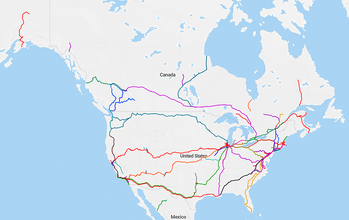
One popular alternative to car travel are the various forms of urban and intercity rail service. Unfortunately, due to successful political lobbying by car manufacturers and airlines, American rail services suffer from chronic under-investment and are slower than most counterparts in Europe and East Asia , with intercity services that often run no more than once a day. However, urban rail networks are expanding in many cities and some intercity rail lines have had minor improvements as well.
Better served areas [ edit ]
The largest cities are often served by one or several urban rail and bus systems. In some cases, public transit is the best way for getting around a city. Some of them, like San Francisco's cable cars or Chicago's L, are city icons that double as attractions in their own right.
The area best covered by passenger rail services (of all kinds) is generally the Northeast between the cities of Boston and Washington, DC , with some urban rail and Amtrak services branching out further with reasonable travel times and frequencies beyond that area. In the Mid-Atlantic states and in New England , even some less populated communities have solid passenger railway connections.
Another area that is surprisingly well covered both in terms of frequency of trains and number of stops is California . Train service between the Bay Area and Los Angeles remains slow, with the planned high-speed rail line still many years from completion. However, the San Francisco Bay Area is well covered by BART (Bay Area Rapid Transit) and CalTrain, which goes all the way south to Gilroy . With the extension of the LA Subway and light rail lines (Metro Rail), meanwhile, the notoriously car-centric Los Angeles area is now very much visitable without a car. Current trends indicate that local and regional train coverage in California will only get better in the future, with several local and statewide rail improvements either scheduled for construction or being built right now.
Another important hub for rail travel is Chicago , which was historically the main railway hub of the entire United States. Many Amtrak lines end in or pass through the city. If you are traveling by train from coast to coast, chances are you will pass through Chicago. However, few lines passing through there have top speeds much higher than 79 mph (127 km/h), even though some upgrades are planned or underway. Chicago also has a functioning and well-patronized commuter rail system that, in combination with Amtrak, offers good connections to some smaller cities in Illinois , Wisconsin , Indiana and Michigan .
Brightline is the first attempt to create a private passenger railroad in the US in the 21st century. As of 2023, it links Orlando to Miami with a top speed of 125mph (200 kph), with plans for an extension to Tampa in progress.
Particularly poorly served areas [ edit ]
Some of the most popular tourist destinations in the U.S. cannot be reached by train alone. Neither Las Vegas nor Yellowstone National Park get any regular train service. Amtrak serves 46 states: all but Hawaii ( urban rail around Honolulu went operational in 2023), Alaska (served by the Alaska Railroad – see below), South Dakota and Wyoming, the latter two entirely without passenger trains.
Generally speaking, large parts of the American heartland, in particular the Great Plains and the Rocky Mountains , are poorly or not at all served by passenger railway. Even some relatively densely populated cities in the southeastern US and the Midwest are not well served by passenger rail. For example, Cincinnati has very few passenger trains arriving and they always arrive in the middle of the night.
Even in some of the states it does "serve," Amtrak does not serve the largest city or metro area. The one route that passes through Idaho , for example, cuts through the panhandle in the extreme north of the state, missing the major population centers. The same goes for Kentucky where none of the ten largest cities have any railway service.
Alaska is not served by Amtrak but does have train service through the Alaska Railroad , which mainly serves a corridor between Seward and Fairbanks via Anchorage . Outside of that corridor, Alaska is fairly inaccessible by rail. To be fair, however, much of Alaska is fairly inaccessible in general. For example, the capital, Juneau , can only be reached by sea or air. As a matter of fact, some of the places served by the Alaska Railroad are not connected to any road, making the train the only practicable way to get there.
Heritage railways exist throughout the U.S. In some places, they do provide some transportation value, with some serving a station Amtrak also serves and coordinating their schedule with Amtrak. In most places, however, they are tourist railways or dinner trains valued more for their novelty than for transportation beyond short round trips or circular tours.
If you want to combine bike and rail, Amtrak allows you to carry your bike if you reserve space ahead of time. See their regulations on special items for details. See also here .
By bus [ edit ]
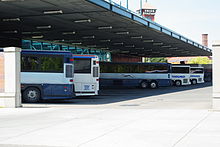
Intercity [ edit ]
While some places are served by Amtrak but not the main intercity bus companies, bus coverage is better overall than rail coverage. Some sort of intercity bus operates in all 50 states (whereas Amtrak only covers 46). Quality and price vary widely, but buses are generally less expensive than Amtrak (in the Northeast Corridor dramatically so) in exchange for a bit less legroom and less ability to walk or get food on the moving bus. Some bus companies are still or have historically been associated with immigrant communities (like the fabled Chinatown-buses or the newer Mexican-American buses) and are still mostly patronized by them. While intercity bus stops can be in all parts of town and they are often downtown as well, some are in somewhat problematic neighborhoods. Usually our city guides mention that and if that is the case, try to avoid late night arrivals or departures.
Local [ edit ]
While local bus coverage is by no means universal, most populated places in the U.S. have at least token bus service, with varying degrees of actual usefulness. Unfortunately, they are not always clearly labeled in system maps, unlike most urban rail systems. Getting around by bus in smaller cities often requires asking around or using one of the newer transportation apps. Night service, while slightly more common than it used to be, is still the exception rather than the rule, and even in major cities you may find yourself "stranded" at night. Buses in smaller cities often still require you to pay your fare to the driver using exact change. Many larger and more progressive cities have upgraded some bus lines to "proof of payment" systems or other forms of off-board fare collection, which require paying before boarding the bus and usually enable significantly faster trip times.
By plane [ edit ]
Perhaps not very environmentally friendly, but flying is — at least for long distances — a fast and practical way from place to place. Even many smaller communities can be reached by plane. In most major US cities, there is a dedicated urban rail service or at least an express bus service connecting the airport to the city center. This is often even true for cities with otherwise virtually non-existent public transit.
By boat [ edit ]
The U.S. has a large system of inland waterways. Cruising the Erie Canal , the mighty Mississippi River or a myriad of other natural and man-made waterways is a great way to get around as well as an attraction in itself. In the nation's largest state, the Alaska Marine Highway System connects Bellingham (Washington) with communities along Alaska's southern coast, and many off-the-beaten-path Alaska communities can only be accessed by boat.
Around the country's coasts, ferries play a key role in reaching certain islands and peninsulas, ranging from New York's Staten Island to North Carolina's Outer Banks to San Francisco's Alcatraz . Sometimes the ferry is an alternative to cars or buses; in other cases it's the only way onto an island. Still, in many areas ferries have been largely supplanted by bridges and airports. Hawaii has only scant service: one connecting Maui and Molokai and the other serving Maui and Lana'i .
By bicycle [ edit ]
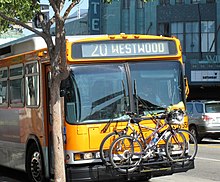
Some U.S. cities have bike-sharing services. However, the presence of dedicated bike lanes is inconsistent between and even within cities. Good cities for cycling include Portland (Oregon) , Chicago , Denver , Minneapolis/St. Paul , and a number of college towns.
Many areas have taken advantage of abandoned railroads to establish rail trails for walking and biking. The existing path of the train tracks can easily be converted into a paved trail that's nice and flat for a comfortable, smooth bike ride. Often scenic, they tend to be more for recreation than transportation, but some are practical ways to get from point A to B. A transcontinental bike trail called the Great American Rail Trail is being built from Washington, D.C. in the east to northwestern Washington State in the west. The organization coordinating its construction, the Rails-To-Trails Conservancy, claims that 50% of the trail (most of it not contiguous) is already complete, but this trail is not likely to be completed for many years.
In many cities, local buses have a bike rack on the front to allow you to combine bus and bicycle on the same trip. The bike rack is usually free to use (no extra fare).
On foot [ edit ]
Some American cities, mainly those which were already highly developed before the automobile became widespread, have downtown areas and some other neighborhoods that are good for walking. Among these are New York City , Washington, D.C. , Philadelphia , Chicago , Boston , Baltimore , New Orleans , San Francisco , Seattle , Portland , and Denver .
For the truly dedicated, there are a number of (very) long distance hiking trails, such as the Appalachian Trail or the Continental Divide Trail . However, these trails include stretches where the next human settlement is several days' hike away. It's advised that you plan any trips along these trails (for which we have articles) very carefully.
Good cities [ edit ]
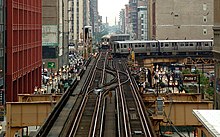
- Austin - While it is served by Amtrak and the main intercity bus operators and has a very walkable and bike-friendly downtown core (if you can stand the heat), its public transport is only so-so.
- Baltimore - Built largely in the pre-car-era, Baltimore is rather walkable and accessible by public transit (especially around downtown and the Inner Harbor). In addition, the city runs a free bus service called the Charm City Circulator that stops by most areas of interest.
- Boston - Built largely in the pre-car-era and home to one of the U.S.'s largest student populations, Boston is rather walkable and accessible by public transit.
- Chicago - In addition to a highly dense urban core and good transit coverage, Chicago is also home to a major Amtrak hub, with trains leaving and arriving from all directions. Furthermore, getting around by bike is easier than in most other US cities.
- Cleveland - Surprisingly, this Midwestern city has a decent (by US standards) public transit network with a subway/light rail system, dubbed "The Rapid" by locals, that connects most points of interest, such as downtown, University Circle/Little Italy, and the airport. In addition, there are numerous bicycle trails and bicycle paths throughout the city.
- Denver - The Mile-High City has good sidewalks for pedestrians, a strong cycling culture, an excellent public bus system that runs late, a free shuttle bus on 16th St. in LoDo (Lower Downtown) and a sprawling light rail system that connects the downtown area to many suburbs and the airport. The Colorado Department of Transportation also runs the Bustang bus service from Union Station downtown to points throughout the state, from the western slope to the front range to the eastern plains and many popular mountain resorts.
- Honolulu - the urban core has many destinations close enough to walk -- it is less than 4 mi (6.4 km) from 'Iolani palace (downtown) to the far end of Waikiki -- and generally good sidewalks. Honolulu also has a good bus system that includes many outlying areas. A rail-based public transit system is under construction, but don't hold your breath as it has been decades in the making and delayed numerous times.
- Minneapolis - Strong light rail, buses and bike lanes run throughout the city, making this one of the most accessible post-automobile cities in the nation to those without a car. The light rail system connects the airport and the downtowns of both Minneapolis and its twin, St. Paul. The downtown and uptown areas of both the Twin Cities are very walkable, too.
- New Orleans - The Big Easy has always been rather walkable, and its most notable sights are almost all downtown or close to it and thus still best reached on foot. New Orleans also has a large city bus network and is one of the only American cities whose streetcar service (partially) survived the heyday of the automobile. While generally too small and slow for residents, the streetcar network hits all the major tourist attractions and entertainment districts.
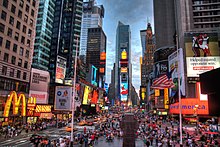
- New York City - There is hardly a place in New York that cannot be reached by foot, bus, subway, or ferry, and most residents, especially in Manhattan , choose to forgo a car.
- Philadelphia - Nearly all of the city of Philadelphia is accessible by some form of public transit (if not always especially frequent transit) and regional rail, trolley, and bus lines also serve some of Philadelphia's older (and more interesting) suburbs. After New Yorkers and perhaps Washingtonians, Philadelphians are the Americans most likely not to have a car or to use it only as a reserve vehicle rather than a primary means of getting around.
- Portland (Oregon) - calls itself the bicycle capital of America and is rather well covered by public transport - both bus and light rail - as well.
- San Antonio - While most of the city is probably one of the worst offenders in terms of car dependent sprawl, the downtown area itself where most of the visitor attractions are located is very walkable. Renting a car, however is the best way to visit some of the theme parks and other outlying attractions since its public transport is only so-so.
- Salt Lake City - Believe it or not, this city is actually well served by light rail and a comprehensive bus system, which even reaches some of the nearby ski resorts.
- San Francisco - Whether it be the historic cable cars or the more modern modes of public transit, San Francisco has long been known as a city accessible without a car, which is aided by its demographics and the lifestyle choices of many of its inhabitants. The surrounding metro area (including San Jose , Oakland , and Berkeley ) is connected by an overlapping set of public transit services , which are useful but tend get sparser and have lower frequency the farther you get from SF.
- Seattle - Another city in the U.S. that can be doable without a car, with frequent and often overlapping bus services from downtown to the adjacent neighborhoods. Even if you choose to stay near the airport (14 miles, or 23km, south of downtown) there is frequent light rail service from the airport into downtown that allows visitors to "commute" into downtown and its adjacent neighborhoods for a day/evening of sightseeing, shopping, dining, or bar hopping.
- St. Louis - The MetroLink light rail system runs to many of the metropolitan area's most popular destinations, such as downtown St. Louis, the airport, Delmar Loop, Grand Center Arts District, Forest Park, the Central West End, and Downtown Clayton, among other places.
- Washington, D.C. — The nation's capital boasts an extensive and well-functioning subway network. The capital itself is highly walkable and has a strong network of bike lanes. A large bike-share system makes getting around even easier.
Difficult cities [ edit ]
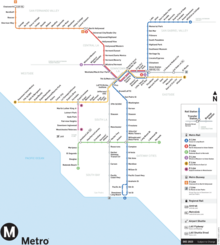
- Albuquerque - The largest city in New Mexico, despite some strides in the development of its public transit system, is still primarily a driving city, so with the exception of Central Avenue public transit is still for the most part very underdeveloped.
- Atlanta - outside of a rather small downtown core, there is little public transportation in part due to the city's sprawling nature. Where MARTA's subway does go, it's hands down the easiest way around. If you have a longer layover at the world's busiest airport , popping out on MARTA to check out some sights is far more comfortable than being saddled with a car.
- Charlotte - Uptown is very dense, and almost all attractions in that part of town are easily reached by walking. However, only a few other districts (such as NoDa and Dilworth) are truly pedestrian-friendly and the rest of the city is rather unfriendly to pedestrians. That being said there is one light rail line in use.
- Dallas-Fort Worth Metroplex - The nation's sprawling fourth-largest urban area is hard to get around without a car, especially outside Dallas and Ft. Worth proper. Arlington, the largest of the suburbs separating the pair, is the largest city in the US without even a token city bus network. That said, the downtown areas of both Dallas and Fort Worth have direct rail links to DFW International Airport , and most major attractions in those two cities are accessible by rail or bus.
- Detroit - the capital of the automotive industry is very car-dependent, as you would expect. In a small section of the downtown core, the People Mover and the Q line can be used to quickly navigate the area on rail. However, the cycling community is on the rise, in part owing to the re-purposing of some of the extra space in the hugely overbuilt road network to accommodate cyclists.
- Houston - the infamously sprawling oil city nevertheless has light rail and bus systems. Visiting here without a car is doable if your visits are confined to Downtown, Midtown/Museum District, or the Medical Center area, which are connected by light rail, and there is an expanding number of bike paths in the city. Renting a car is still highly recommended, however.
- Las Vegas - Walking is a fairly good way of getting around the Strip, the main gambling and tourist area. A monorail also runs parallel to the Strip (despite being impractically located behind the casinos). Almost everywhere else in the city is accessible by bus, though some lines may run as infrequently as once an hour. There is no rail system connecting the suburban areas with Downtown Las Vegas. Las Vegas is one of the largest American cities with no railroad service - it was abandoned in 1997.
- Los Angeles - Though L.A. is a major example of sprawl, local bus services have been improving, and L.A. has built over 100 mi (160 km) of urban rail since 1990. Light rail is expanding and a good option for the places which it serves, but there are still many areas not served by it. Still, a visit to L.A. without a car is very much possible if your primary destinations are served by light rail or frequent buses which include Downtown, Mid-Wilshire, Exposition Park, Hollywood, Santa Monica, or Old Pasadena. Public transit is generally still slower than cars over long distances, but it does avoid wasting time looking for parking, and the light rail system largely escapes L.A.'s notorious traffic. The situation can be expected to markedly improve even further in the near future, as a 2016 referendum to further expand Metro Rail services through the coming two decades succeeded, adding local funding and certainty on top of existing ballot measures to fund transit. The city will also host the 2028 Summer Olympics, which will mean a big boost to the public transit system and the ambitious "28 by 28" program of 28 transportation projects - including highways, public transit and bike infrastructure - promises to accelerate construction or build new projects before the 2028 Olympics.
- Miami - While Miami does have an elevated metro line that connects downtown with the airport and frequent bus service in some areas like Miami Beach, it is still advisable for tourists to rent a car here as not all areas popular with tourists are reachable by transit plus South Florida is known for its car dependent sprawl.
- Nashville - Outside of downtown, Nashville is probably one of the worst offenders in terms of car dependent sprawl and isn't very walkable.
- Orlando - Outside of the Walt Disney World and Universal Orlando Resort complexes, public transit is severely lacking in the city, which is also not very walkable in most areas.
- Phoenix - the biggest city not served by Amtrak and probably one of the worst offenders in terms of car dependent sprawl. However, a light rail line does connect downtown Phoenix with the airport and Tempe.
- San Diego - The San Diego metropolitan area is large and sprawling. Car travel is the most efficient way of navigating the city and county even though a light rail network (named the "Trolley") connects Downtown to the Mexican border crossing and other points of interest.
- Tampa - The city of Tampa and the Tampa Bay metropolitan area as a whole is large and sprawling and public transit is very lacking there.
The suburban cities/municipalities surrounding the "Good Cities" (listed above) 10-60 miles (16-100 km) out of the downtown core of the "Good Cities" can rival the "Difficult Cities" as well. So if you're staying in the surrounding suburbs or exurbs it may be worthwhile to consider a car if possible. If you want to forego a car, try to avoid suburban and exurban areas, at least outside of the big Northeast cities (which often have extensive and relatively frequent suburban rail networks)

Other popular destinations [ edit ]

Most World Heritage Sites in the USA are national parks or otherwise in rural areas, and only about half of them can be reached without driving. Some natural attractions within a few hours' drive of a major city can be accessed via organized tours. For instance, tours run from Las Vegas to many nearby national parks. On such tours, however, your schedule and destinations within the expansive parks will be set by the tour company. Many of the places they serve can feel polished and tame compared to the vast wilderness surrounding them.
Otherwise, your car-free options are your feet or a bike. If possible, consider taking a bus to the park entrance and hiking or biking around inside. However, you should not attempt this without planning your trip carefully and bringing extensive supplies. This should be considered as an experience in itself rather than a regular means of transportation.
- The Adirondack mountains are accessible via the (aptly named) Amtrak Adirondack, and some other points can be reached either by heritage railroads or buses. On the navigable bodies of water you can of course cruise in small craft , but other than that you would have to rely on sturdy boots and firm legs to get around.
- Cahokia Mounds State Historic Site is less than a mile from a local bus stop, served by buses between East St. Louis and Collinsville (Illinois) .
- Denali National Park , in the Alaskan Interior, is surprisingly accessible without a car: the town of Denali, right next to the park, is served by passenger rail, and shuttle buses take visitors around the park.
- Disneyland is served by several local bus lines.
- Hawaii Volcanoes National Park is served by five buses a day from Hilo every day except Sundays.
- Glacier Bay National Park is entered from the adjacent town of Gustavus , which in turn has an airport and a harbor where ships (including ) on the Alaska Maritime Highway dock, both a little over a mile from Gustavus. Visitors usually get around the park on some kind of watercraft: kayak, cruise ship, tour vessel or rental boat.
- Glacier National Park is one of the easiest national parks to get to by train. Amtrak's Empire Builder directly serves the park via two stations ( West Glacier and East Glacier ) and travels right next to the park for some distance. The park also has some bus services for getting around inside.
- Grand Canyon Village is accessible by a shuttle service from Flagstaff 's Amtrak station. Another option is taking the train to Williams and the Grand Canyon Railroad (a tourist railway ) from there to the rim of the Canyon.
- Niagara Falls can easily be visited by train. Amtrak's Empire Service and Maple Leaf take you directly into the city of Niagara Falls. The falls are also served by local bus routes from downtown Buffalo 's bus terminal and Buffalo Niagara International Airport .
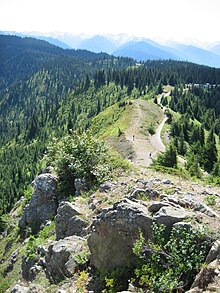
- Redwood National Park can be reached by local bus lines operated by Redwood Coast Transit, connecting from nearby cities like Crescent City and Arcata . Both have a regional airport, and Arcata has a bus station served by both Greyhound and the Amtrak Thruway Motor Coach (connecting to trains in Martinez ).
- Walt Disney World can be reached by public bus from Orlando and Kissimmee .
- West Yellowstone at the western entrance of Yellowstone National Park has an airport (in Jackson Hole, Wyoming ) with flights during the summer months. During the summer there's also a bus service running in the park. There is no Amtrak service throughout the entire state of Wyoming.
- Yosemite National Park is accessible by buses meeting Amtrak's trains in Merced and Yarts Bus.
- Articles without Wikipedia links (via Wikidata)
- Has custom banner
- Usable topics
- Usable articles
- Transportation
- Topic articles
Navigation menu

An official website of the United States government
Here’s how you know
Official websites use .gov A .gov website belongs to an official government organization in the United States.
Secure .gov websites use HTTPS A lock ( Lock A locked padlock ) or https:// means you’ve safely connected to the .gov website. Share sensitive information only on official, secure websites.
- Fact Sheets
Frequently Asked Questions: Guidance for Travelers to Enter the U.S.
Updated Date: April 21, 2022
Since January 22, 2022, DHS has required non-U.S. individuals seeking to enter the United States via land ports of entry and ferry terminals at the U.S.-Mexico and U.S.-Canada borders to be fully vaccinated for COVID-19 and provide proof of vaccination upon request. On April 21, 2022, DHS announced that it would extend these requirements. In determining whether and when to rescind this order, DHS anticipates that it will take account of whether the vaccination requirement for non-U.S. air travelers remains in place.
These requirements apply to non-U.S. individuals who are traveling for essential or non-essential reasons. They do not apply to U.S. citizens, Lawful Permanent Residents, or U.S. nationals.
Effective November 8, 2021, new air travel requirements applied to many noncitizens who are visiting the United States temporarily. These travelers are also required to show proof of COVID-19 vaccination. All air travelers, including U.S. persons, must test negative for COVID-19 prior to departure. Limited exceptions apply. See CDC guidance for more details regarding air travel requirements.
Below is more information about what to know before you go, and answers to Frequently Asked Questions about cross-border travel.
Entering the U.S. Through a Land Port of Entry or Ferry Terminal
Q. what are the requirements for travelers entering the united states through land poes.
A: Before embarking on a trip to the United States, non-U.S. travelers should be prepared for the following:
- Possess proof of an approved COVID-19 vaccination as outlined on the CDC website.
- During border inspection, verbally attest to their COVID-19 vaccination status.
- Bring a Western Hemisphere Travel Initiative compliant border crossing document, such as a valid passport (and visa if required), Trusted Traveler Program card, a Department of State-issued Border Crossing Card, Enhanced Driver’s License or Enhanced Tribal Card when entering the country. Travelers (including U.S. citizens) should be prepared to present the WHTI-compliant document and any other documents requested by the CBP officer.
Q. What are the requirements to enter the United States for children under the age of 18 who can't be vaccinated?
A: Children under 18 years of age are excepted from the vaccination requirement at land and ferry POEs.
Q: Which vaccines/combination of vaccines will be accepted?
A: Per CDC guidelines, all Food and Drug Administration (FDA) approved and authorized vaccines, as well as all vaccines that have an Emergency Use Listing (EUL) from the World Health Organization (WHO), will be accepted.
Accepted Vaccines:
- More details are available in CDC guidance here .
- 2 weeks (14 days) after your dose of an accepted single-dose COVID-19 vaccine;
- 2 weeks (14 days) after your second dose of an accepted 2-dose series;
- 2 weeks (14 days) after you received the full series of an accepted COVID-19 vaccine (not placebo) in a clinical trial;
- 2 weeks (14 days) after you received 2 doses of any “mix-and-match” combination of accepted COVID-19 vaccines administered at least 17 days apart.
Q. Is the United States requiring travelers to have a booster dose to be considered fully vaccinated for border entry purposes?
A: No. The CDC guidance for “full vaccination” can be found here.
Q: Do U.S. citizens or lawful permanent residents need proof of vaccination to return to the United States via land POEs and ferry terminals?
A: No. Vaccination requirements do not apply to U.S. citizens, U.S. nationals, or Lawful Permanent Residents (LPRs). Travelers that exhibit signs or symptoms of illness will be referred to CDC for additional medical evaluation.
Q: Is pre- or at-arrival COVID testing required to enter the United States via land POEs or ferry terminals?
A: No, there is no COVID testing requirement to enter the United States via land POE or ferry terminals. In this respect, the requirement for entering by a land POE or ferry terminal differs from arrival via air, where there is a requirement to have a negative test result before departure.
Processing Changes Announced on January 22, 2022
Q: new changes were recently announced. what changed on january 22.
A: Since January 22, 2022, non-citizens who are not U.S. nationals or Lawful Permanent Residents have been required to be vaccinated against COVID-19 to enter the United States at land ports of entry and ferry terminals, whether for essential or nonessential purposes. Previously, DHS required that non-U.S. persons be vaccinated against COVID-19 to enter the United States for nonessential purposes. Effective January 22, all non-U.S. individuals, to include essential travelers, must be prepared to attest to vaccination status and present proof of vaccination to a CBP officer upon request. DHS announced an extension of this policy on April 21, 2022.
Q: Who is affected by the changes announced on January 22?
A: This requirement does not apply to U.S. citizens, U.S. nationals, or U.S. Lawful Permanent Residents. It applies to other noncitizens, such as a citizen of Mexico, Canada, or any other country seeking to enter the United States through a land port of entry or ferry terminal.
Q: Do U.S. citizens need proof of vaccination to return to the United States via land port of entry or ferry terminals?
A: Vaccination requirements do not apply to U.S. Citizens, U.S. nationals or U.S. Lawful Permanent Residents. Travelers that exhibit signs or symptoms of illness will be referred to CDC for additional medical evaluation.
Q: What is essential travel?
A: Under the prior policy, there was an exception from temporary travel restrictions for “essential travel.” Essential travel included travel to attend educational institutions, travel to work in the United States, travel for emergency response and public health purposes, and travel for lawful cross-border trade (e.g., commercial truckers). Under current policy, there is no exception for essential travel.
Q: Will there be any exemptions?
A: While most non-U.S. individuals seeking to enter the United States will need to be vaccinated, there is a narrow list of exemptions consistent with the Centers for Disease Control and Prevention (CDC) Order in the air travel context.
- Certain categories of individuals on diplomatic or official foreign government travel as specified in the CDC Order
- Children under 18 years of age;
- Certain participants in certain COVID-19 vaccine trials as specified in the CDC Order;
- Individuals with medical contraindications to receiving a COVID-19 vaccine as specified in the CDC Order;
- Individuals issued a humanitarian or emergency exception by the Secretary of Homeland Security;
- Individuals with valid nonimmigrant visas (excluding B-1 [business] or B-2 [tourism] visas) who are citizens of a country with limited COVID-19 vaccine availability, as specified in the CDC Order
- Members of the U.S. Armed Forces or their spouses or children (under 18 years of age) as specified in the CDC Order; and
- Individuals whose entry would be in the U.S. national interest, as determined by the Secretary of Homeland Security.
Q: What documentation will be required to show vaccination status?
A: Non-U.S. individuals are required to be prepared to attest to vaccination status and present proof of vaccination to a CBP officer upon request regardless of the purpose of travel.
The current documentation requirement remains the same and is available on the CDC website . Documentation requirements for entry at land ports of entry and ferry terminals mirror those for entry by air.
Q: What happens if someone doesn’t have proof of vaccine status?
A: If non-U.S. individuals cannot present proof of vaccination upon request, they will not be admitted into the United States and will either be subject to removal or be allowed to withdraw their application for entry.
Q: Will incoming travelers be required to present COVID-19 test results?
A: There is no COVID-19 testing requirement for travelers at land border ports of entry, including ferry terminals.
Q: What does this mean for those who can't be vaccinated, either due to age or other health considerations?
A: See CDC guidance for additional information on this topic. Note that the vaccine requirement does not apply to children under 18 years of age.
Q: Does this requirement apply to amateur and professional athletes?
A: Yes, unless they qualify for one of the narrow CDC exemptions.
Q: Are commercial truckers required to be vaccinated?
A: Yes, unless they qualify for one of the narrow CDC exemptions. These requirements also apply to bus drivers as well as rail and ferry operators.
Q. Do you expect border wait times to increase?
A: As travelers navigate these new travel requirements, wait times may increase. Travelers should account for the possibility of longer than normal wait times and lines at U.S. land border crossings when planning their trip and are kindly encouraged to exercise patience.
To help reduce wait times and long lines, travelers can take advantage of innovative technology, such as facial biometrics and the CBP OneTM mobile application, which serves as a single portal for individuals to access CBP mobile applications and services.
Q: How is Customs and Border Protection staffing the ports of entry?
A: CBP’s current staffing levels at ports of entry throughout the United States are commensurate with pre-pandemic levels. CBP has continued to hire and train new employees throughout the pandemic. CBP expects some travelers to be non-compliant with the proof of vaccination requirements, which may at times lead to an increase in border wait times. Although trade and travel facilitation remain a priority, we cannot compromise national security, which is our primary mission. CBP Office of Field Operations will continue to dedicate its finite resources to the processing of arriving traffic with emphasis on trade facilitation to ensure economic recovery.
Q: What happens if a vaccinated individual is traveling with an unvaccinated individual?
A: The unvaccinated individual (if 18 or over) would not be eligible for admission.
Q: If I am traveling for an essential reason but am not vaccinated can I still enter?
A: No, if you are a non-U.S. individual. The policy announced on January 22, 2022 applies to both essential and non-essential travel by non-U.S. individual travelers. Since January 22, DHS has required that all inbound non-U.S. individuals crossing U.S. land or ferry POEs – whether for essential or non-essential reasons – be fully vaccinated for COVID-19 and provide related proof of vaccination upon request.
Q: Are sea crew members on vessels required to have a COVID vaccine to disembark?
A: Sea crew members traveling pursuant to a C-1 or D nonimmigrant visa are not excepted from COVID-19 vaccine requirements at the land border. This is a difference from the international air transportation context.
Entering the U.S. via Air Travel
Q: what are the covid vaccination requirements for air passengers to the united states .
A: According to CDC requirements [www.cdc.gov/coronavirus/2019-ncov/travelers/noncitizens-US-air-travel.html | Link no longer valid], most noncitizens who are visiting the United States temporarily must be fully vaccinated prior to boarding a flight to the United States. These travelers are required to show proof of vaccination. A list of covered individuals is available on the CDC website.
Q: What are the COVID testing requirements for air passengers to the United States?
A: Effective Sunday, June 12 at 12:01 a.m. ET, CDC will no longer require pre-departure COVID-19 testing for U.S.-bound air travelers.
- Border Security
- Transportation Security
- Airport Security
- Coronavirus (COVID-19)
- Customs and Border Protection (CBP)
- Transportation Security Administration (TSA)
10 Amtrak Trips Where You Won't Need A Car To Get Around
With Amtrak, travelers don't need a car to see some of the best North American destinations. Here are some epic Amtrak trips that don't require a car.
- There are many Amtrak trips you can do without a car needed at the destination or departure point, including the Acela from Boston to Washington, DC.
- The Adirondack route allows travelers to experience the natural beauty of Upstate New York and visit Montreal without a car.
- The Capitol Limited is another one of the Amtrak trips where you don't need a car rental; the route offers an overnight journey from Washington, DC to Chicago, allowing passengers to explore the walkable city of Chicago without a vehicle.
Train travel is one of the more underrated means of transportation in North America. Though not as comprehensive as passenger train networks in Europe, Amtrak does currently offer dozens of fun and convenient trips across the United States and Canada.
However, many travelers who are interested in an Amtrak vacation may be worried about getting around. Unlike airports, Amtrak stations often don’t always have car rental services on site. Also, without access to a rental car, some travelers may worry that they won’t be able to get around when they reach their destination.
Fortunately, Amtrak currently offers several routes to destinations where travelers don’t need a car to get the most out of their trip. In addition to convenient alternative travel options at the destinations, these Amtrak routes to walkable cities also offer passengers beautiful scenery, convenient amenities, and fun vacations to both major cities and natural landmarks. Here are a number of Amtrak trips where travelers won’t need a car to get around (best of all, some of these trips are even among America's affordable yet scenic train rides !).
Amtrak Booking: 14 Tips & Tricks To Know When Planning A Train Trip
10 the acela from boston to washington, dc, enjoy convenient access to the most walkable cities on the east coast.
Amtrak’s popular Acela route connects all of the major cities in the Northeastern United States. Each major city on this route also has comprehensive public transportation and walkable city centers. Beginning in Boston in the north, passengers can ride the Acela down the Eastern Seaboard to New York City, Philadelphia, and eventually to the nation’s capital in Washington DC.
For many Acela riders, New York City is the route’s most popular destination. With a stop at New York’s Moynihan Train Hall at Pennsylvania Station, riders can get off right in the heart of Midtown Manhattan , well within easy walking distance to major attractions like the Empire State Building, the New York Theater District, and Times Square. Visitors can also use the city’s sophisticated subway system to easily reach destinations elsewhere in the city.
At the southern terminus, passengers will arrive at Washington DC’s Union Station. Located in the center of the city, Union Station provides visitors with easy walking access to Capitol Hill, the National Mall, and the free-to-visit Smithsonian Museums .
- Distance: 457 miles
- Journey Time: 7 hours
- Cost: Varies
9 The Adirondack From New York To Montreal
Discover gorgeous views of upstate new york en route to quebec.
Thanks to Amtrak’s Adirondack route , visitors to New York City and the state of New York in general don’t need a car to experience the natural beauty of Upstate New York. Plus, they can make a quick visit to Canada while they’re at it. The Adirondack departs from Manhattan’s Moynihan Train Hall in the morning and heads north to Montreal in the Canadian province of Quebec, with stops at cities like Poughkeepsie, Saratoga Springs, and Plattsburg along the way.
Arriving at Montreal’s Gare Centrale in the evening, passengers can experience a unique European culture without leaving North America. While it’s easy to get lost in the city’s French-inspired culture and European architecture, visitors can also take advantage of Montreal’s safe and convenient metro system to get to hotels and major attractions around the city.
However, while New York City and Montreal are great destinations, the Adirondack route also provides passengers with a front-row seat to some of the most beautiful scenery in the Northeastern United States. After leaving New York City, the train carries passengers up through the state’s gorgeous Hudson River Valley. As the name suggests, the Adirondack route’s crown jewel is its passage through the breathtaking Adirondack Mountains of Upstate New York. Passing through, travelers on the route will get excellent views of the mountains, Lake Champlain, and some of the region’s best wine country.
- Distance: 381 miles
- Journey Time: 10 hours
- Cost: From $61
All passenger trains that cross the U.S.-Canadian border are subject to inspection by American and Canadian border officials. Passengers on these trains should review all requirements for international border crossings and ensure that they have a valid passport or other valid travel documentation.
8 The Capitol Limited From Washington, DC, To Chicago
An overnight journey from the nation's capital to the most walkable city in the midwest.
Outside of the Northeastern United States, Chicago is perhaps the best city to explore without a car. Amtrak’s Capitol Limited route from DC to Chicago is a great way to get there from locations across the East Coast and Midwest. Departing from Washington DC’s Union Station in the afternoon, the Capitol Limited travels through destinations in Maryland, West Virginia, Pennsylvania, Ohio, and Indiana before arriving in Chicago the following morning.
Chicago’s Union Station lies at the heart of the city’s expansive Chicago Transit Authority (CTA) rapid transit train system . Once travelers get off the train, they can take advantage of nearby CTA lines to visit attractions like the Willis Tower , the Water Tower District, and the Lakefront Museum Campus (which features several world-renowned museums like the Fields Museum of Natural History and the Art Institute of Chicago).
However, even passengers who don’t want to go all the way to Chicago can still have a fun, car-free trip on the Capitol Limited. The route also makes stops at several smaller but worthwhile destinations just a few hours from Washington DC. These include the picturesque towns of Harpers Ferry West Virginia and Cumberland Maryland, which offer numerous opportunities for bike-riding, hiking, or even just site-seeing on foot.
- Distance: 764 miles
- Journey Time: 18 hours
- Cost: From $84
These Are The Top 12 Busiest Amtrak Routes In The U.S., Ranked By Popularity
7 the california zephyr from chicago to san francisco, an incredible journey to the west coast with mountains, rivers, lakes, and valley scenery.
Thanks to the California Zephyr route, travelers won’t need a car (or a plane!) to get from Chicago to San Francisco on the West Coast. Embarking from Chicago’s Union Station, the California Zephyr takes passengers on a westward journey that covers many of the most beautiful sights in the United States. Highlights of the trip include gorgeous views of the Rocky Mountains and Sierra Nevada ranges, as well as abundant rivers, valleys, and lakes.
With stops in Denver and Salt Lake City, the California Zephyr gives passengers a ticket to some of the most beautiful (and walkable) cities in the American West. But the California Zephyr also saves the best for last. Passengers who stick through the route’s entire 51-hour journey will find themselves arriving at the Emeryville station just outside of the world-famous city of San Francisco .
From there, travelers can take a quick bus ride to downtown San Francisco and enjoy a day walking exploring the city’s famous Chinatown, Marina, and Golden Gate Bridge. Visitors can also hop on one of the city’s well-known street cars for an up close and personal tour of the city center.
- Distance: 2,438 miles
- Journey Time: 51 hours 20 minutes
- Cost: From $150
6 The City Of New Orleans Route From Chicago To New Orleans
A trip down the mississippi to walk in the footsteps of american musical history.
For travelers from Chicago looking for a different vibe than California, Amtrak’s City of New Orleans route provides a fun and convenient trek down the Mississippi River and into a world of Southern US culture. Music lovers in particular will get a special thrill out of this trip, as it gives passengers a one-day journey between three of the most musically-renowned cities in the United States. From the world-famous blues of Chicago, passengers can span several hundred miles down the Mississippi to the musical city of Memphis, Tennessee.
Getting off at the Memphis Central Station, visitors to the city can explore one of the centers of American musical culture on foot. Highlights include the historic Sun Studio (where luminaries like Elvis and Johnny Cash recorded some of their earliest hits), the Memphis Rock n’ Soul Museum , and countless blues bars and concert halls. Visitors can also walk to the National Civil Rights Museum, or hop on a bus to visit Elvis Presley’s internationally-recognized Graceland home just outside the city.
As its name suggests, the City of New Orleans route makes its final stop at the one-of-a-kind city of New Orleans, Louisiana . From the city's Union Passenger Terminal, visitors can either walk or hop on one of the city’s famous street cars to the famous French Quarter . Even without a car, visitors can walk up and down the one-of-a-kind Bourbon Street, test their nerves at a Voodoo store, pay a visit to one of the ample musical bars in the city ( NOLA's amazing jazz clubs are a must!), or just enjoy New Orleans’ unique, French-inspire architecture.
- Distance: 934 miles
- Journey Time: 19 hours
8 Amtrak Cross-Country Trips To Travel Coast To Coast By Train
5 the maple leaf from new york to toronto, a day trip between two of the most popular cities in the us and canada.
Amtrak passengers traveling from New York City can make the trip to the Canadian metropolis of Toronto in just a day, thanks to Amtrak’s Maple Leaf route. Departing from New York’s Penn Station, the Maple Leaf travels north through the New York state capital of Albany before arriving at the U.S.-Canadian border at Niagara Falls.
Passengers who don’t want to make the trip to Canada can get off at the city of Niagara Falls, New York, and spend a car-less day taking in one of North America’s greatest natural wonders at Niagara Falls State Park . From the Niagara Falls station, visitors can easily access the American side of Niagara Falls and get amazing views of one of the world’s most famous waterfalls.
Carrying onward past the Canadian border, passengers riding the entire Maple Leaf route will arrive in the city of Toronto, Ontario, around 12 hours after departing from New York. Once there, visitors to the city can hop on the expansive Toronto subway or streetcar network to explore the city.
Even without a car, Maple Leaf passengers can visit the observation deck at the CN Tower , explore one of the city’s many museums, or even just walk along the beautiful Toronto Harbour along the shores of Lake Ontario. Whether spending a day or 10 days in Toronto , most of the main attractions and activities in this bustling city are entirely walkable.
- Distance: 544 miles
- Journey Time: 12 hours 30 minutes
4 The Pennsylvanian From Philadelphia To Pittsburgh
From the city of brotherly love to the city of bridges.
Those looking for a quicker trip to one of the country’s underrated cities can hop on Amtrak’s Pennsylvanian route . Travelers on this route can depart from either New York’s Penn Station or Philadelphia’s 30th St. Station and travel westward across the commonwealth of Pennsylvania to the city of Pittsburgh. During the roughly 9-hour trip, passengers can enjoy some of Pennsylvania’s most beautiful scenery, including the Allegheny Mountains, the Horseshoe Curve near Altoona , and Pennsylvania Dutch Country.
Visitors to Pittsburgh can disembark at the city’s Union Station and explore one of the more underrated walkable cities in the US. From the station, visitors can easily walk to Pittsburgh's picturesque Point State Park where the Monongahela and Allegheny Rivers converge to form the Ohio River. From there, visitors have an easy walk across one of Pittsburgh’s many bridges to the riverfront of the North Shore or take a ride up one of two incline trains and get some of the best views of any North American city one can find.
Even without a car, visitors can grab several public buses from downtown Pittsburgh to visit the city’s worthwhile Oakland neighborhood. There, visitors can explore the campus of the University of Pittsburgh (including the landmark Cathedral of Learning and its famous nationality rooms ), the Carnegie Museums of Art and Natural History (which feature one of the largest collections of dinosaur fossils in the United States), and one of the city’s many beautiful urban parks.
- Distance: 444 miles
- Journey Time: 9 hours 20 minutes
- Cost: From $56
3 The Amtrak Cascades From Eugene To Vancouver
An unforgettable voyage through the pacific northwest.
The Adirondack and the Maple Leaf are not the only Amtrak routes that give American passengers access to Canada. Out on the West Coast, the Amtrak Cascades route travels north through the Pacific Northwest from Eugene, Oregon, to Vancouver, British Columbia.
Starting from Eugene, passengers on the Cascades route will get a front-row seat to the otherworldly beauty of the North American Pacific Northwest. From the train window, passengers will see the spectacular majesty of the Cascade Range mountains. In particular, the Cascades train will pass close to Mount Saint Helens and the breathtaking Columbia River Gorge .
Passengers looking to explore some of the most walkable cities in America can get off at Portland’s Union Station or Seattle’s King Street Station. Or, travelers can ride the Cascades’ entire length across the U.S.-Canadian border to Vancouver’s Pacific Central Station. There, visitors to the city can easily walk to many of Vancouver’s best attractions , including Granville Island, Gastown, and Coal Harbour. Vancouver’s TransLink public transportation system also lets visitors easily get around the city even without a car.
- Distance: 467 miles
- Journey Time: 10 hours 25 minutes
2 The Empire Builder From Chicago To Portland
Travel from the windy city to the pacific northwest without a car.
Travelers looking to explore the Pacific Northwest don’t need to start their journey already on the West Coast. Thanks to Amtrak’s Empire Builder route, passengers can embark from Chicago’s Union Station and travel the western expanse of the United States to the unique city of Portland, Oregon.
The Empire Builder begins its roughly 46-hour journey with stops across the American Upper Midwest. There, passengers can get off at cities like Milwaukee, Minneapolis, and Fargo. Eventually, the train leaves that region’s relatively flat terrain and hits the mountains of Montana, Idaho, and the Pacific Northwest. The train passes directly through Montana’s Big Sky Country, where passengers can get excellent views of Glacier National Park in the Rocky Mountains.
Following a stop in the city of Spokane, Washington, passengers can travel southwards through the Cascade Range towards the exciting city of Portland, Oregon . During this leg of the journey, passengers are treated to even more gorgeous scenery, including Beacon Rock, Mt. Hood, and the Columbia River Gorge.
Upon arrival at Portland’s Union Station, travelers have immediate access to Portland’s Metropolitan Area Express (MAX) light rail and Portland Streetcar system. From there, pedestrians can explore many of Portland's best-known attractions , including the Oregon Zoo, the Portland Japanese Garden, and Powell’s City of Books —one of the largest independent bookstores in the world.
- Distance: 2,206 miles
- Journey Time: 46 hours
Some Empire Builder trains diverge from the Portland-bound route at Spokane and travel to Seattle instead. Before embarking from Spokane, passengers should make sure that they are on the correct route for their final destination.
1 The Coast Starlight From Los Angeles To Seattle
Travel up the pacific coast through some of the most beautiful scenery in the us.
Amtrak’s Coast Starlight route is another one of the many Amtrak trips that don't need a car, as it links two of the very walkable major cities of the American West Coast—Los Angeles and Seattle. However, for all those cities have to offer, the Coast Starlight’s true claim to fame is probably the incredible views it offers to passengers of the most scenic parts of the United States. The Coast Starlight spends the first leg of its trip taking passengers along California’s Pacific Coast to the San Francisco Bay Area.
From there, the train ventures further north into the Cascade Range of the Pacific Northwest. Passengers can get up close views of the region’s incredible mountains, forests, and lakes (including California’s Mount Shasta , a potentially active volcano). At the stop in Klamath Falls, Oregon, passengers can get off and access many of Oregon’s most beautiful scenery, such as Crater Lake National Park . During this leg of the trip, travelers can get a good idea of why the Coast Starlight is often regarded as the most beautiful train ride in the entire country.
Once travelers arrive at Seattle’s King Street Station, they can hop on the city’s Link light rail system to pay a visit to the famous Space Needle . Or, for visitors in the mood for a day of shopping by the water, Seattle also features the very walkable Pike Place Market , one of the oldest farmer's markets in the country.
- Distance: 1,377 miles
- Journey Time: 35 hours
- Cost: From $100

7 Totally Walkable and Amazing Places To Travel Without a Car In the US
Posted on Published: September 20, 2022 - Last updated: July 25, 2023
Categories TRAVEL
Sharing is caring!
- Pinterest 89
Traveling by car is the most common way to get around in the United States. However, many of the best places to travel in the US can be enjoyed even if you travel without a car .
If you are ready to grab a train or plane (and ditch the car) to a nearby US city for some tourism on foot, we’ve got you covered!

There is something so energizing and fun about leaving your hotel room, turning the corner, and exploring a new city on foot.
There are numerous iconic places to travel in the US without a car. Many of these cities and towns offer historic charm, amazing food and nightlife, and outdoor adventure.
What Is The Cheapest Way To Travel Without A Car?
The cheapest way to travel without a car in the US when you’re on a budget is by bus or train. Amtrak tickets are also relatively affordable, and many trains offer discounts for children and seniors.
Buses have cheap prices, especially if you can plan ahead and book in advance.

Another option is to hitchhike, which can be a great way to meet new people and see the country.
However, please be aware that this mode of transportation can be dangerous, so use caution when accepting rides from strangers.

Finally, consider walking or biking whenever possible – both options are great ways to see the sights and save money on travel costs.

Portland, ME
Don’t mistake Portland, Maine, for an old fisherman town. Au contraire, the city is buzzing with trendy shops and a vibrant culinary scene .
It was named the 2018 Restaurant City of the Year, according to Bon Appetit Magazine.
But with all that hype, Portland remains true to its identity – a charming port town.
Things to do in Portland
- Visit the Old Port
- Check out the Portland Museum of Art
- Visit Casco Bay or any of the small islands
- Visit one of the US “Greatest Streets” Commercial Streets
- Slurps on fresh oyster at Harbor Fish Market
- Check out the many great eateries and bars
Portland is a great city to visit without a car. The downtown area and waterfront are pedestrian-friendly and small enough to walk everywhere.
If you want to go further out of the downtown area, you can take the METRO Bus. It’s convenient and very affordable. Want to get around faster? Rent a bike!
You can easily pick one from the bike racks located near METRO Bus stops. Want to visit the nearby islands? Hop on a Mail Boat. Want to check out the lighthouses?
Take a trolley tour. No matter where you want to go, Portland makes it easy for you to visit without a car!

Philadelphia, PA
Philadelphia is a super easy city in the USA to visit without a car. It only takes 80 minutes from New York and 90 minutes from Washington, D.C. to arrive in Philadelphia using an Amtrak train.
As well as being frequent and fast, the trains are very comfortable – far roomier than a cramped airline seat!
Once you arrive in Philadelphia, it’s easy to get around without a car by using the metro system or the ample supply of city buses.
Since the distances are relatively short between destinations, Uber and Lyft are also cheap options for getting around Philadelphia without a car.
While in Philadelphia, don’t miss out on visiting Independence Hall and the Liberty Bell.
This historic site is where both the US Declaration of Independence and the US Constitution were debated and signed and is a UNESCO World Heritage Site.
Other highlights include tours of the Eastern State Penitentiary and feasting on a Philly Cheesesteak.

Boston is one of the most walkable cities in America, but one of the worst cities for driving. So when you visit, skip the car rental. The compact city layout puts the key sights within walking distance of the city’s best hotels .
If you will be visiting for the first time, you have to see some of the historical sights from Boston’s role in the American Revolution.
Then venture to the chic Back Bay neighborhood for some shopping on Newbury Street and lunch at MET for some people watching.
After a day of exploring, finish your evening off with dinner at Ruka on Washington Street in the Downtown Crossing neighborhood.
The Peruvian Japanese fusion restaurant serves up some flavorful dishes and lots of creative cocktails.
Whether you are visiting for a girl’s trip, a family vacation, or a business trip, there is lots to see and do in Boston for every type of traveler.

Miami Beach, FL
Miami Beach, Florida is the perfect place to visit if you’re looking for a car-free getaway. There are so many things to do in Miami Beach and the best part, they are all easily accessible by foot or bicycle.
Miami Beach even has a free trolley that you can take advantage of with routes all the way from South Beach to North Beach.
Getting to Miami Beach from the airport is also easy (and cheap). You can take the Miami Beach Airport Flyer Bus (Route 150). It will cost less than $3, and you will be in the heart of Miami Beach.
Opt to stay near Lincoln Road. From here you will be within walking distance of the beach, bars, restaurants, and shopping.
While in Miami Beach some must-visits are of course the beach. But also check out Pane e Vino for handmade pasta, The Delano for people-watching, and the SLS for a pool party.
Ditch the car and head to South Beach Miami for your next getaway.

New York, NY
New York City is the perfect place to travel without a car thanks to an efficient subway system and how walkable the city is. Once you land in one of the three airports that service New York City, you can take a car to get into the city, and you won’t need to get inside of one until you leave back home.
Having a car is more of a detriment due to the crazy high parking rates and insane traffic.
Manhattan has several subway lines that service all areas and make it easy to get from point A to point B.
Since most people rent a hotel near Midtown, it is easy to walk to Times Square, a broadway show, restaurants, museums, Grand Central Station, the public library, Bryant Park, Central Park, Rockefeller Center, and more.
From Times Square, you can take the subway down to the Financial District and visit One World, the 9/11 Museum and Memorial, the Oculus, Wall Street, Battery Park, and also take a ferry to Ellis Island and the Statue of Liberty.
Exploring some of New York City’s other neighborhoods are also very easy to do if you take the subway.
You can go shopping in Soho, eat some delicious food in Greenwich Village , Chelsea, Chinatown, or Little Italy, see the Yankees play in the Bronx, or even check out Brooklyn’s hipster scene all without a car.

Washington, D.C.
Washington, D.C. is one of the very few big cities in the United States that you can explore easily without a car.
Thanks to its old-school urban planning and the DC Metro, there is very little in the District that you can’t get to by train or on foot. Both Dulles Airport and the gorgeous Washington Union Station connect to the DC Metro, so you’re good to go from the moment you hop off your plane or train.
Another great thing is that so many of DC’s best attractions are clumped together!
For example, the National Mall has to have the densest concentration of world-class institutions in the country. Bookended by the Washington Monument and the National Capitol, themselves must-sees in DC, the National Mall is bordered by no less than 11 museums of the Smithsonian Institute.
The Natural History Museum, American History Museum, and African American History and Culture Museum stand shoulder-to-shoulder. You can literally walk to the Air and Space Museum, the National Gallery of Art, and several others in a matter of minutes.
In the surrounding city blocks, you’ll find restaurants and shops to suit every taste and budget.
The best part? The Mall is directly served by two DC Metro stations and is within a block of four more, so chances are you can get here easily from wherever you’re staying.

Chicago, IL
Chicago is an easy city to visit without a car and is one of the most walkable cities in the United States.
Most of the popular tourist attractions, including Millennium Park, Willis Tower, and Navy Pier, are concentrated in or near the downtown area, so it is possible to get around entirely by foot for those that enjoy walking.
Visitors can also rent bikes through Divvy, Chicago’s bike-sharing program.
Chicago also has numerous public and private transportation options. Chicago has an extensive public transportation system (both bus and train) with routes across the city and services to both major airports.
A scenic way to travel is water taxis that connect some attractions and neighborhoods located along Lake Michigan and the Chicago River and sightseeing cruises (although services are seasonal as the water sometimes freezes during cold winters).
Finally for those who prefer not to walk, bike, or use public transportation, Uber and Lyft ridesharing services, and taxis are plentiful and very easy to find throughout the city.
RECOMMENDED READING
- 18 Cheap Family Vacations in the US You Won’t Believe!
- Cheap Family Vacations in the South
- 8 Cheap Family Vacations in Florida
- 7 Cheap Family Vacations in Tennessee
More Recommended Resources
Traveling on foot is always a good idea if you want to take more pictures of the place you’re visiting. Make sure you don’t forget any of your gear with this camera gear checklist from PhotoJeepers!
If you enjoyed this article, here’s another one we’re sure you’ll enjoy reading– Road Trip With Kids .

Here’s how to travel the entire country without ever getting in a car
This map shows all the intercity transit routes in the u.s..
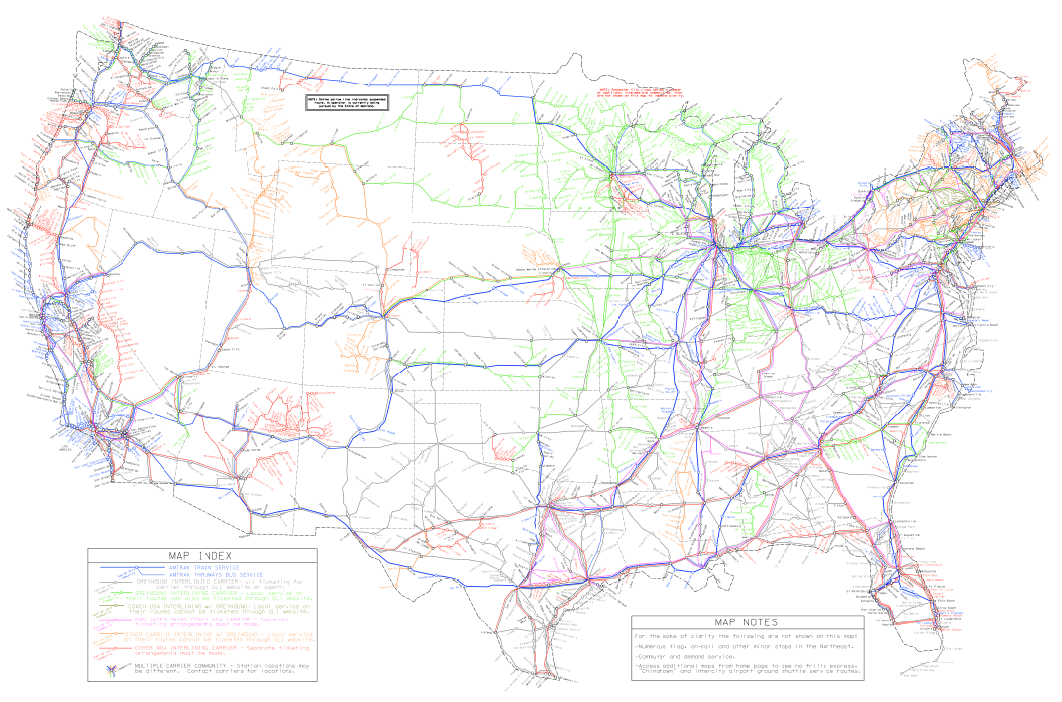
This painstaking map (click to embiggen, but you’re going to want to go to the full-size version ) is a labor of love by the American Intercity Bus Riders Association, and it shows all the intercity transit routes in the U.S. In theory, you could use this map to traverse the country by rail and bus alone, never getting in a car.
Greater Greater Washington has a caveat:
It’s probably impossible for this kind of map to be 100% accurate all the time. In all likelihood there are some missing links, and missing carriers. But it’s still quite an impressive undertaking, and a useful tool to bookmark. Grist thanks its sponsors. Become one . To support our nonprofit environmental journalism, please consider disabling your ad-blocker to allow ads on Grist. Here's How
So, you know, keep that in mind as you light out on your trip to crisscross the United States without entering a single vehicle that holds fewer than 50 people. It might take most of your life, but it can be done, and now you know how.
A message from
All donations DOUBLED!
Grist is the only award-winning newsroom focused on exploring equitable solutions to climate change. It’s vital reporting made entirely possible by loyal readers like you. At Grist, we don’t believe in paywalls. Instead, we rely on our readers to pitch in what they can so that we can continue bringing you our solution-based climate news.
Grist is the only award-winning newsroom focused on exploring equitable solutions to climate change. It’s vital reporting made entirely possible by loyal readers like you. At Grist, we don’t believe in paywalls. Instead, we rely on our readers to pitch in what they can so that we can continue bringing you our solution-based climate news.
This newborn two-toed sloth is better than whatever else you were looking at
Grist thanks its sponsors. Become one .
To support our nonprofit environmental journalism, please consider disabling your ad-blocker to allow ads on Grist. Here's How
From Australia to the Arctic, young Indigenous changemakers speak out
Pediatricians say climate conversations should be part of any doctor’s visit, what the eclipse reveals about the progress and shortfalls of us energy, elizabeth kolbert wants us to rethink the stories we tell about climate change, a highway in indiana could one day charge your ev while you’re driving it, a water crisis in mississippi turns into a fight against privatization, indigenous leaders are risking their lives to speak at the un, rivers are the west’s largest source of clean energy. what happens when drought strikes, modal gallery.

Flights are one of the most obvious ways to travel between cities in the United States, but that doesn’t mean that they’re the most affordable, comfortable, or even the most memorable. In fact, there are many other methods of transportation for making your way across the USA which you may find more appealing. American cities with the best public transportation.
Whether you’re not a fan of flights, or want to take in some of America’s world class scenery along your way, the following are alternative ways to get around when exploring the States. Best way to get across the USA.
The US was made for iconic roadtrips . Whether you’re aiming for the Pacific Coast Highway , or from Florida to Washington DC, anyone with a car can go anywhere, and the nice thing about this mode of transportation is that the journey is the destination in itself – a road trip is an adventure!
No other mode of transportation allows for the convenience and freedom that your own car does. Self drives offer 100% flexibility. You don’t have to stick to timetables or schedules, and you can change your plans as you go along. Spontaneous detours make for the most memorable parts!

Train Travel
Flying between cities means you’ll see nothing of America. You’re at 35,000 feet. However riding the train means taking in America’s picturesque backdrop along the way. Best way to travel America on a budget. Travel America without flying.
Depending on your route, your window seat view may include towering mountain peaks, desert vistas, spiral tunnels, and unnervingly steep grades. With everything from bustling metropolises to rolling prairies and plains, and expansive national parks along many railway lines, this is the best way to maximize your sightseeing. Train travel in America. United States train travel.
Those considering train travel in the US have the choice between train vacations, or utilizing public transportation to get from point A to point B. Whether you’re catching the train from nashville to chicago or aiming for an iconic long distance train, with more than 1000 routes and journeys, there’s sure to be something to suit you. Can you get across USA by train?
Pro Tip: Some trains allow you to travel with your motorcycle or car. You sit in a typical passenger car, while your vehicle rides in an enclosed car carrier at the end of the train.
As with air travel, you should be prepared to deal with cancellations and delays. Consider booking a sleeper car if traveling overnight, and make sure these reservations are made well in advance (traveling with earplugs will ensure a good nights sleep). You should dress comfortably, and avoid close connections. Never leave your luggage unattended on the train or in the station. If traveling overnight, secure our luggage to the rack with a lock.

Bus travel throughout the US is a fabulous mode of transport. It’s eco-conscious, tech-friendly, and very inexpensive. Some serve drinks. Some sell tickets for as cheap as a dollar. The best part is that you’re accompanied by music, internet, movies, the occasional snack bar, and best of all, a very competent driver. What are buses like in the USA?
Regional buses will ferry you throughout each State, and fantastic networks operate long distance routes. Also, “buses take certain routes to cities that are difficult to get to by train. Not every type of landscape is ideal for railway tracks and not every small village has a train station, so choosing the bus can take you to local areas and unique countrysides. “ America long distance buses.
When making your booking, consider if the ticket is refundable, how long the layover is between connections, and if you need to print your ticket. It’s advisable to be at the bus station an hour in advance, and you should make sure you’re traveling with a valid ID.
Take a Bike Tour
If flying isn’t for you, perhaps a two-wheeled, man-powered road trip that involves riding, camping, and slowly following whatever path you decide to lay out before you is more your speed. Ride a bike across America.
A long-distance bike ride is a great option for exploring the States for those who aren’t restricted by time. Depending on your route, this could lasts anywhere from a few weeks to couple of months. And the great thing is that anyone can do it. Cheapest way to travel across America with no money.
Among other things, bike touring will restore your faith in humanity (you will meet many amazing people and be blown away by their kindness), and will force you to travel slowly, immersing you in regions, towns, and people that simply aren’t possible through other forms of travel.

Related: Top 5 Reasons You Should Go on a Bike Tour
Hitch-hiking
If you’re willing to forget what your mother told you about jumping in cars with strangers , hitch-hiking can be another way to make your way across the United States. Is it safe to hitchhike across America?
Hitchhiking is about trusting strangers in a world where we’re taught to fear the unknown. While it is essential to have your wits about you and to be assertive , hitchhiking doesn’t always have to be a dangerous game. It is the way to connect with communities from around the world, and to see places you would never see from the seat of a plane. Hitchhiking in the USA.
Keep in mind that hitchhiking on freeways is prohibited. Hitchhiking in rural areas and in Alaska and Hawaii is more common, though keep in mind that with sparse traffic it’s easy to get stranded. It’s very common to hitch a ride in and around national parks to get to and from trailheads. If you’re not keen on this idea, you can always check ride-share boards at hostels, park visitor centers and wilderness information stations.
INSPIRED? PIN THIS TO YOUR TRAVEL PINTEREST BOARDS ↓

If You Liked This Post You May Also Like:
7 Reasons to Travel With A Hobo Hammock
How Much to Tip Valet Parking in the United States
The Most Amazing Natural Wonders Of The United States

Megan is an Australian Journalist who has been travelling and blogging since 2007, with the main aim of inspiring others to embark on their own worldwide adventure. Her husband Mike is an American travel photographer, and together they have made the world their home.
Committed to bringing you the best in adventure travel from all around the globe, there is no mountain too high, and no fete too extreme! They haven’t been everywhere, but it’s on their list.
Follow their journey on Facebook , Twitter , YouTube , Pinterest and Instagram .
46 Comments
Cool article! My girlfriend and I did 8,000 miles around the US in our truck, it was an incredible experience. Next I’d like to take the train across Canada.
Thanks Jim! Wow that does sound like an incredible experience! Train across Canada is a great idea … we recently published a guest post about what it’s like to explore the Canadian Rockies by train if you’re interested :) http://www.mappingmegan.com/trans-canadian-adventure/
Done 13000 miles on US road trips in the past two years. Going on another starting next week. Can’t wait. There’s just too much to see in North America.
Nice one Tom! Sounds epic!! Where are you headed this week? We’ve done a couple of 3 month roadtrips throughout the US and just absolutely loved it. Our most recent was the drive from San Diego to Alaska – you’re so right … so much to see!
Great ideas here – a road trip appeals to me most.
Thanks Rhonda – yes, the roadtrip is my method of choice … nothing better than an iconic American roadtrip!
I would love to go on a long road trip! We drive from Arizona to Oregon almost every Christmas and i think that is the farthest I have done. I want to plan a really big road trip some day. A few Summer ago we did fly to DC then took a train to Philly and NY. That was a pretty fun trip.
Sounds fantastic Tanya! I imagine the roads would get pretty snowy past Oregon around Christmas time, but if you have the chance in the summer, I can highly recommend continuing North towards Canada and up into Alaska. We did San Diego to Alaska last summer and it was one of the most memorable trips of my life … loved every second of it!
For a road trip in a car it can be hard to find a better country to do it in than USA. But for long distance public transport (trains/coaches) it can be quite a bit of hassle (a lot more than, for example, travelling across europe)
Absolutely – I think America is one of the best countries in the world for a roadtrip such a huge country to work with and one which offers a lot of diversity.
Europe as definitely managed to perfect long distance transport down to a fine art – it was such a smooth process traveling throughout Europe by train when we were there last. I think America has pretty good systems in place too though :)
When I was in the US I flew and took the bus (Megabus is extremely cheap and I had awesome deals) but my dream is actually to do a road trip – classical Road 66 :) Never considered a train though….
We did parts of Route 66 and it was a really memorable trip! Had a blast! I hope you have the chance to organize a trip soon … you should look into one way car rentals if you’re looking for some smart ways to save. Often car rental companies will need to get a car back from one location to another, so they’ll offer travelers a free rental and give them a specific timeframe to get it back to location (A). Saves them money on having to transport the car and hire a driver :)
I love roadtrips! Would love to do a roadtrip in the US someday, I alwo want to see the famouse route 66 someday! Thanks for sharing thism
Aren’t they the best!! We did parts of route 66 last year and loved it … public transport throughout the States is great, but a roadtrip gives you the flexibility to stop and take it at your own pace. And especially since there are so many road side attractions in the US, it’s better to travel with your own car :)
I’ve done many road trips in the U.S. and love the towns and places you see that would otherwise be missed on a plane! I’ve actually driven through all 48 continental states and loved it! I wish the U.S. had better train options, though. They can take longer than a car and be quite expensive. I’d opt for bus instead.
Absolutely Jackie! And wow, you’ve really covered the States with your car! I think as time goes on options for trains will start to increase and will become more competitive and efficient. Buses are already there so are a pretty great option when you don’t have access to your own vehicle :)
The US is such an easy place to travel around. Although the distance between places is quite vast, roads are really good. I’ve did a roadtrip with my family years ago and drove from California all the way to Canada. Since then, every time i go to the US, I have taken buses, trains, and gone on many roadtrips since.
I agree – the roads throughout the US are wonderful – granted, there’s a lot of road work construction all over the country at the moment, but we’ve realized this is a worldwide thing and you can’t really escape it. I saw a documentary recently which said that the rate at which we’re suing the roads can’t keep up with our ability to maintain them!
Probably my favorite way of traveling is by train but recently, I’ve been really enjoying my road trips. I traveled through France, Belgium, Spain and the U.K. with my family by driving and I imagine it would be fantastic to drive through the U.S.A. There’s also a beauty traveling by train so we don’t have to worry about parking or traffic, just sit back and relax.
I really enjoy traveling by train too, though I do love my roadtrips! Love that some of the trains in the US will transport your car too, you can combine them both :D
I use public transportation as often as possible, but my intercity travel is typically limited to airplanes and trains. Have you to ride on a Greyhound or Megabus.
Planes and trains are definitely a great option for the fastest route somewhere – have taken a lot of buses in my day too though where those haven’t been an option. I can sleep really well on buses for some reason :)
I love taking different modes of transport, one of my favourite experiences has to be taking the Glacier Express in Switzerland. The large windows made it so enjoyable, no better way to catch their majestic mountains!
Wow, the Glacier Express in Switzerland sounds like it would be amazing Mar! I can imagine especially during winter, the views would be incredible!
Great suggestions and I know you are a pro at traveling so I value those opinions. I am so excited to add train travel to my repertoire in 2017. My husband and I will take a train trip across Canada to celebrate our 25th Anniversary!! I want to sample the local buses here in Florida, too. They are around $33 and you get free WIFI and it goes all through the state as well as toward New Orleans or Atlanta.
You’ll have a fabulous time training it through Canada Melody – one of the best countries for your first trip … happy anniversary in advance!
And I love that public transport is now including WiFi for passengers … massive bonus over flying :D
I would most definitely opt for train travel. This would probably be the best paced and best spaced for me. I usually have trouble not being able to stretch my legs and I have a hard time finding a comfortable position in long bus rides. I’ve taken almost every mode of transportation possible and scenic train rides are what I still enjoy the most. Thanks for the tip, Meg! Been really looking to explore more of the USA soon!
Some great long distance train journeys available in the US Trisha, one of my favorites is the Alaskan Railway, so if you’re a fan of scenic train rides, that’s definitely one you should aim for :)
Traveling by air may be faster, but roadtrips are a great way to see so many different landscapes and areas. Thanks for sharing!
Absolutely Mary – spontaneous detours make for the most memorable parts!
My favorite way of traveling in the US is definitely by car, even though it takes more time. There is so much to see and do, I’d never want to skip all of that by planes. And yes, the detours are usually the most surprising, especially when you don’t expect it and try to be a bit more adventurous… I am hoping to head back to the USA next year for another roadtrip!
Absolutely – you hit more of the real country when you travel by car – able to take in small little regions and tows you would otherwise miss when flying. And there are so many quirky and cool roadside attractions dotted throughout the States that to fly and miss them would be a shame!
Hope you have the chance to get back to the States soon :)
Thanks for sharing this! My boyfriend and I are travelling to the USA later this year, neither of us can drive and we don’t want to take flights due to carbon emissions. Buses and trains will be out top choices I think, and like you said, we’ll get to see some great landscape…can’t wait!
Hi Helen, glad you found the post helpful :) Buses and trains do have their perks for sure – you’ll get to see some of the most amazing scenery along the way which you would have missed from the window seat of a plane :)
Happy travels!
Great post, Megan :) I love road trips. They offer a lot of freedom. I also love it when someone else drives! I came across a great resource for finding, comparing and booking bus and train travel. I’ve used it sevetal times and got great low fares. Highly recommend! Check it out: bit.ly/2zbA6TT
Thanks Amy! Yes, roadtrips are the best when it comes to freedom :) Thanks for the heads up on Wanderu – will check it out too!
I’m doing it!
Awesome! Hope you’re having a fab trip!
I haven’t started, yet. I’m sure it will be much better with your tutorial! Lol. I should have said “soon”.
In that case have a great trip :D
I did 3 weeks or so from Oklahoma to Highway 1 a couple of years ago. Nothing but backroads. Awesome!
Sounds incredible! I love traveling the backroads – always unexpected surprises and attractions which don’t make the guidebooks waiting for you to stumble upon :)
Exploring the States on a Bike is the best idea. Agree with the point that bike touring will restore your faith in humanity & you got a chance to explore in detail.
Glad you enjoyed the post Berry, bike tours are the best!
Roadtrip has always been one of my favorite way of traveling. A road trip is unmatchable when it comes to traveling.
My favorite too :D Happy travels!
Post a Reply Cancel reply
Your email address will not be published. Required fields are marked *
Save my name, email, and website in this browser for the next time I comment.
Search This Site

I am Megan Jerrard, professional travel blogger/journalist with a focus on adventure, discovery, immersion and inspiring you to explore!

Recent Posts
- The Stats on How Travel Affects Your Relationship
- A Woman’s Guide to Staying Healthy on the Go
- The Ultimate Guide to Marketing Travel Portrait Photography
- An African Dream: Must-See African Destinations for 2024
- The Best Sustainable Ways to Get Around on Vacation
Popular posts
- International Love: Maintaining a Long Distance Relationship
- Illegal Ink – 11 Countries Where Showing Your Tattoos Could Get You Kicked Out!
- 7 Things To Know Before Travelling by Overnight Train in Vietnam
- A Travelers Guide to Tap Water: Countries Where The Drinking Water is Unsafe
- Countries That Don’t Celebrate Christmas
Ways to Cross the United States Without Flying
Cross the country by train, car, bike or even on foot
:max_bytes(150000):strip_icc():format(webp)/msh-typing-56a6dafe3df78cf772909166.jpg)
Ken Paul / Getty Images
Overground travel is one of the best ways of seeing any country, and while it is possible to travel from the East Coast to the West Coast in a few hours by air, there really isn't a sense of the journey or the country that you are traveling through. There are plenty of different ways to make the journey, and whether you are traveling for business or pleasure, taking a bit more time about the trip can make it a lot more enjoyable. Domestic flights are quite competitively priced, but these options will often prove to be a cheaper way to travel too.
Crossing the Country By Train
Although Amtrak doesn't operate a network as extensive as the train network found in Europe, there are several ways to get across the country by train. Those traveling from east to west have the choice of a northern and southern route, and two central routes, with the northern three routes passing through Chicago, and the route through the south of the country passing through New Orleans and Houston. Traveling by train is a very pleasant way to see the country , and while it certainly isn't a high-speed journey it offers some large windows for those wanting to enjoy the views, and the option of a cabin so that you can sleep as you travel.
Driving is one of the most American methods of transport, as most people in the country own a car. Driving across the country is something that can be done in a couple of days if you are in a rush, but to get the full experience it is best to get off the highway and explore some of the more rural roads. The best road trip route for you will depend on where you want to start and end, but one of the classics is to drive to Chicago and then follow Route 66 all the way to California. Make sure you stay in mom and pop bed and breakfast places and break regularly to enjoy the area you are traveling through, as it will help you to have a truly memorable experience.
Cycling Across the USA
This is one of the most interesting ways to see the country, and while walking is a method that can take a long time, it is possible to cover this by cycle in as little as a few weeks. Depending on the route that you take and your cycling speed, this can vary significantly, especially as the most direct route across the country is not necessarily the most interesting or the most attractive route. One potential option is the Trans America Trail , which is over four thousand miles, running from the town of Astoria in Oregon to Yorktown in Virginia, and commonly takes around three months to complete.
Walking Across America
There are relatively few people who choose this option, as it is an awfully long way to walk, and it will almost always take a lot of time, from four months to a year to complete. Nonetheless, it is a wonderful challenge and it also offers the option of choosing some spectacular routes, with a crossing of the Rockies one of the options that will provide memories to last a lifetime.
With the scenery, roadside attractions, and historical landmarks, the United States is certainly a county worth exploring.
How to Travel From San Francisco to Lake Tahoe By Train, Bus, Car, and Plane
Plan the Perfect Trip to Spain
How to Cross the Border From San Diego to Tijuana, Mexico
Riding The Empire Builder Train From Chicago to Seattle
Glacier National Park: The Complete Guide
A Complete Guide to the Mississippi River Road Trip
14 Amazing Private Travel Experiences
20 Amazing Train Journeys Through Mountain Scenery Around The World
Guide to an Atlantic Coast Road Trip
A Guide to Public Transport in Cuba
How to Travel From Amsterdam to Venice by Train, Bus, Car, and Plane
6 Great Options for Cheap Bus Travel in the U.S.
Where to Go in 2021: 10 Future Trips You Can Start Planning Now
Cross the City or the Continent With These 6 Great Transport Planners
How to Travel From Chicago to Denver by Train, Bus, Car, and Plane
Crossing the English Channel From Continental Europe

An official website of the United States government
Here’s how you know

Official websites use .gov A .gov website belongs to an official government organization in the United States.
Secure .gov websites use HTTPS A lock ( Lock A locked padlock ) or https:// means you’ve safely connected to the .gov website. Share sensitive information only on official, secure websites.

- For U.S. Citizens/Lawful Permanent Residents
- Know Before You Go
Before Your Trip
Booking your tickets.
Match Names on Tickets and Documents
Purchase your travel tickets in the exact same name that appears on your passport or official ID. Ensure that all travel documents match that name precisely.
If the names don't match, your travel carrier or the Transportation Security Administration may require additional documents to verify your identity before allowing you to board.
Each Country is Different
Learn the required travel documents for each country you will visit. Find out about specific travel warnings, U.S. import restrictions, and other rules that apply to the countries on your itinerary by visiting www.state.gov/travelers .
Find the latest on making your return to the United States problem free - go to www.cbp.gov/travel .
Documents You Will Need
Carry - do not pack - all travel documents.
- All U.S. citizens need U.S. passport books if re-entering by air. Land and sea border crossings accept additional travel documents, such as U.S. Passport cards and Trusted Traveler cards. Child travelers have additional options - see the Traveling with Children section.
- Green card (Form I-551), or document for lawful permanent residents, or advance parole (Form I-512) if your Form I-551 is pending.
- A visa or other entry document for the countries you will visit.
- Receipts or registration ( CBP Form 4457 ) for new electronics, such as a camera or laptop, that you are taking abroad. (Only suggested if the goods are less than six months old.)
- Proof of rabies vaccination for dogs traveling abroad. Check the requirements for other pets at www.aphis.usda.gov .
- Valid license for driving overseas and for use as a second form of photo ID.
- Permits and/or certificates if bringing restricted animal or plant products - go to www.aphis.usda.gov .
- Medications in their original packages. Bring only the amount of medication you will need. Prescription medications have to be under the traveler's name.
- Envelope to hold the receipts of your purchases abroad.
Traveling with Children
When U.S. citizen children under the age of 16 arrive by land or sea from Canada or Mexico they may present an original or copy of their birth certificate, a Consular Report of Birth Abroad, or a Naturalization Certificate.
Groups of Children: U.S. citizen children under the age of 19 arriving by land or sea from Canada or Mexico and traveling with a school group, religious group, social or cultural organization or sports team, may present an original or copy of their birth certificate, a Consular Report of Birth Abroad, or a Naturalization Certificate. The group should have a letter on organizational letterhead with:
- The name of the group and supervising adult(s).
- The names of the children on the trip and their primary address, phone number, date and place of birth, and name of at least one parent or legal guardian for each child.
- A written and signed statement of the supervising adult certifying that he or she has parental or legal guardian consent for each child.
9 Ways to Travel Cross-Country Without a Car
No matter where you're going or how long it takes to get there, it's not as hard as it sounds to do a road trip without a car. If you plan ahead, do your research and are prepared for a little physical exercise, you just might find that this type of road trip is even better than driving.
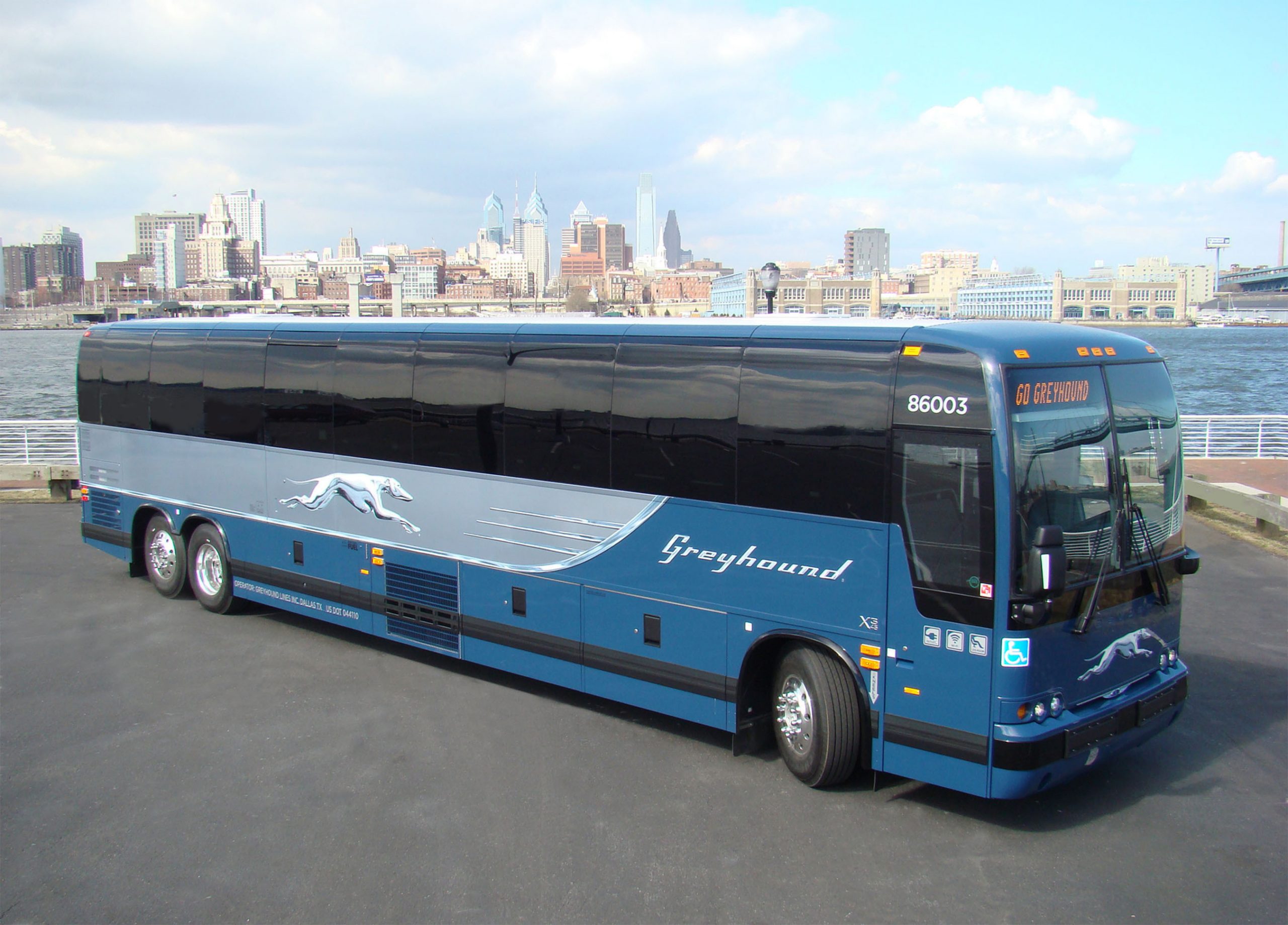
1. Save Money by Riding on A Bus
Traveling by bus or coach is another great use of public transport if you’re looking for ways to road trip without a car, particularly if you’re keen to stick to a budget. Buses are often the cheapest way to travel in any country, with some unbelievably low fares available if you’re organized and book in advance. This applies internationally too, so you could even take the bus from home rather than fly if it’s doable, saving even more money. Many buses nowadays have added perks such as free Wi-Fi, charging ports, air-conditioning, and sometimes screens for you to enjoy movies and music as you travel. Bus services also tend to be really generous with their luggage allowance, often letting each passenger bring a large suitcase plus a smaller bag regardless of weight.
2. Take the Train and Enjoy the Views
Taking the train is probably the most common and popular alternative to driving and can be a great way to enjoy a multi-stop trip that doesn’t require a car. Most countries, particularly those in Europe, have really well-connected rail links that are relatively inexpensive, making it easy to plan a full road trip itinerary that relies completely on the railway. One of the biggest pros of train travel is that it’s often far more relaxing than driving – all you have to do is book a seat, turn up, and catch the right train. By eliminating the need to drive you’re also upping the quality time you can spend with your travel companions to play some road trip games, as well as freeing up a precious few hour to get deep into your new book and make the most of the stunning views outside.
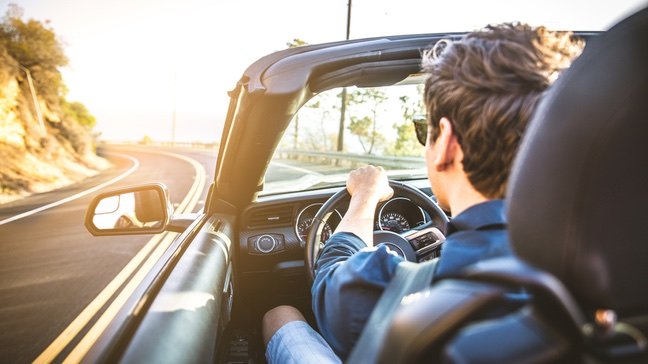
3. Save The Planet by Opting for A Car Ride-Share
Finding someone to ride-share with is definitely the best option if you want that classic car road trip feeling minus the driving. This form of glorified hitchhiking is completely legit, safe, and comfortable if you know which tools to use. Many companies and apps offering ride-share services let you view drivers’ profiles and choose who you want to travel with based on their rating and previous passengers’ experiences. This form of travel is really affordable as you just contribute towards fuel and it also has the added benefit of being better for the environment than a plain old road trip. By sharing a ride, you’re simply filling a seat in someone’s car who’d be driving that route anyway, avoiding the need to put another car on the road unnecessarily – which is always a good thing.
4. Cycle the Most Scenic Road Trip Routes
The most active and adventurous way to road trip without a car is by cycling between your stop-offs – an amazing way to make the most of a place and really appreciate your surroundings. Choosing a bike over a vehicle will allow you to go well off the beaten track where cars can’t venture, including country paths, mountain tracks, and thick forests, giving you a completely different perspective than the one you’d get from being on the other side of a car window. The good news is that e-bikes, which give you an electronic boost to make cycling a little easier, are also zero-emission. That means that even if you’re not a confident cyclist, you should give this form of road trip a go – you don’t have to be super fit.
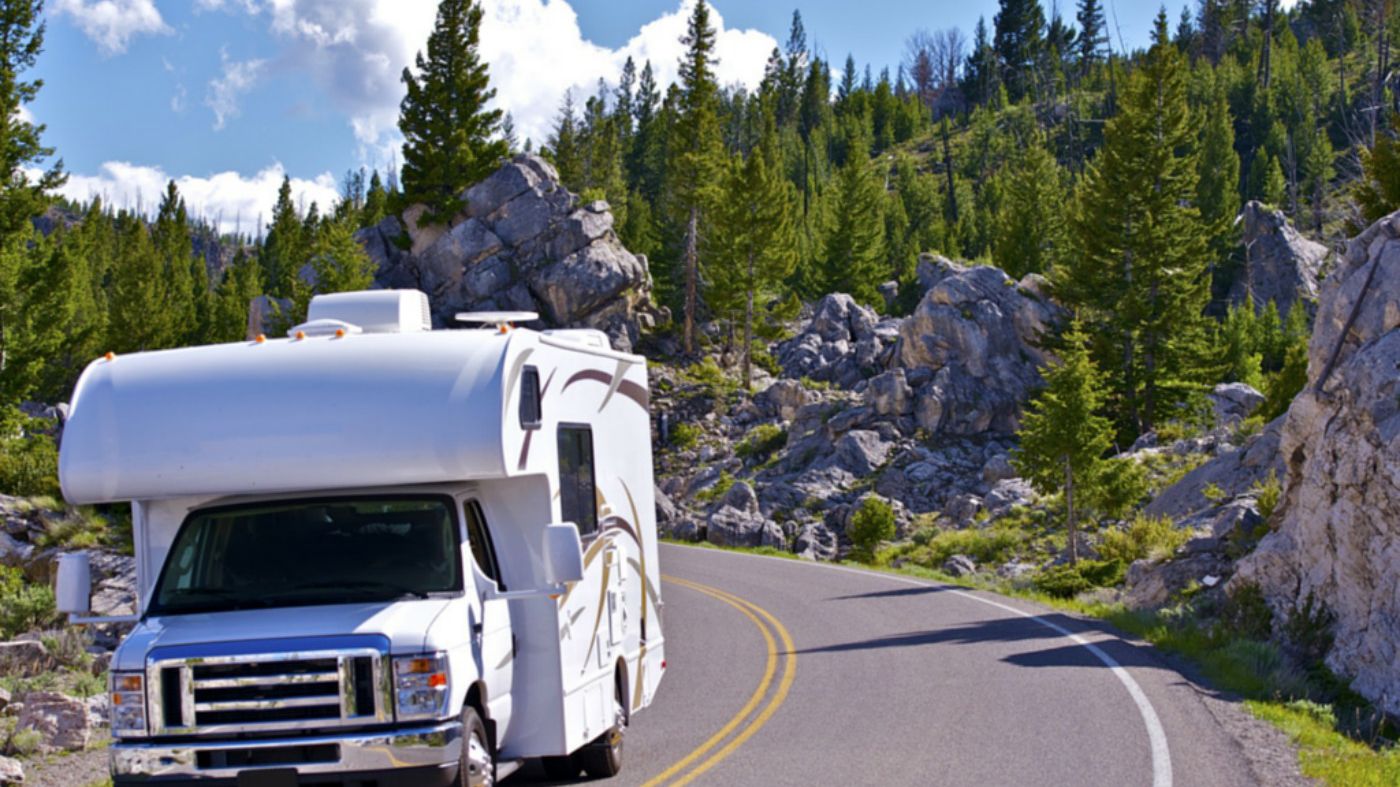
5. Relocate a Car or RV
Okay, so technically by relocating someone else’s vehicle, you’re still traveling via a car, but talk about a travel hack; this is one way to explore the country without needing a car of your own. When a rental company needs to move an RV — or car, truck, or camper van for that matter — from one office to another, you can capitalize on a road trip. It’s a unique, affordable, and adventurous way to get from Point A to Point B, and there are some major players you should know about. If you’re at least 23 years old and have clean driving record, Auto Driveaway can connect you with cars that need to be relocated. The first tank of gas is free, and you can bring friends. Trips range from a couple cities away to true coast-to-coast long hauls.
6. Hitchhike
Hitchhiking is nothing new. It’s not the most reliable way to travel, of course. You never know how long you’ll be standing at the side of the road. However, if luck is on your side you can travel without a car and not spend a cent. Safety is always something to consider. But, if you use your instincts and refuse rides when you don’t feel comfortable, you’re likely to be okay. Older people are more likely to pick you up as they used to hitchhike and nostalgically wanted to pay it forward. Also, younger types who are quite laid back and enjoy the company on their journey. Always check local law to find out if you are allowed to hitch hike.

7. Good Old-Fashioned Hospitality
Don’t be afraid to ask for help along the way. If you’re planning a cross-country trip, post about it on social media. Ask friends about their connections in your destination cities and seek out recommendations for local hot spots. Not only will you make new friends and discover some cool places, but you’ll probably stumble across connections who are willing to help you travel around the city or state. Don’t be afraid to ask for a ride, especially from your accommodations. If you’re staying at a hotel or bed and breakfast, they may be willing to bring you to your bus station or a nearby town. Even if the hotel doesn’t advertise transportation, especially during off-hours when hotels aren’t packed with visitors. Even in the digital age, people are still willing to help travelers out.
Although this can vary depending on how far in advance you book and what day or week you fly, you may be surprised to know that flying is often both the cheapest and quickest option. If you book far enough in advance and are flexible, you can get some really great deals. However, depending on seasonality, flights can skyrocket to the thousands, so keep this in mind. Of course, you don’t get the views or experience of hitting the road in a bus, car or train, but if both cost and time is your priority, consider taking a plane.
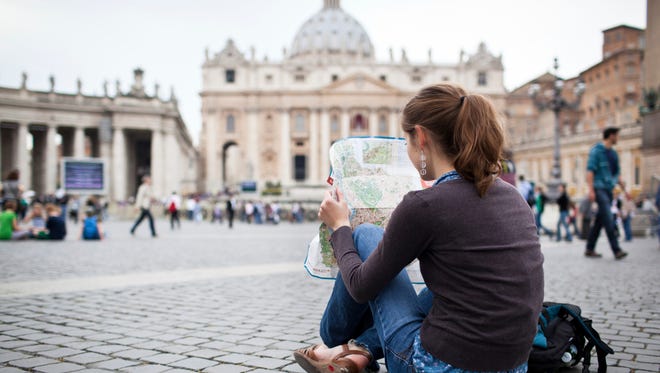
9. Choose Your Destinations Wisely
When planning your travel in the United States, there’s plenty to consider. As a first-time visitor you’ll probably be tempted to see the major sights – New York City, Miami, Las Vegas, but if low hotel rates, affordable food, and free attractions are what you’re after, then you’ll have to look somewhere else. For instance, lesser-known American cities such as Savannah, Charleston, or San Antonio offer excellent sightseeing at a fraction of the price, plus rich history, inexpensive entertainment options, and lots of local charm. Memphis and Nashville are both excellent destinations if you want to learn about America’s fantastic musical history and indulge in traditional Southern cuisine, while Washington, DC has some of the best free attractions in the entire country.
More Adventure

5 Largest Pyramids in the World

Guide to the 2022 Soccer World Cup Stadiums

Ten Things to Do When Planning Your First Trip to Dubai

The Best Time to Visit Hawaii

6 Largest Indoor Water Parks in the World
Update April 12, 2024
Information for u.s. citizens in the middle east.
- Travel Advisories |
- Contact Us |
- MyTravelGov |
Find U.S. Embassies & Consulates
Travel.state.gov, congressional liaison, special issuance agency, u.s. passports, international travel, intercountry adoption, international parental child abduction, records and authentications, popular links, travel advisories, mytravelgov, stay connected, legal resources, legal information, info for u.s. law enforcement, replace or certify documents, get a passport.
Renew or Replace a Passport
Get My Passport Fast
Prepare to Apply
Passport Help
Legal Matters
Share this page:
Apply for your First Adult Passport
Apply for a Child Under 16
Apply as a 16 or 17 Year Old
Get My Application Status
Get a Passport Card
Respond to a Letter or Email
Apply Outside the United States
Selecting your Gender Marker
Crossing the U.S.-Mexico Border by Land
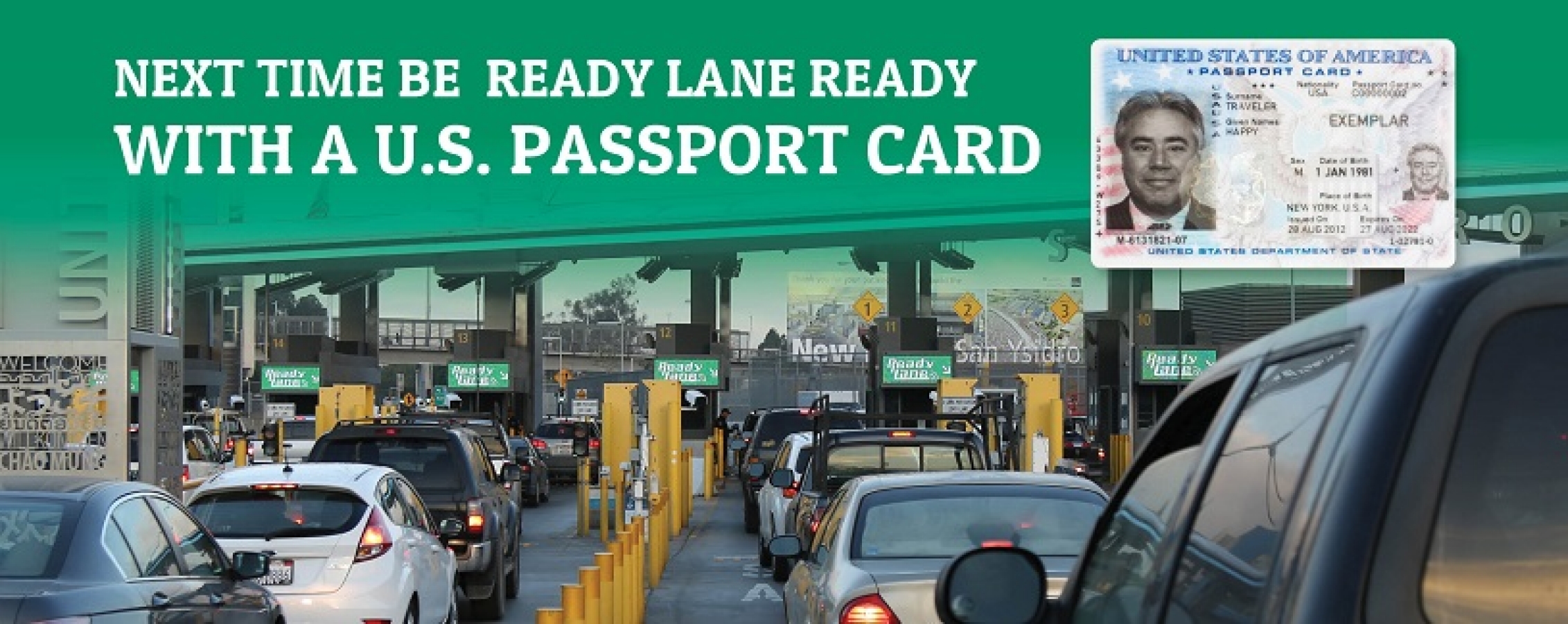
External Link
You are about to leave travel.state.gov for an external website that is not maintained by the U.S. Department of State.
Links to external websites are provided as a convenience and should not be construed as an endorsement by the U.S. Department of State of the views or products contained therein. If you wish to remain on travel.state.gov, click the "cancel" message.
You are about to visit:
My Teen Son Stole My Car & Drove Across the Country While I Was on a Work Trip
A 17-year-old driving his dad’s car without permission took things to extremes when he traveled more than 1,330 miles from Wisconsin to Florida, investigators say.
Flagler County sheriff’s deputies arrested the teen April 24 at a gas station in Palm Coast, after his dad reported his car and his son went missing while he was out of town, officials said. Palm Coast is about a 60-mile drive south of Jacksonville.
More from CafeMom: 8-Year-Old Found Driving Around St. Louis With Mom Passed out in the Back Seat
'Deputies determined (the teen) had stolen the vehicle from his father while he was away on business,' the sheriff’s office shared in a news release.
“He was restricted from driving his father’s car after being stopped by local law enforcement in Green Bay, Wisconsin, a few weeks prior for driving recklessly,” according to deputies. “He had stolen the keys and left Wisconsin two or three days prior.”
The teen was arrested and charged with grand theft auto, officials said.

Investigators have not reported his intended destination in Florida.
By coincidence, he had been stopped for speeding in a Flagler County school zone the day before his arrest, but the vehicle had not yet been reported stolen, officials said. He was given a written warning for driving 31 mph in a 20 mph zone, officials said.
More from CafeMom: A 10-Year-Old Allegedly Stole an SUV & Drove on the Interstate in Attempt To Find His Mom
An 18-year-old woman from Wisconsin was found in the driver’s seat of the vehicle when it was stopped, and she was also arrested and charged with grand theft auto and contributing to the delinquency of a minor, officials said.
“A runaway in a stolen car is a recipe for disaster, but due to our team’s efforts a stolen car was safely recovered, a missing juvenile was found and arrested before anyone could get hurt, and his adult accomplice gets to spend the remainder of her Florida vacation in (jail),” Flagler County Sheriff Rick Staly shared in the release.
-by Mark Price
©2024 The Charlotte Observer. Visit charlotteobserver.com . Distributed by Tribune Content Agency , LLC.

Here Are The Costs To Consider When Renting A Car To Drive Coast-To-Coast
- Renting a car and driving across the United States can cost around $1,615, including rental fees, gas costs, and other factors.
- Renting a car for a road trip involves insurance, deposits, and limitations on roads and mileage.
- Renting an electric or hybrid vehicle can offer a more sustainable and cost-effective option for driving across the country.
The costs and benefits of renting a car and driving it across the United States are a little complicated. It may even be preferable to buy a car if you would like to take some time to drive across the country. Altogether, it can cost a lot to drive across the United States , depending on factors like rental costs, varying gas prices, and other factors.
One of the main benefits of renting a car and driving it across the States is that one doesn't need to drive it back for a one-way road trip. There are many frequently asked questions about how to have a great road trip across the United States , but renting a car brings its own suite of questions and considerations.
What To Know About Renting A Car To Drive Across The United States
Renting a car for a road trip involves insurance, deposits, and limitations on roads and mileage.
There are plenty of things to consider when driving across the States with a rental car. Not only is it important to check that it is possible to leave it at an outlet at your destination, but also other costs like insurance and any limitations (like limited mileage and roads where it is forbidden to drive the car).
The rental company may also require a significant deposit to secure your rental, with the balance due upon pickup.
Rental cars come in all shapes and sizes and rental prices start at around $1,251 (for a Ford Focus for 14 days pick up at New York's JFK Airport and return to Los Angeles LAX). For around $1,316, it is possible to rent a Ford Edge or similar standard SUV for 14 days. So a reasonable rental fee ranges from around $1,251 to $1,316 and above.
- Rental Fee: From Approx. $1,251 (for a small car and 14 days) to around $1400 for an SUV).
Check the rental policy for unlimited mileage, insurance costs, and which roads the car is forbidden from driving on.
Other things to check are the coverage if the car breaks down and what the process is for paying any tolls, parking fines, or speeding fines that the car may have at the end of the trip. Some rental companies will pay these fines but then penalize the renter with extra fees.
Additional surcharges may apply depending on where you pick up or drop off the vehicle, how old the driver is, and more. Read the fine print — and check for surcharges — before booking.
Cost Of Gasoline For Driving Across The United States
The cost of gasoline to drive from nyc to la is about $264 to $336 depending on the vehicle.
The average cost of gasoline in the United States is around $3 per gallon and a new SUV (like a Ford Explorer ) can get around 27 miles per gallon with highway driving, while a Ford Focus can get around 34 miles per gallon.
- Distance: 3,000 miles
- Cost Of Gasoline: Approx. $264 to $336
It is almost 3,000 miles of driving from NYC to Los Angeles (although consider driving the scenic U.S. Route 20, America's longest road ). One rewarding route to Los Angeles to consider is to drive Historic Route 66 .
A Ford Focus can be expected to consume around 88 gallons and cost $264 in fuel to drive 3,000 miles, while an SUV can be expected to use 112 gallons and cost around $336.
13 Road Trips To Take In The USA That Are Bucket-List Worthy
The emerging option of renting an electric vehicle, evs (hybrids) are becoming a rental option and offer a greener alternative when driving across the united states.
Another option to consider (which becomes more and more of an option with every passing year) is whether the vehicle is electric or a hybrid. On the one hand, many people might prefer gasoline cars for long-distance driving, on the other hand, new (high-range) vehicles enjoy impressive ranges.
- Average EV Range: 224 miles
According to the Electric Vehicle Database , the average range of EVs is now 224 miles on a single charge. Lucid Air Dream Edition R (a luxury vehicle unlikely to be available for rent) has an impressive range of 425 miles and there are plenty of options with a range of 300–400 miles.
The cost of charging an EV is complicated (it also varies if it is being charged at home or not) but an empty-to-full Tesla charge can be as little as $9 or as much as $40.
While the cost of renting an EV may be more than renting a regular gasoline vehicle, the cost of driving it is normally less (EVs are also generally less likely to break down).
Those who do rent an EV should check what the charging infrastructure is like for the areas where they want to drive it. EVs offer a much more sustainable way to travel across the United States .
Total Costs for Renting a Car on a Cross-Country Road Trip
All told, road trippers can expect to spend around $1,600 for a two-week road trip, including rental fees, gas costs, and parking fees. Of course, your mileage may vary when it comes to actual gas mileage, rental fees, and surcharges.

Advertisement
Coming to Alabama: Newsom’s Abortion-Access Ad, Depicting an Arrest
The ad portrays a woman trying to leave the state to have an abortion. The Campaign for Democracy, a political action committee started by Mr. Newsom, the California governor, created it.
- Share full article

By Neil Vigdor
- April 21, 2024
A woman nervously peers into her rearview mirror as a patrolman activates his car’s lights and sirens. She is less than a mile from leaving Alabama to seek abortion services, but it’s too late: The next thing she knows, she is being handed a pregnancy test and is handcuffed.
The encounter is depicted in an unvarnished new television ad called “Fugitive.” The Campaign for Democracy, a political action committee created by Gov. Gavin Newsom, Democrat of California, produced the ad.
It will appear on Monday in Alabama, where Republicans have called for prosecuting women who travel elsewhere for an abortion. The state’s abortion ban, one of the nation’s strictest, outlaws the procedure at all stages of pregnancy, with no exceptions for rape and incest.
“Trump Republicans want to criminalize young Alabama women who travel for reproductive care,” the ad’s narrator says.
The ad then shows the patrolman approaching the vehicle: “Miss, I’m going to need you to step out of the vehicle,” he says, tapping the kit on the driver’s side door, “take a pregnancy test.”
The ad is scheduled to run on broadcast and cable television, along with digital platforms like YouTube, for two weeks, according to the PAC. The cost of the ad buy was not immediately available.
Alabama’s attorney general, Steve Marshall, a Republican, has clashed with the Justice Department and abortion assistance providers over whether the state has the authority to prosecute individuals or groups that help women leave the state to have the procedure.
Last month, Republicans introduced a bill in the Alabama House that would make it a misdemeanor to harbor or transport a minor to seek abortion services.
Mr. Newsom has emerged as a key surrogate for President Biden while harboring future White House ambitions of his own. He has regularly skirmished with G.O.P. governors and Republican-led states over abortion access, immigration, crime and other issues.
While Republicans have seized on crossings at the southern border in their messaging, Democrats have harnessed the issue of abortion-access after the U.S. Supreme Court overturned Roe v. Wade in 2022. It helped propel Democratic candidates to key victories during the midterm elections in 2022 and in races last year.
In February, the Alabama Supreme Court ruled that frozen embryos were people with rights, casting a cloud of uncertainty over in vitro fertilization. The state later passed a law giving I.V.F. clinics criminal and civil immunity, but it did not address whether embryos have the legal status of human beings.
In another seismic ruling, the Arizona Supreme Court this month upheld an 1864 law that bans nearly all abortions. The decision could have far-reaching consequences for women’s health care and election-year politics in the state, a critical political battleground.
Mr. Newsom said in a social media post at the time that California, which borders Arizona, would provide a refuge for women affected by the decision.
“Arizona wasn’t even a state — it was a territory — when this draconian abortion ban was passed,” he said. “That’s how extreme this is. California remains ready to help Arizonans access reproductive health care.”
Neil Vigdor covers politics for The Times, focusing on voting rights issues and election disinformation. More about Neil Vigdor
Browser not supported
This probably isn't the experience you were expecting. Internet Explorer isn't supported on Uber.com. Try switching to a different browser to view our site.
How Central can help keep business moving across industries
Imagine that you could seamlessly arrange transportation for your customers, guests, and employees—all in one place.
With Central, you can. Central enables businesses to request rides for others, even if the rider doesn’t have the Uber app. With a few clicks on the Central dashboard, a coordinator can request rides and track their status, while riders receive trip information through their Uber app or by text. Leveraging the largest mobility network, Central lets businesses in more than 60 countries enhance their transportation offerings.
Central’s offerings can be easily tailored to businesses’ needs within several industries—whether you’re trying to offer customers a ride home from your retail store opening or you want to help move your employees from point A to point B. Read on to hear how 4 diverse industries have been leveraging Central.
Customer service is key in the automotive industry. Almost half of car buyers think about switching brands after having a negative customer experience with an automotive company.
With Central, dealerships can leverage ridesharing to not only elevate a client’s transportation experience but also increase operational efficiency and optimize costs. Many riders have shared that they prefer ridesharing compared with shuttles or loaner vehicles, which could have long wait times, multiple stops, and limited availability. Dealers can use Central to request rides for customers who need to get home or to their place of work while their car is in the shop, for example. And some repair shops are even using Central for parts delivery to complete timely repairs.
Central is a valuable tool to meet the logistics industry’s quickly evolving needs, including in trucking and rail transportation. Given the valuable role that logistics companies play in supply chain movement, it’s important for truck and rail workers to be on time. Logistics companies use Central to request rides for those workers to and from their jobs and between shifts.
And truck-rental companies can even offer customers rides to and from pickups.
It’s easy to customize ride options. Request premium rides like Uber Black for executive transport or select UberXL to get a team of employees from the airport to the retreat venue. Because coordinators can edit trips, add stops, and track a ride’s progress from pickup to dropoff, Central is a great solution for executive assistants supporting leaders and their teams.
It doesn’t stop at guests, though. Hotels located in busy metro areas without ample parking, or where transportation options may not be extensive, can book rides for their employees to make sure they can get to and from work on time and easily.
You can create a free account or use your Uber for Business credentials to log in to Central . To coordinate a ride, enter the rider’s phone number, pickup and dropoff locations, and preferred ride option. The rider will receive a text confirmation with their ride details and a link to track their trip; they don’t need the Uber app, but if they have it, they can track their ride straight from there.
Keep business moving, no matter what industry you’re in
Uber for Business can help.
The platform
Get the best of Uber, for business—including improved cost controls and compliance.
Expense integrations
Save time with automatic expense reconciliation
Sustainability
Get clear climate metrics such as total low-emission trips and average CO₂ per mile.
We make your health and safety top priorities.
Employee benefits
All the advantages of Uber your employees already love, for business.
The dashboard
It all starts here - manage travel and meal programs with easy to set cost controls and more.
Business profiles
Help your employees connect with your company’s Uber for Business account.
Request rides and deliveries on behalf of customers.
Purchase Uber gift cards in bulk for simplified giving.
Uber Health
Reimagine the way patients access care.
Offer business-class perks with an Uber One company membership.
Cover the cost of rides and meals, and pay only when used.
By use case
Holiday gifting
Celebrate the holidays with vouchers and gift cards
Business travel
Oversee your travel program with the flexibility and reporting you need.
Employee commute
Set up a stress-free commute program for your employees.
Event transport
Get attendees to and from your next event.
Employee shuttles
Offer group transportation for daily commutes, cross-campus dashes, and more.
Courtesy rides
Request rides for customers and guests with ease, even if they don't have the Uber app.
Meal programs
One platform gives you the control to provide meals in multiple ways.
Recruit, retain, and reward your employees with Uber perks they want.
Corporate gifting
Exec management
Request rides and meals for leaders.
By industry
Elevate customer service with on-demand rides.
Improve health outcomes and the patient experience by enabling better access to care.
Hospitality
Delight your guests with rides and meals.
Financial services
Keep your employees moving and your clients happy.
Offer rides and meals to employees and constituents.
Customer support
Customer service
Get in touch with us or quickly find answers to top concerns.
Help Center
For admins and coordinators to browse tips and topics.
Product updates
Check out recent updates we’ve made across our platform.
Learning hub
Explore product education, case studies, and industry insights.
Customer stories
See how innovative companies work with us.
Get the latest news from Uber for Business.
- Contact sales
Ukraine-Russia war latest: Moscow 'hit gas facilities crucial to supply in Europe'; Russian murder rate 'up 900%'
Russia hit energy infrastructure in Ukraine this morning - and Volodymyr Zelenskyy now says this could affect supply to the EU. Elsewhere, the British Ministry of Defence has said war-related mental health issues are likely causing murder rates to rocket in Russia.
Saturday 27 April 2024 22:25, UK
- Zelenskyy says Russian attack targeted energy facility 'crucial' to EU supply
- Russia murder rate 'up 900%'
- 'Putin did not order Navalny death,' - US report
- Twelfth person arrested over Moscow terror attack
- Explained : Why is Chasiv Yar the next target for Russia?
- Your questions answered: Will Ukraine launch another spring offensive?
- Listen to the Sky News Daily above and tap here to follow wherever you get your podcasts
That's it for our live coverage for tonight, but you can scroll back for all of today's updates.
British Defence Secretary Grant Shapps has shared this footage of the UK's Storm Shadow missiles being produced.
The long-range cruise missiles have been among the aid sent to Ukraine by the UK, and have been used to strike deep into Russian-controlled territory.
Earlier this week, the UK said it would commit even more Storm Shadows to Ukraine.
The missiles have an official range in excess of 155 miles - although some experts have suggested they may be able to go further.
Mr Shapps said the missiles were also being created to add to British stockpiles to "fight any future wars".
By Sean Bell , military analyst
When the UK provided long-range Storm Shadow missiles to Ukraine, it was done on the understanding that these would only be used to target Russian forces in occupied territory, and not against Russia itself.
Despite the limitations, Ukraine has complied, and that appears to have improved US confidence to the point they are prepared to supply the ATACMS (Army Tactical Missile System) missile.
Indeed, we now understand that the US first supplied the ATACMS last month - in secret - and it appears to have proven its worth with attacks on a Russian-occupied airfield in Crime on 17 April, and earlier this week in an attack on Russian troop concentrations.
But will this new weapon risk an escalation of the war?
Russia knows that it faces strategic failure if the West were to commit fully to the defence of Ukraine, so it will continue to use threatening rhetoric and sabre-rattling to undermine Western political resolve.
The interesting question is whether the introduction of ATACMS will change the course of the war. Long-range missiles are very effective at targeting and influencing the "deep battle" - the logistics that feed the front-line fight. However, they have limited impact on the frontline.
The shortage of Ukrainian weapons is being exploited by Russia, which is making significant battlefield gains.
Volodymyr Zelenskyy has identified that his immediate priority is to "stabilise" the frontlines.
Instead, ATACMS and the new package of Western military support provides Ukraine with a lifeline.
In the city of Kharkiv, municipal workers are helping to clear up an area near a psychiatric hospital that targeted by Russia.
Workers are draining a crater left behind by the attack and also inspecting damaged communication lines.
A 53-year-old patient was injured in the strike.
Ben Wallace has hit out at German Chancellor Olaf Scholz for suggesting British and French troops are on the ground in Ukraine to programme cruise missiles.
The chancellor had previously justified his refusal to send Taurus long-range missiles to Ukraine by saying it would require German troops on the ground to programme them.
He had suggested British and French soldiers were in Ukraine to help with their Storm Shadow and Scalp missiles.
But Mr Wallace said in an interview with German news agency dpa: "[Scholz] was wrong... I can't tell you how Storm Shadows and Scalps are programmed.
"But it doesn't involve people standing around in an airport in Ukraine, it doesn't need to do that."
The former defence secretary also criticised Mr Scholz's hesitation to send Taurus missiles, saying: "You can't incrementally help Ukraine, you know, a bit of this and a bit of that.
"Do we want Ukraine to win? Or do we want them to lose?...
"Ukraine will abide by any restrictions you put on them. So you could give them Taurus. And you could add all sorts of restrictions about where you want it used or not used."
Mr Wallace added that Mr Scholz is "not a leader for conflict at the moment" and that "looking either indecisive, or flip-flopping on certain decisions, or seeming to be out of step with your allies, only aids Putin".
Volodymyr Zelenskyy has said this morning's Russian attack on Ukraine's energy sector had targeted gas facilities important for supply to the European Union.
The main target was the energy sector, various facilities in the industry, both electricity and gas transit facilities," he said in his nightly video address.
"In particular, those gas facilities that are crucial to ensuring safe delivery to the European Union."
Moscow earlier claimed its strikes were "in response to attempts by the Kyiv regime to damage Russian energy and industrial facilities".
Australia has announced a military aid package for Ukraine worth 100m Australian dollars (£52m).
Defence minister Richard Marles said the money will be used to fund short-range air defence systems, drones for the Ukrainian military and equipment including helmets, inflatable boats, fire masks and electricity generators, the Australian Broadcasting Corporation said.
Mr Marles made the announcement during a trip to Ukraine where he met the country's prime minister Denys Shmyal and deputy defence minister Ivan Havryliuk.
He said the latest package took Australian military assistance for Ukraine to 880m Australian dollars (£459m) since Russia began its invasion in 2022.
The Russian defence ministry has responded to this morning's attacks on Ukrainian energy infrastructure.
It said it had carried out 35 strikes in the last week against energy facilities, defence factories, railway infrastructure, air defences, and ammunition stocks in Ukraine.
The strikes were "in response to attempts by the Kyiv regime to damage Russian energy and industrial facilities", it said.
Ukraine has been targeting Russian oil refineries and other facilities in drone attacks in recent weeks, despite US requests not to do so.
Meanwhile, Ukrainian officials said Russian missiles had pounded power facilities in central and western Ukraine today.
Russia's defence ministry said it had used sea and air-launched long-range precision weapons, including Kinzhal hypersonic missiles and drones.
It also said it had targeted Ukrainian troop formations and what it called foreign mercenaries.
Anti-tank fortifications, known as "dragon's teeth", have been set up in the eastern region of Donetsk.
As we've mentioned, Russia has been pushing in the Avdiivka direction and is aiming to reach the strategic town of Chasiv Yar.
A 52-year-old Ukrainian has been injured after a Russian drone strike hit a truck he was driving, a local governor has said.
Oleh Syniehubov, the governor of Kharkiv, said the man was taken to hospital in a serious condition.
He said Russian forces used an FPV drone to hit the truck at around 1pm local time near Vovchansk, a city located less than 10km from the Russian border.
Be the first to get Breaking News
Install the Sky News app for free


COMMENTS
Vancouver, Canada. Long hailed as one of the most sustainable cities in North America, Vancouver is a delight to explore on foot, even when cloaked in mist. The seaside city's West End is topped by the huge Stanley Park, a 150,000-tree urban rainforest that's hemmed in by a 8.8km-long seawall. It's an easy cycle with a rented Mobi ...
1 Things to remember about planning a trip in the US without a car. 1.0.1 It doesn't make sense to have a car for certain American itineraries. 1.0.2 Ensure that your hotel is located near public transport. 1.0.3 Check your hotel's neighborhood for food and safety. 1.0.4 Airport shuttles are super helpful and cheap.
1. Cook your own meals as often as possible - If you can bring a cooler in your vehicle, you can pack groceries instead of eating out all the time. And if you bring some containers, you can store leftovers in the car too, allowing you to cook larger meals at dinner that you can eat the next day for lunch. 2.
If a high-rise is more your style, the Hilton Lexington Downtown (rates from $150) is a great option and just steps away from the Mary Todd Lincoln House. 21c Museum Hotel Lexington (Per Night ...
Choose destinations to visit without a car that offer efficient public transit, such as Newark, Nantucket, and Charleston, or explore Amtrak rail trips. Walkable cities in America like Philadelphia, Honolulu, and Savannah offer attractions and easy access without a car required. Driving is a popular way of getting around many of the United ...
You can even take a shortcut from Michigan to Vermont through Canada, as the stop in Cleveland is only to keep Americans without a passport from crossing into the Great White North. Here is the complete list of all 50 landmarks (48 states + Washington, DC + a bonus stop in California): 1. Grand Canyon, AZ.
VIA Rail Passenger Train - A Comfortable way to Travel Without a Car. 2. Train. The train is a really great way to travel without a car. It is often more expensive than the bus but you will be much more comfortable and usually get a much better view. Our 35 hour train journey between Winnipeg and Toronto gave us some amazing views and we ...
Aug 22, 2022, 8:56 AM PDT. Over the course of one year, I lived in four different states. Nick White/Getty Images. I relocated five times in one year, and I did it without a car thanks to these ...
The United States of America is often called the land of the automobile. It has more than a quarter billion cars on the road (roughly 25% of all cars in the world ), more than any other nation, as well as the highest number of cars per capita of any non-city-state country. Most Americans' primary form of identification is a driver's license.
Map shows how to travel across America without a car. Many Americans travel to Europe or Asia and are amazed at the ease of traversing long distances via rail or bus. But when it comes to the land ...
Updated Date: April 21, 2022 Since January 22, 2022, DHS has required non-U.S. individuals seeking to enter the United States via land ports of entry and ferry terminals at the U.S.-Mexico and U.S.-Canada borders to be fully vaccinated for COVID-19 and provide proof of vaccination upon request.
This kind of road trip requires eight to 10 hours of driving each day — leaving you little time to make pit stops. People with more time can spend a few hours driving per day or even stay several days in one location. This kind of road trip can take several weeks or months to drive across the U.S. Consider fuel costs to calculate your budget ...
I'm planning to do a coast-to-coast Amtrak train trip from New York to Los Angeles via Philadelphia, Washington D.C., Chicago and San Francisco. 3 weeks completely without a car. So traveling across the US without a car is possible (and hopefully enjoyable).
Outside of the Northeastern United States, Chicago is perhaps the best city to explore without a car. Amtrak's Capitol Limited route from DC to Chicago is a great way to get there from locations across the East Coast and Midwest. Departing from Washington DC's Union Station in the afternoon, the Capitol Limited travels through destinations in Maryland, West Virginia, Pennsylvania, Ohio ...
Check out the Portland Museum of Art. Visit Casco Bay or any of the small islands. Visit one of the US "Greatest Streets" Commercial Streets. Slurps on fresh oyster at Harbor Fish Market. Check out the many great eateries and bars. Portland is a great city to visit without a car.
In theory, you could use this map to traverse the country by rail and bus alone, never getting in a car. Greater Greater Washington has a caveat: It's probably impossible for this kind of map to ...
Consider booking a sleeper car if traveling overnight, and make sure these reservations are made well in advance (traveling with earplugs will ensure a good nights sleep). You should dress comfortably, and avoid close connections. Never leave your luggage unattended on the train or in the station. If traveling overnight, secure our luggage to ...
Ways to Cross the United States Without Flying. Cross the country by train, car, bike or even on foot. By. Michael Hodson. Updated on 06/26/19. Ken Paul / Getty Images. Overground travel is one of the best ways of seeing any country, and while it is possible to travel from the East Coast to the West Coast in a few hours by air, there really isn ...
Documents You Will Need. Carry - do not pack - all travel documents. All U.S. citizens need U.S. passport books if re-entering by air. Land and sea border crossings accept additional travel documents, such as U.S. Passport cards and Trusted Traveler cards. Child travelers have additional options - see the Traveling with Children section.
For the big cities (New York, DC, San Francisco, etc), you don't need a car. A car is probably going to make getting around more difficult. Public transport is very good and will comfortably get you to 90% of the places you'll likely want to go in the city.
1. Save Money by Riding on A Bus. Traveling by bus or coach is another great use of public transport if you're looking for ways to road trip without a car, particularly if you're keen to stick to a budget. Buses are often the cheapest way to travel in any country, with some unbelievably low fares available if you're organized and book in ...
U.S. citizens must present a valid U.S. passport book or card, and an entry permit issued by Instituto Nacional de Migración. Enter Mexico with valid proof of automobile registration, even if remaining in the border zone. Entering Mexico with an expired U.S. vehicle registration may lead to the confiscation of the auto by Mexican authorities.
Interstate Travel. Per federal law 18 USC § 926A, every U.S. citizen may legally transport firearms across state lines as long as he or she is legally allowed to possess the weapons in both the state of origin as well as the destination. You can legally transport firearms across state lines as long as: You can lawfully possess firearms in your ...
A 17-year-old driving his dad's car without permission took things to extremes when he traveled more than 1,330 miles from Wisconsin to Florida, investigators say.. Flagler County sheriff's deputies arrested the teen April 24 at a gas station in Palm Coast, after his dad reported his car and his son went missing while he was out of town, officials said.
To shortlist the 20 best US cities to live without a car, we analyzed data from Coworking cafe. The platform conducted a market study that surveyed 331 cities across the country with a population ...
Renting a car and driving across the United States can cost around $1,615, including rental fees, gas costs, and other factors. Renting a car for a road trip involves insurance, deposits, and ...
A 17-year-old driving his dad's car without permission took things to extremes when he traveled more than 1,330 miles from Wisconsin to Florida, investigators say.. Flagler County sheriff's ...
The ad portrays a woman trying to leave the state to have an abortion. The Campaign for Democracy, a political action committee started by Mr. Newsom, the California governor, created it.
Modernizing the car dealership experience. Customer service is key in the automotive industry. Almost half of car buyers think about switching brands after having a negative customer experience with an automotive company.. With Central, dealerships can leverage ridesharing to not only elevate a client's transportation experience but also increase operational efficiency and optimize costs.
Yesterday, the US announced even more aid for Ukraine in the form of a $6bn (£4.8bn) package. The new package includes more Patriot missiles for the country's air defence systems.